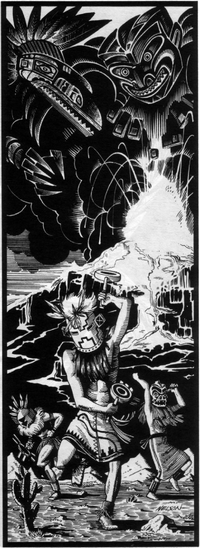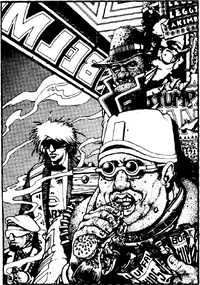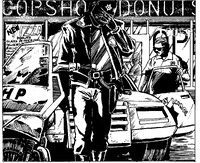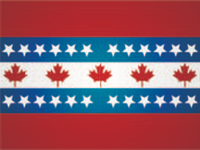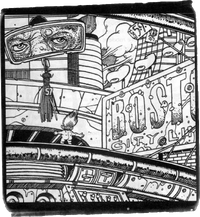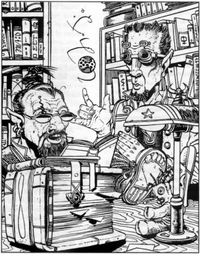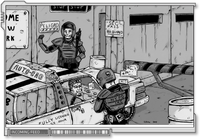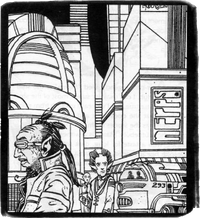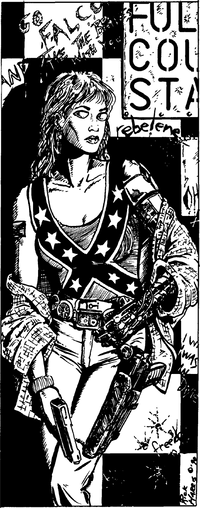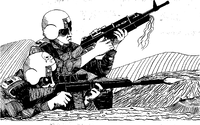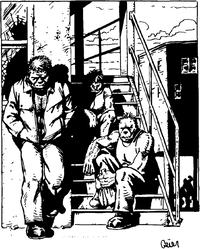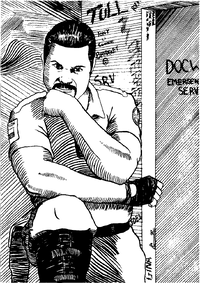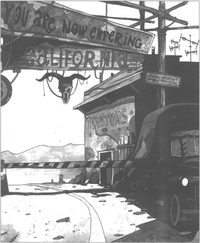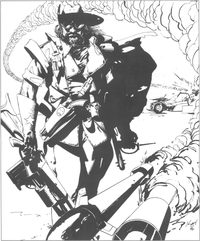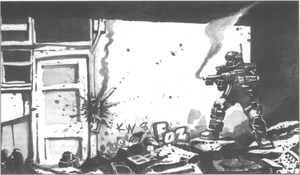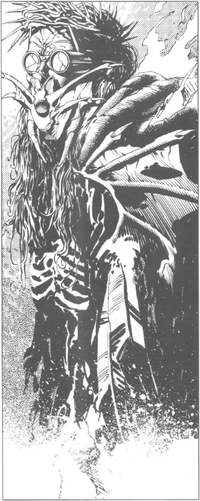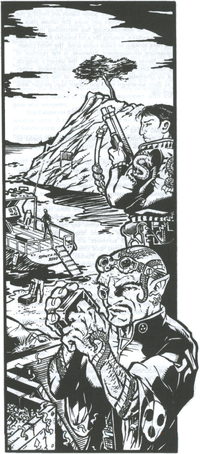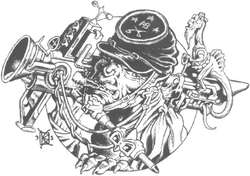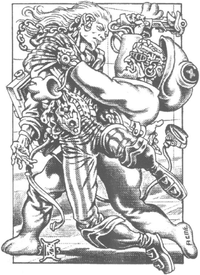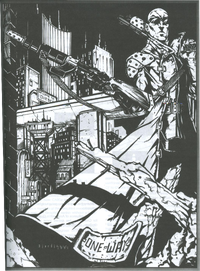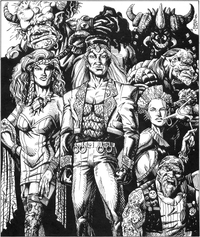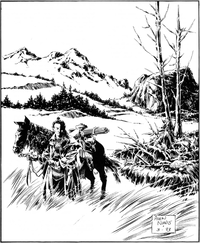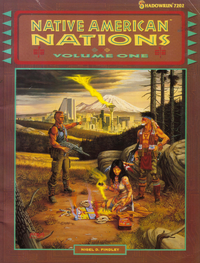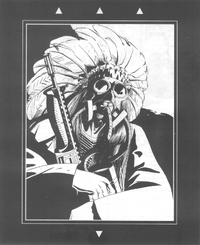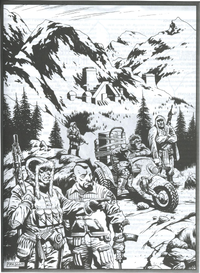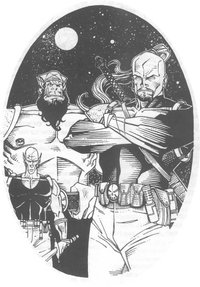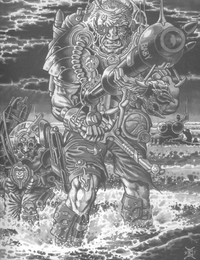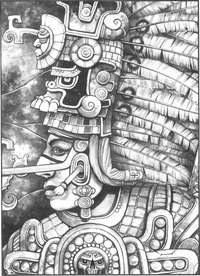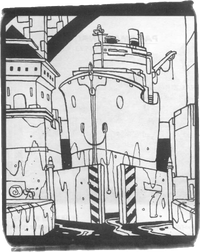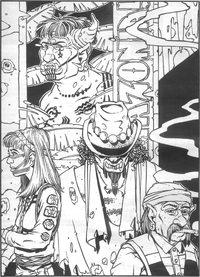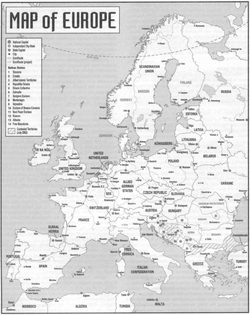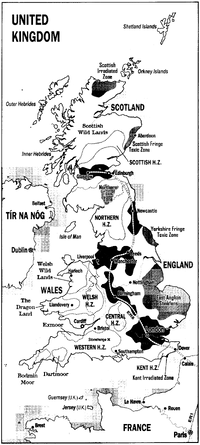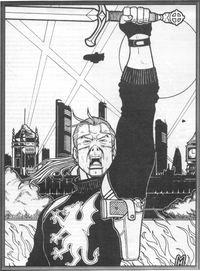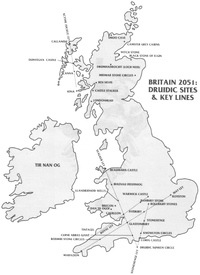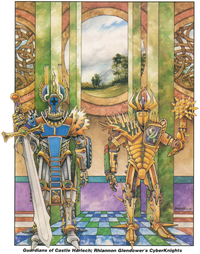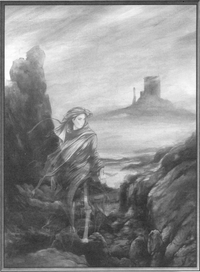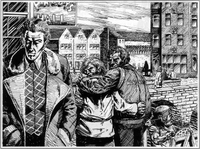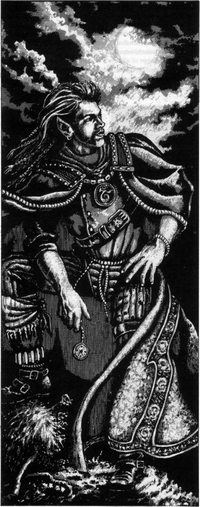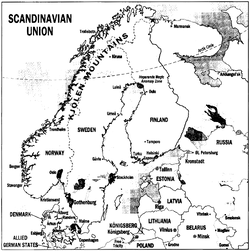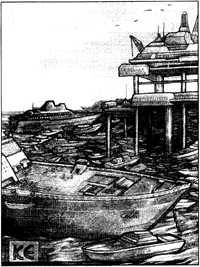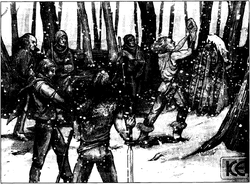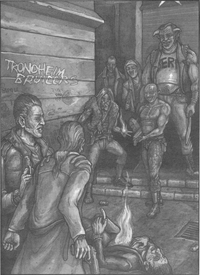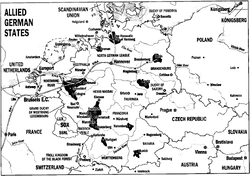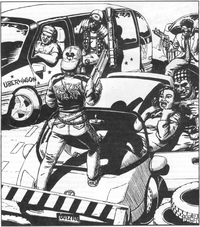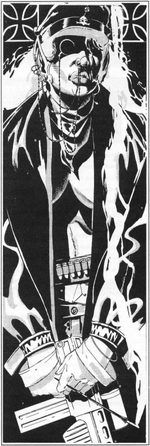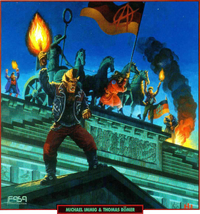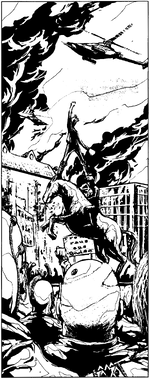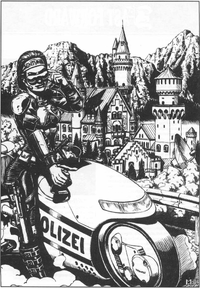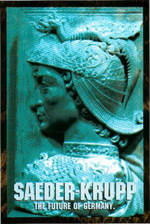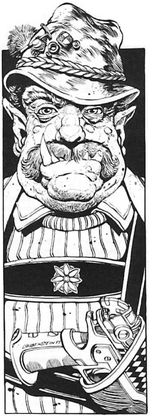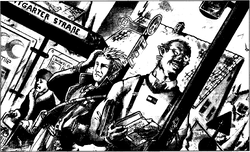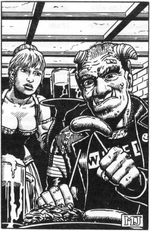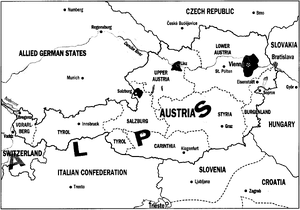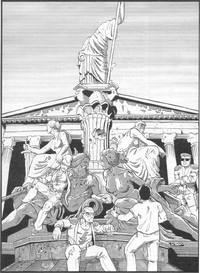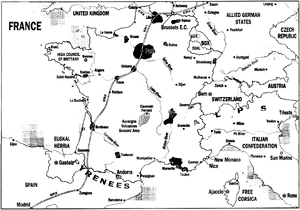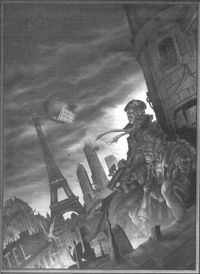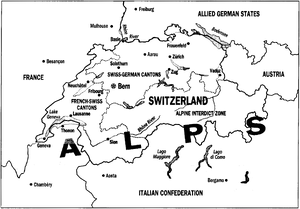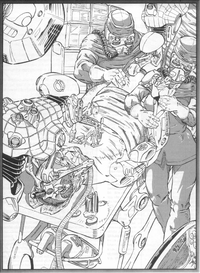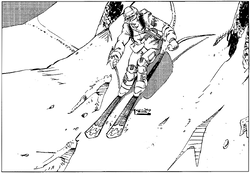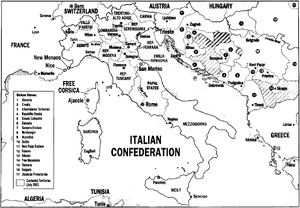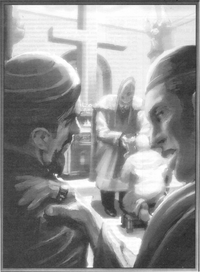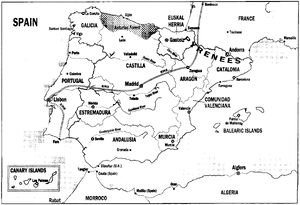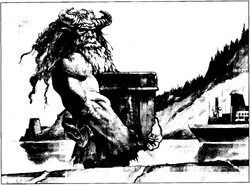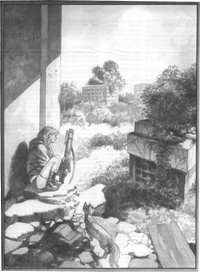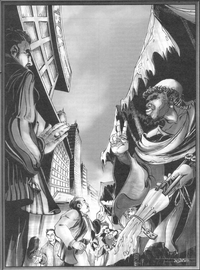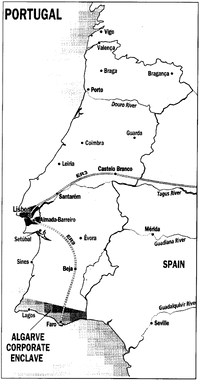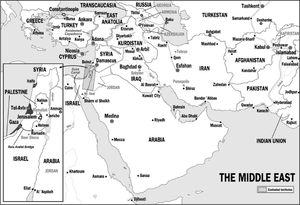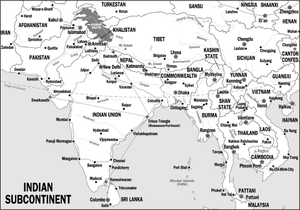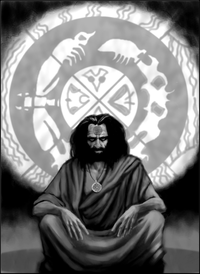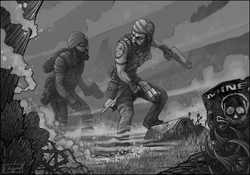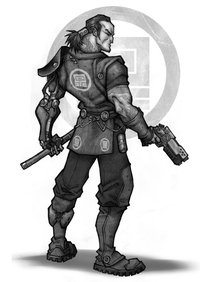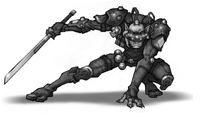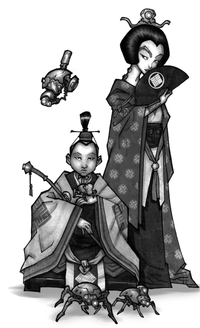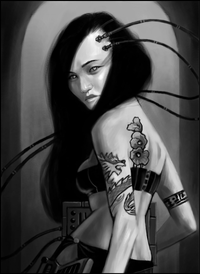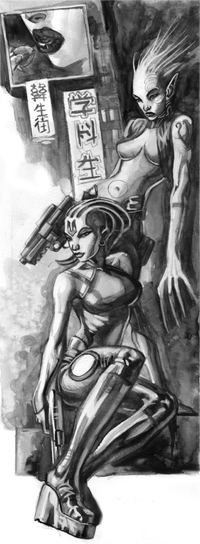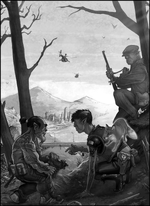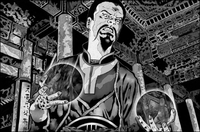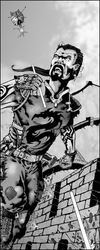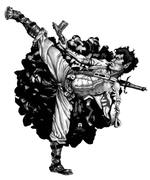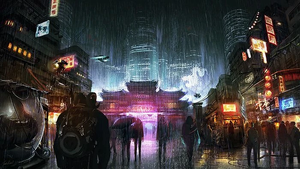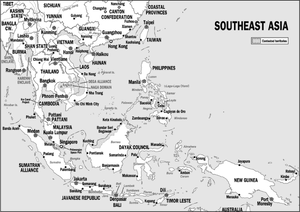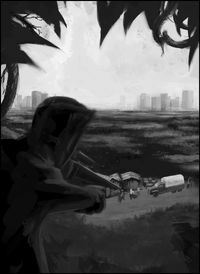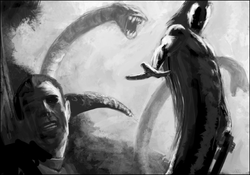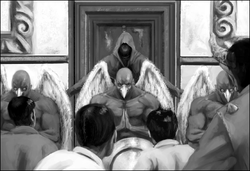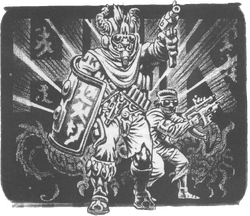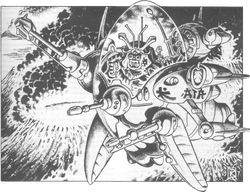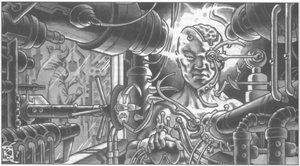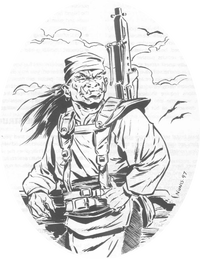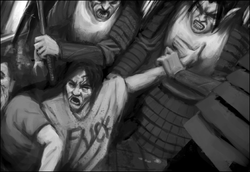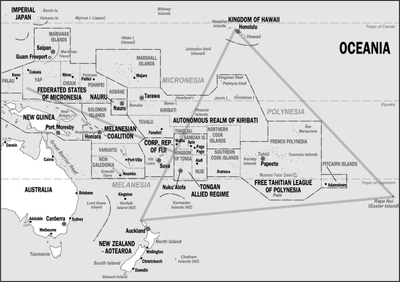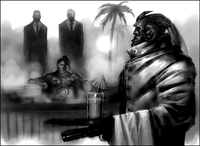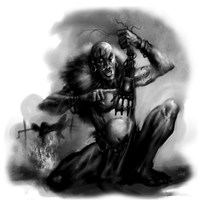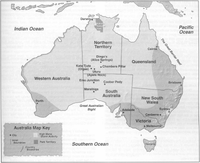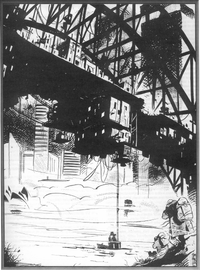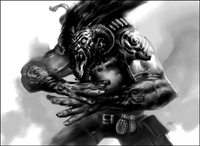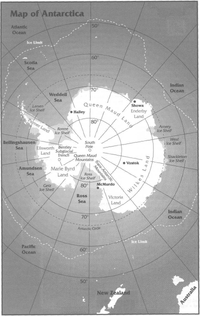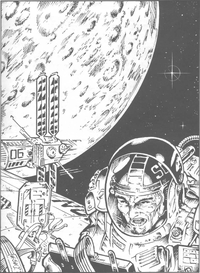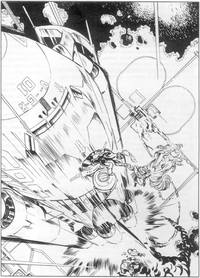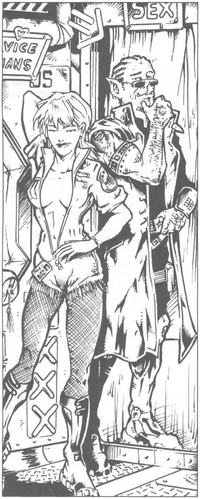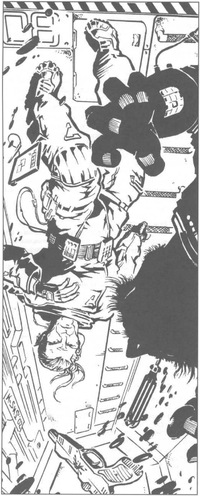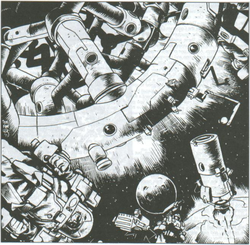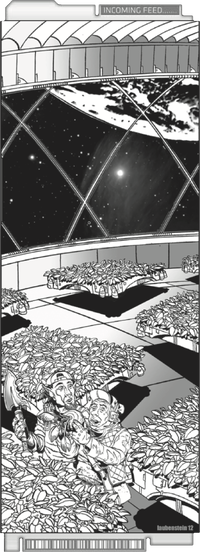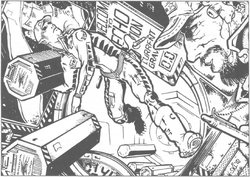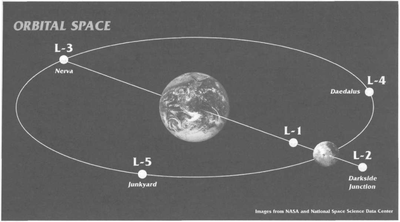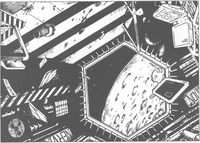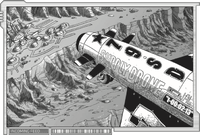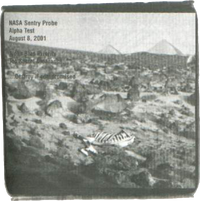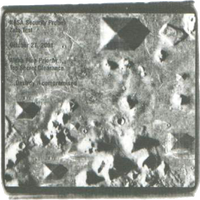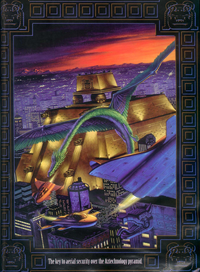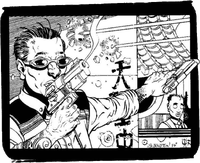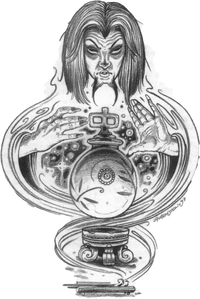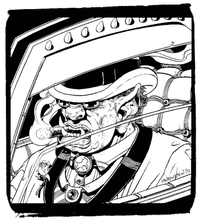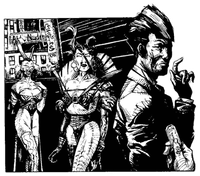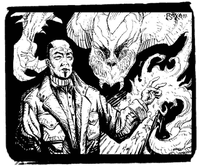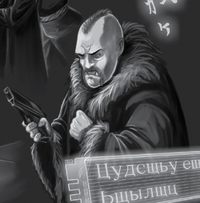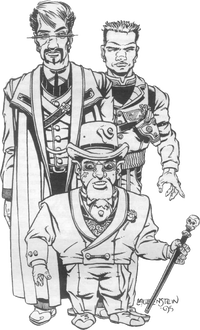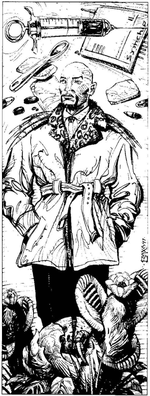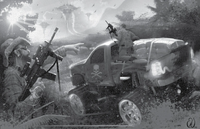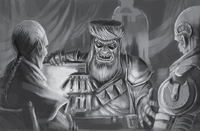Difference between revisions of "The World"
| (129 intermediate revisions by the same user not shown) | |||
| Line 1: | Line 1: | ||
==North America== | ==North America== | ||
[[File:SR1NANVol1_GreatGhostDance.png|right|200px]] | |||
Already reeling from the VITAS plague, the Awakening of magic, and the appearance of metahumans, North America splintered August 17, 2017 when—responding to the United States' escalation of its conflict with Sovereign American Indian Movement into a campaign of outright extinction—Howling Coyote initiated the Great Ghost Dance at Native American communities across the continent. Freak weather and uncanny disturbances assaulted the US military effort, with the havoc reaching its height with the eruption of Mount Hood, Mount Rainier, Mount St. Helens, and Mount Adams. Large portions of the United States and Canada were carved out to form [[#Native American Nations|the Native American Nations]] (NANs). | Already reeling from the VITAS plague, the Awakening of magic, and the appearance of metahumans, North America splintered August 17, 2017 when—responding to the United States' escalation of its conflict with Sovereign American Indian Movement into a campaign of outright extinction—Howling Coyote initiated the Great Ghost Dance at Native American communities across the continent. Freak weather and uncanny disturbances assaulted the US military effort, with the havoc reaching its height with the eruption of Mount Hood, Mount Rainier, Mount St. Helens, and Mount Adams. Large portions of the United States and Canada were carved out to form [[#Native American Nations|the Native American Nations]] (NANs). | ||
Already weakened, the United States and Canada were further destabilized with the Crash of '29, when an unprecedented virus swept the world's computer systems, crashing systems, wiping records, and destroying hardware. In need of a lifeline, they joined together into [[#United Canadian and American States|the United Canadian and American States]] in 2030. The alliance couldn't hold together, however, and the UCAS soon faced a rush of | Already weakened, the United States and Canada were further destabilized with the Crash of '29, when an unprecedented virus swept the world's computer systems, crashing systems, wiping records, and destroying hardware. In need of a lifeline, they joined together into [[#United Canadian and American States|the United Canadian and American States]] in 2030. The alliance couldn't hold together, however, and the UCAS soon faced a rush of secessions. | ||
<br clear=all> | |||
===United Canadian and American States=== | ===United Canadian and American States=== | ||
[https://shadowrun.fandom.com/wiki/United_Canadian_and_American_States The United Canadian and American States], also referred to as the UCAS, is a federal republic in eastern North America, stretching from the Atlantic in the east to the beginning of the Rocky Mountains. It is the successor state to both the Dominion of Canada and the United States of America. It shares land borders with Quebec, Algonkian-Manitou, Sioux, Pueblo, and the CAS. The state of Seattle on the West Coast of North America is enclaved in the Salish-Shidhe territory. | {| border=0 cellspacing=0 cellpadding=10 align=right | ||
|- | |||
|[[File:SR1NAGuidetoNA_Chicago.png|center|200px]] | |||
|- | |||
|[[File:SR1NAGuidetoNA_CopshopDonuts.png|center|200px]] | |||
|} | |||
[https://shadowrun.fandom.com/wiki/United_Canadian_and_American_States The United Canadian and American States], also referred to as the UCAS, CanAmerica, or America, is a federal republic in eastern North America, stretching from the Atlantic in the east to the beginning of the Rocky Mountains. It is the successor state to both the Dominion of Canada and the United States of America. It shares land borders with Quebec, Algonkian-Manitou, Sioux, Pueblo, and the CAS. The state of Seattle on the West Coast of North America is enclaved in the Salish-Shidhe territory. | |||
[[File:SR4SixthWorldAlmanac_UCASFlag.png|left|200px]] | |||
The country consists of 33 states. These include twenty-seven former American states: Connecticut, Delaware, Illinois, Indiana, Iowa, Kansas, Kentucky, Maine (now incorporating formerly Canadian Newfoundland), Maryland, Massachusetts, Michigan, Minnesota, Nebraska, New Hampshire, New Jersey, New York, North Dakota, North Missouri, North Virginia, Ohio, Pennsylvania, Rhode Island, South Dakota, Vermont, West Virginia, and Wisconsin. They further include the five former Canadian provinces of Manitoba, New Brunswick, Nova Scotia (including [[#Prince Edward Island|Prince Edward Island]]), Ontario, and Saskatchewan. The capital, [[#Washington, FDC|Washington, FDC]], was expanded from the American capital of Washington, DC and is now recognized as a state of its own. [[the Seattle Sprawl|The Seattle Special Administrative Region]] is similarly recognized as the state of Seattle. A UCAS citizen is formally known as a Canadian-American, with CanAmerican the acceptable diminutive, but the term American has retained significant global usage due to the dominance of the old USA in the new country and the term Canadian remains proudly claimed by residents of the former provinces. | |||
====Seattle==== | |||
See | [[the Seattle Sprawl|See the dedicated page for the Seattle Special Administrative Region.]] | ||
====Chicago==== | |||
[[Chicago|See the dedicated page for Chicago, including the Chicago Containment Zone (Bug City).]] | |||
====Northeastern Metroplex Axis==== | |||
A megalopolis running along the northeastern coast of the UCAS, collectively referred to as NEMA. Heavily interconnected politically and economically, the region boasts the only high-speed train network in North America. | |||
=====Boston===== | |||
[[File:SR2TargetUCAS_Boston.png|left|200px]] | |||
[[File:SR2TargetUCAS_Boston_MITT.png|right|200px]] | |||
[https://shadowrun.fandom.com/wiki/Boston Boston] is the capital and largest city in Massachusetts. Following the 2005 earthquake, it overcame New York City to become the business and cultural center of NEMA, with a diverse economy including global leadership in finance, education, health care, and technology. It is home to the Massachusetts Institute of Technology and Thaumaturgy (MIT&T), the East Coast Stock Exchange, and the headquarters of the [[#Novatech|Novatech]] AAA megacorporation and the Dunkelzahn Institute of Magical Research. In addition to its old moniker of Beantown, Boston is popularly known as The Hub. | |||
<br clear=all> | |||
=====The Five Boroughs===== | |||
{| border=0 cellspacing=0 cellpadding=10 align=right | |||
|- | |||
|[[File:SR4Manhattan_Checkpoint.png|center|200px]] | |||
|- | |||
|[[File:SR1NAGuidetoNA_NYC.png|center|200px]] | |||
|} | |||
[https://shadowrun.fandom.com/wiki/New_York_City New York City] was devastated by the great earthquake of 2005, with hundreds of thousands dead and hundreds of billions in property damage. While substantially rebuilt over the following decades, it has lost its perceived status as the capital of the world. The five boroughs were re-divided into individual cities while the East Coast Stock Exchange moved to Boston and the United Nations relocated to Geneva, Switzerland. | |||
[[File:SR4Manhattan_NYPDInc.png|left|100px]] | |||
The crown jewel, <span id="Manhattan"></span>'''Manhattan''', was handed over to the megacorps, which jointly rule Manhattan Inc. via their seats on the Manhattan Development Consortium. After the earthquake, the corps rebuilt the island with a series of skyrakers and arcologies reaching high above the old skyline. The island features possibly the heaviest corporate security in the UCAS, restricted not only to SIN-carrying citizens but further by a series of color-coded pass-cards, issued by the municipal government dependent on status as a resident, commuting worker, visitor, government official, VIP, and so on. The pass-cards are frequently checked by various authorities and the penalties are swift and severe if an individual does not present and/or possess an acceptable pass-card. | |||
While only Manhattan is formally under corporate control, their influence has spread throughout the rebuilding of the other four boroughs, now independent cities. <span id="The Bronx"></span>'''The Bronx''' hosts the Villiers Arcology, commonly known as Co-op City, one of the largest condo megaplexes in the world. <span id="Brooklyn"></span>'''Brooklyn''' has seen the formation of the Coney Island Amusementplex, a massive megacorp expansion on the old amusement parks. Astoria in <span id="Queens"></span>'''Queens''' features the largest simsense production center in the UCAS, the heart of the UCAS immersion industry since the secession of [[#California Free State|California]] and the quarantining of the [[Chicago|Chicago Containment Zone]]. Of the old outer boroughs, <span id="Staten Island"></span>'''Staten Island''' is the least changed, functioning as a relatively-affordable suburb of the other cities. | |||
=====Philadelphia===== | |||
[[File:SR4RunnerHavens_TaxiDriver.png|right|200px]] | |||
[https://shadowrun.fandom.com/wiki/Philadelphia Philadelphia] has retained much of its original character from before the Awakening, adapting smoothly to the new world. The city sees investment by a number of AAA megacorporations, remains fiercly loyal to and critical of its many sports teams, and hosts the headquarters of the Humanis Policlub human supremacist organization. | |||
=====Washington, FDC===== | |||
[https://shadowrun.fandom.com/wiki/Federal_District_of_Columbia Washington, FDC], officially the Federal District of Columbia and commonly known as DC, is the capital city and administrative district of the United Canadian and American States. It comprises the territory of the old American capital of Washington, DC plus the counties of Montgomery, Prince Georges, Howard, Arlington, Alexandria, and Fairfax, creating a state from much of the historically recognized National Capital Region. | |||
<br clear=all> | |||
====Detroit==== | |||
[[File:SR2TargetUCAS_Detroit.png|right|200px]] | |||
[https://shadowrun.fandom.com/wiki/Detroit Detroit] or the Greater Detroit Metropolitan Complex is located in the state of Michigan, in the UCAS. Site of the global headquarters for [[#Ares Macrotechnology|Ares Macrotechnology]], parent company of Knight Errant Security Services, Detroit is prosperous and one of the safest cities in the UCAS. It is held up as a model of balanced civic and corporate governance, with a mere three percent unemployment rate according to the 2050 census. | |||
====Toronto==== | |||
[https://shadowrun.fandom.com/wiki/Toronto Toronto], Ontario, on the northern shore of Lake Ontario, is one of the cleanest and safest cities in the UCAS and has a long-standing reputation for being a decent place to live. | |||
Toronto is the entertainment capital of the UCAS. Having served as the ‘stunt double’ for other city locations, particularly New York, for years, when the UCAS lost California and Nashville, and most of its major film and television industry, New York and Toronto tried to take up the slack. With the damage to New York in the 2005, Toronto proved the better venue for most entertainment corps, which bought up land and set up facilities here. Some are just subsidiaries of California Free State corporations, giving them a presence in the UCAS, while others are independent or belong to one of the megacorps. Vision-Quest, NBS, Mediaworks, Brilliant Genesis, and others maintain studios here. | |||
====Prince Edward Island==== | |||
PEI drew the nation's attention for the first time in the 21st century when Dunkelzahn established his residence there, enabling his UCAS citizenship and eventual run for president. Following his death in 2057, his estate on the island was left in a trust dedicating it as a public park for use by the people of the UCAS. The site has drawn the devotion of many of his faithful, including such cults as the Children of the Dragon. | |||
===Confederation of American States=== | ===Confederation of American States=== | ||
[https://shadowrun.fandom.com/wiki/Confederation_of_American_States The Confederation of American States], abbreviated as the CAS, and sometimes referred to as the Confederated American States, is a republic in eastern North America, stretching from the Atlantic in the east to the beginning of the Sierra Madre. It shares land borders with UCAS, Pueblo, | [[File:SR1NAGuidetoNA_CAS.png|right|200px]] | ||
[https://shadowrun.fandom.com/wiki/Confederation_of_American_States The Confederation of American States], abbreviated as the CAS, and sometimes referred to as the Confederated American States, is a republic in eastern North America, stretching from the Atlantic in the east to the beginning of the Sierra Madre. It shares land borders with UCAS, Pueblo, Aztlán, and South Florida. | |||
The country has 13 states, which have a level of local autonomy according to the system of federalism. A CAS citizen is formally known as a Confederationist, but much of the world knows them as Confederates. While much of the country itself embraces the term, a minority of it, and many expatriates, consider it an insult, given its association to the moniker used in the American Civil War. | |||
While marginalization of metahuman populations is common globally, the CAS has a reputation for the extremity of their subjugation, with the non-human portion of its prisoners being vastly higher than the already-common disproportion and prison labor being highly integrated into the national economy. | |||
====Atlanta==== | |||
[https://shadowrun.fandom.com/wiki/Atlanta Atlanta] is the capital of Georgia and the CAS in general. While the third largest metropolitan area in the CAS, behind Dallas/Fort Worth and Houston in Texas, it sees significant economic activity outside political administration. Major megacorporations headquartered in Atlanta include Hisato-Turner Broadcasting, Cord Mutual, DocWagon, Coca-Cola, Shaw Textiles, Global Business Computers, and the Atlantean Foundation. Many foreign corporations also install their CAS division HQ in Atlanta. The Georgia Institute of Technology (Georgia Tech) has achieved significant renown in the field of magical studies. | |||
====Dallas/Fort Worth==== | |||
{| border=0 cellspacing=0 cellpadding=10 align=right | |||
|- | |||
|[[File:SR1NAGuidetoNA_DFW.png|center|200px]] | |||
|- | |||
|[[File:SR1NAGuidetoNA_DFW2.png|center|200px]] | |||
|- | |||
|[[File:SR1NAGuidetoNA_DFW3.png|center|200px]] | |||
|} | |||
[https://shadowrun.fandom.com/wiki/Dallas/Ft._Worth The Dallas/Fort Worth metroplex] is the second most influential sprawl in the CAS, second only to Atlanta. The population of the city swelled tremendously following the invasion by Aztlán in 2035, mostly with Houston refugees, but also with a sizable number of Aztlán immigrants. The city was already on the edge of breakdown, but the influx of refugees pushed the services of the city to the breaking point. It is only within the past 15 or 20 years that DFW has managed to get a handle on its problems and emerge as a cultural and economic powerhouse in the CAS. | |||
Socially, there are three dominant factors in DFW society: | |||
* Firstly is the sizable Aztláner population, which forms upwards of 40% of the populace of the city. Confined to low-cost regions of the city, these de facto ghettoes have created a vibrant social scene in the city, which is becoming world renowned as the place to go for Mexican music and dance. It is part of their cultural identity that they are not Aztláner, but Mexican (or Latino), and calling someone an Aztláner is considered offensive and can be grounds for violence – at least for some. | |||
* Then there are the associated tensions with the Aztlán government itself (or rather, Aztechnology). Anti-Aztláner paranoia is rampant, and is used to justify much discrimination against the Aztláners, and is the source of much violence within the Mexican/Latino community as well. The problem is complicated by an explicit policy of helping refugees flee Aztlán combined with a propensity for the Aztlán intelligence service to send agents disguised as refugees. There is a significant fear that Aztlán may be planning to start an insurgent campaign in DFW as a prelude to invasion – a fear stoked by the occasional terrorist bombing. Then again, the CAS and various refugee groups are trying to do the same thing to Aztlán. | |||
* Lastly is the rather significant gap between the rich and poor within the sprawl, which manifests in a number of different ways. The small middle class is largely human, corporately affiliated, and rarely leave their gated enclaves. Lower class consists of a mix of Aztláner immigrants, poor Texans displaced by the Aztlán annexation, and a disproportionate number of metahumans (particularly orcs). The upper class consists of a mix of wealthy Aztláner aristocrats, upper crust CAS natives, and the social "glitterati" that dominate the DFW social scene. | |||
<br clear=all> | |||
===California Free State=== | ===California Free State=== | ||
[https://shadowrun.fandom.com/wiki/California_Free_State The California Free State] is a libertarian republic on the west coast of North America. California borders the Pacific Ocean the length of the Sierra Nevada, featuring a diverse landscape and Mediterranean climate. The CFS comprises only a portion of the former state of California, with the territory from San Diego south claimed by | [[File:SR2CFS.png|right|200px]] | ||
[https://shadowrun.fandom.com/wiki/California_Free_State The California Free State] is a libertarian republic on the west coast of North America. California borders the Pacific Ocean the length of the Sierra Nevada, featuring a diverse landscape and Mediterranean climate. The CFS comprises only a portion of the former state of California, with the territory from San Diego south claimed by Aztlán, Los Angeles having succeeded, and San Francisco—while still formally part of the CFS—being in practice controlled by a coalition of Japanese megacorporations. | |||
<br clear=all> | |||
====Northern Crescent==== | |||
[[File:SR2CFS_NorthernCrescent.png|right|200px]] | |||
The Northern Crescent, a mountainous region of California which borders Tír Tairngire, is home to the world's largest redwood old growth forest and has long been a target of the Tír elves. Much of this land was captured by them in the 2036 war, but guerrilla activity has kept the Tír from holding it safely. As such, the disputed territory is a constant see-saw battle of California Irregulars and Tir Paladins. The border is still porous and fluid, with lines changing from week to week. | |||
The great dragon Hestaby makes her home on Mount Shasta in the Northern Crescent. She has mostly kept out of the border dispute. | |||
<br clear=all> | |||
====San Francisco==== | |||
[[File:SR2CFS_BayArea.png|right|300px]] | |||
[https://shadowrun.fandom.com/wiki/San_Francisco San Francisco] is a metroplex in the Bay Area of the California Free State, which has been under military occupation by the [[#Japanese Imperial State|Japanese Imperial State]] since 2036 when it invaded the city to protect Japanese corporate interests during the breakup of the United States. Administered under military law, access to the city requires a SIN or other authorization acceptable to the Japanese Imperial Marines. All five Japanese megacorporations maintain a major presence in the city. | |||
The larger Bay Area remains independent from Japanese control and has become a haven for metahumans expelled from the Japanese enclave. The People's University in Berkeley has produced a steady stream of notable shadowrunner deckers since its inception. | |||
<br clear=all> | |||
====Big Sur==== | |||
[[File:SR2CFS_BigSur.png|right|200px]] | |||
In the north the local water table has been rendered undrinkable by agribusiness, making the area a sparsely-populated toxic wasteland. Black and twisted plants, some of which move and hunt. In the south, towns and military bases abandoned during the breakup of the USA were taken over by gangs forced out of SF by the Japanese military. | |||
There’s small farming communities dotted along the Salinas and Carmel rivers, these areas purified by powerful nature magic. The state governments unleashed the megacorp agribusinesses to take back the now-again productive land, but the same magic used to clean it was unleashed on them, leading to a long stalemate. | |||
Massive aquaculture takes place off the coast growing genetically-engineered seafood in waters that have to be constantly protected from their toxic byproducts by powerful magic. The biggest of these is Kalamri Incorporated, whose aquasphere is a self-contained city in the shallow coastal waters that can hold up to 15,000. The smallest notable one is Aqua Arcana, specializing in magical management of the local wildlife. | |||
The southern portion of Big Sur is a pirate haven, the big three pirate kingdoms being O’Malley’s Empire, Monday of Morro Bay, and the Dread Pirate Paco. However, independent troops control a number of former military reservations. | |||
<br clear=all> | |||
====Mojave==== | |||
[[File:SR3ShadowsofNorthAmerica_Mojave.png|right|200px]] | |||
The Mojave covers a vast stretch of southeastern California. It's bordered by the Iny Forest on the north, Aztlán on the south, the Ute Nation on the east, and the Sierra Nevada mountains on the west. The California Rangers keep up with fixing potholes pretty well, but no one's resurfaced the roads in decades. Visitors are advised to use a hovercraft or something with four-wheel drive. | |||
<blockquote>''If you're a typical shadowrunner—somebody who eats, sleeps and breathes the sprawl—you'd best not come to the Mojave Desert without a fragging good reason. And if you do come here, read up on the place first. Aside from the few habitable towns scattered within it, the Mojave is an alien environment. It's a place of extremes, where relying on anything or anyone except yourself can kill you. At one end of the spectrum lies the corporate resort of Palm Springs, a monument to the power of corp money and technology. Here, richer-than-God execs and their friends cavort in air-conditioned splendor, insulated from the realities of everyday fiel by the best entertainment, food and assorted luxuries money can buy. Outside the fortified walls of Palm Springs lies the open desert, a harsh and unforgiving place. There aren't too many spots in it fit for (meta)humans to live, other than the military town of Barstow and a few scattered corporate military bases. There sure as drek isn't anyplace like the sprawl you're likely used to. No glass towers, no Stuffer Shacks, no climate-controlled shopping arcologies. The desert si its own world—a world of strange magical creatures, fierce nomadic bands, solitary shamans and powerful magical sites, where only the strong and cunning survive.''<br>— Road Runner</blockquote> | |||
<br clear=all> | |||
===Free City of Los Angeles=== | ===Free City of Los Angeles=== | ||
[[File:SR2CFS_LosAngeles.png|left|250px]] | |||
[[File:SR2CFS_LosAngeles_FunCity.png|right|200px]] | |||
Enclosed on land by the California Free State, [https://shadowrun.fandom.com/wiki/Los_Angeles The Free City of Los Angeles] sprawls across what used to be the Los Angeles, Riverside, and Orange counties, and additionally includes the western part of San Bernardino county. The free city is best known for its still-dominant position in the entertainment industry, ranging from film and TriD to simsense recordings and video games. | Enclosed on land by the California Free State, [https://shadowrun.fandom.com/wiki/Los_Angeles The Free City of Los Angeles] sprawls across what used to be the Los Angeles, Riverside, and Orange counties, and additionally includes the western part of San Bernardino county. The free city is best known for its still-dominant position in the entertainment industry, ranging from film and TriD to simsense recordings and video games. | ||
Moneyed Angelenos live in a select few scattered sanctuaries across the L.A. sprawl: Hollywood, Mulholland Drive, Westside, the UCLA campus and its immediate environs, and the corporate enclaves of Fun City and Studio City, each walled off from the sea of urban blight surrounding it by heavily-manned fortifications. | |||
Studio City includes West Hollywood, Universal City and Beverly Hills, named for the many video, trideo and simsense studios there, plus all the necessary supporting industries. Those visitors allowed inside the walls will find such classic old-Hollywood tourist attractions as the Walk of Fame, Griffith Park, Universal Studios, Man's Chinese Theatre, and the Hollywood Wax Museum. Senior studio executives, major performers, and senior technicians and support personnel live inside the walls of the city itself, while the less important commute from nearby communities. | |||
A collection of corporate interests, Fun City is a gigantic family-friendly amusement park that includes Virtual Disney, the Crystal Cathedral, Knott's Berry Farm, as well as a variety of newer additions. While it includes parks from a number of distinct corporate interests, management of Fun City is dominated by Amalgamated Studios, the largest player in the Los Angeles entertainment industry. | |||
<br clear=all> | |||
===Republic of Québec=== | ===Republic of Québec=== | ||
[[File:SR3ShadowsofNorthAmerica_Quebec.png|right|200px]] | |||
[https://shadowrun.fandom.com/wiki/Republic_of_Qu%C3%A9bec Québec], officially la République du Québec (English: Republic of Québec) is a country in eastern North America, between Hudson Bay and St-Laurent River, with its capital in Québec city. A socialist republic, it is traditionally an isolationist nation known for its fervently Francophone population and strict laws outlawing the use of other languages. Its economic face is the AAA megacorporation Cross Applied Technologies, though all AAA megacorporations maintain some presence in the republic. It shares land borders with the UCAS and the Algonkian-Manitou Council. | |||
<br clear=all> | |||
===Tír Tairngire=== | ===Tír Tairngire=== | ||
{| border=0 cellspacing=0 cellpadding=10 align=right | |||
|- | |||
|[[File:SR2TírTairngire_Society.png|center|200px]] | |||
|- | |||
|[[File:SR2TírTairngire_Geography.png|center|200px]] | |||
|} | |||
[https://shadowrun.fandom.com/wiki/Tir_Tairngire Tír Tairngire] (Gaelic for "Land of Promise") is one of the two Tír Nations (see [[#Tír na nÓg|Tír na nÓg]]), elven ethnostates established after the Awakening. Tír Tairngire comprises most of the former American state of Oregon as well as a portion of Nevada, while contesting territory in northern California. | |||
Established initially as one of the Native American Nations, Tír Tairngire soon transitioned from a home for elven Native Americans to a refuge for elves from across the Americas, whether or not they possessed Native American lineage. It is ruled by the Council of Princes, an eleven-member body forming the high aristocracy of the state. The original members were appointed by Lugh Surehand, the founding High Prince, with replacements selected from the social and economic elite of the elven nation. The council includes one non-elven member, the great dragon Lofwyr. | |||
Tír Tairngire did not sign the Business Recognition Accords. As such, megacorporations can only operate in Tír Tairngire through subsidiaries which do not enjoy extraterritoriality. Further, by law, the Council of Princes as a collective owns at least 5% of each such subsidiary and the head corporate officer must be a Tír subject, barring special dispensation by the Council. | |||
Tír Tairngire security is provided by the Tir Tairngire Peace Force, a combined military and national police force. Its special forces are referred to as Paladins, which include the feared Ghost Circle, an initiatory circle of magically-adept warriors. | |||
<br clear=all> | |||
===Native American Nations=== | ===Native American Nations=== | ||
[[File:SR1NANVol1_Cover.png|right|200px]] | |||
[https://shadowrun.fandom.com/wiki/Native_American_Nations The Native American Nations (NAN)] is a union of Native American countries in North America. These include: | |||
* Algonkian-Manitou Council | |||
* Athabaskan Council | |||
* Pueblo Corporate Council | |||
* Salish-Shidhe Council | |||
* Sioux Nation | |||
* Ute Nation | |||
* Trans-Polar Aleut Nation | |||
* Tsimshian Nation | |||
====Denver==== | ====Denver==== | ||
[https://shadowrun.fandom.com/wiki/Denver Denver] was where the agreement establishing the North American Nations was signed, | [[File:Denver-TheCityofShadows2.png|right|200px]] | ||
[https://shadowrun.fandom.com/wiki/Denver Denver] was where the agreement establishing the North American Nations was signed. It and its surrounding territory form the Front Range Free Zone, a formally sovereign state governed by the Council of Denver, though highly subject to the whims of its controlling members. It is governed under the joint administration of these members, which comprise the five signatories of its creation (the UCAS, Aztlán, the Pueblo, the Sioux, and the Ute) and the CAS, which gained membership following its secession from the UCAS in 2034. Each of these parties controls a sector of the city, forming a series of wedges around the core Joint Administrative District, the CAS sector splintered from the territory of the UCAS. | |||
Besides being a center for work in the Native American Nations, Denver is famous among shadowrunners for the Denver Nexus, the largest data haven in the world and home of the central node of the Shadowland BBS, the main hub of the North American online shadow community. | |||
====Salish-Shidhe Council==== | |||
{| border=0 cellspacing=0 cellpadding=10 align=right | |||
|- | |||
|[[File:SR1NANVol1_Salish-ShidheCouncil.png|center|200px]] | |||
|- | |||
|[[File:SR3ShadowsofNorthAmerica_Salish-ShidheCouncil.png|center|200px]] | |||
|} | |||
Among all of the NAN, the [https://shadowrun.fandom.com/wiki/Salish-Shidhe_Council Salish-Shidhe Council] is the most tribally-oriented, and their population and politics are segregated according to tribal affiliation. Each tribe sends representatives to the Tribal Council, and aside from a few nationwide civil laws and restrictions, each tribe is autonomous and self-governing. | |||
The major tribes are: | |||
* Salish – The most dominant and prosperous tribe. Tribal territory includes most of the land west and south of Puget Sound. | |||
* Makah – The most military assets of all the tribes. Tribal territory is the northwest Olympic peninsula. | |||
* Cascade Crow – Tribal territory is the land between Seattle and the Cascade mountains, as well as Vancouver. Strongly anti-Anglo. | |||
* Sinsearach – Predominantly elven and eco-conscious. Tribal territory is the land southwest of Seattle, including Mt. Rainier. | |||
* Cascade Ork – Predominantly ork and troll tribe with tribal territory in the Cascade Mountains. | |||
* Nootka – Anti-technology traditionalists who have a presence in northwest Washington, Vancouver Island, and Prince George. | |||
Other tribes include the Musqueam, the Squamish and several "pinkskin" tribes. | |||
Among the megacorporations, only a few extraterritorial agreements have been reached with the SSC, simply because most tribes are not willing to part with the land. Most of the AAA megacorporations make do with offices in Seattle instead. | |||
While technically part of the UCAS, the [[The_World#Seattle|city/state of Seattle]] is surrounded by the SSC. The Council keeps a Seattle embassy on [[The_Seattle_Sprawl#Council_Island|Council Island]]. | |||
There's very little presence by the international criminal syndicates in the Salish-Shidhe Council. Local crime outfits are merely those from the Tsimshian Protectorate, especially the Dogmen. | |||
<br clear=all> | |||
The country of | ==Latin America== | ||
===Caribbean League=== | |||
{| border=0 cellspacing=0 cellpadding=10 align=right | |||
|- | |||
|[[File: SR2Cyberpirates_CaribbeanLeague2.png|center|200px]] | |||
|- | |||
|[[File: SR2Cyberpirates_CaribbeanLeague.png|center|200px]] | |||
|} | |||
[https://shadowrun.fandom.com/wiki/Caribbean_League The Caribbean League] is a political union of Carribean nations established as a collective check against the ability of megacorporations to dominate any of its constituent members. Founded in 2022 by the First Secretary of the Neo-Communist Party of Cuba Lady Guadalupe Martinez, its presidency is now held by her son Enrique "Pretty Boy" Martinez, who has been responsible for controversial overtures to megacorporate investment. The league comprises the federated states of: | |||
* Cuba | |||
* [[#South Florida|South Florida]] | |||
* [[#Borinquen (Puerto Rico)|Borinquen (Puerto Rico)]] | |||
* The Bahamas | |||
* Cayman Islands | |||
* Jamaica | |||
* Haiti | |||
* The Dominican Republic | |||
* Virgin Islands | |||
* Anguilla | |||
* Saint Kitts and Nevis | |||
* Antigua and Barbuda | |||
* Guadeloupe | |||
* Dominica | |||
* Martinique | |||
* Saint Lucia | |||
* Saint Vincent and the Grenadines | |||
* Grenada | |||
* Trinidad and Tobago | |||
* Aruba | |||
* Netherlands Antilles | |||
* Curacao | |||
Bermuda and Barbados are still British overseas territories and as so are not part of the League. | |||
The Caribbean League is famous for its tolerance to piracy, with multiple states governed by former or active pirate lords. Criminal syndicates operate alongside the pirates without significant interference, most notably the South American [[#Ghost Cartels|Ghost Cartels]]. | |||
====South Florida==== | |||
[https://shadowrun.fandom.com/wiki/South_Florida South Florida] joined the Caribbean League in 2034 shortly after the CAS split off from the UCAS and consists of Miami-Dade County, Monroe County, the eastern edge of Broward County, the south-eastern edge of Collier County, and the south-eastern corner of Palm Beach County (including Boca Raton, but not West Palm Beach). The border was set by CAS when they quickly built the "orange curtain" across the peninsula in 2034. | |||
=====The Miami Sprawl===== | |||
The Miami Sprawl, while still part of South Florida, is entirely controlled by the Gunderson AA megacorporation. Gunderson is a diversified company with considerable investment in manufacturing, shipping, and security personnel, with subsidiaries including TransSea (shipping division), Atlantic Security, and Montclair Industries (specializing in advanced drones). Gunderson is rumored to be fully integrated with the [[#Mafia|American Mafia]], particularly the Cuban and Puerto Rican gangs folded into La Cosa Nostra during the aftermath of the Awakening. | |||
====Borinquen (Puerto Rico)==== | |||
Borinquen (formerly Puerto Rico) seceded from the United States in 2032 to join the Caribbean League, renaming itself Borinquen, the named used for the island by the Taíno-Kalipona people indigenous to the Lesser Antilles. It is loosely ruled by the Pirate Queen Maria Fransisca, who maintains the island as a megacorp-free zone. | |||
===Aztlán=== | |||
[[File:SR2Aztlán_Page9.png|right|200px]] | |||
One of the Native American Nations created in the wake of the Great Ghost Dance, [https://shadowrun.fandom.com/wiki/Aztlan Aztlán] covers all of Central America, between Rio Bravo and Nueces River and the Andes, including the former territory of Mexico, Belize, Costa Rica, El Salvador, Guatemala, Honduras, Nicaragua, and Panama (excluding the Panama Canal Zone under the direct control of the Corporate Court). It also includes territory that used to belong to Venezuela and Columbia, as well as portions of the former US states of Texas, New Mexico, Arizona, and California. | |||
The country of Aztlán is inextricable from [[#Aztechnology|Aztechnology]]. The AAA megacorporation dominates politics with its Azatlán party, intermingling its corporate governance with the national government, while also being the primary provider of security and military services to the state. The nation and corporation are notorious for their use of blood magic. | |||
<br clear=all> | |||
===Panama Canal Zone=== | ===Panama Canal Zone=== | ||
= | [[File:SR2Aztlán_PanamaCanal.png|right|200px]] | ||
When the country of [https://shadowrun.fandom.com/wiki/Panama Panama] joined Aztlán in 2048, the Corporate Court wrested control of the Panama Canal Zone from the expansionist state as part of [https://shadowrun.fandom.com/wiki/Operation_RECIPROCITY Operation RECIPROCITY], launched by the other members of the Court to check Aztechnology's flouting of corporate law. The Panama Canal Zone grants control of the canal and its surrounding environs to the Corporate Court directly. | |||
Administered by an appointed governor, the Panama Canal Zone has no army or security force of its own. Instead, the Corporate Court provides troops to defend it as needed, sourced from its constituent members. Those aboard a ship traversing the canal will find along the shores a mix of uniforms, from the red-and-navy of Renraku and the pale blue of Mitsuhama to the grays of Fuchi and the jade green of Yamatetsu. The dusty ochre of Aztechnology is missing, however, as the Corporate Court declines to include their forces among those used to control the Pan-Corporate Zone. | |||
<br clear=all> | |||
===Amazonia=== | ===Amazonia=== | ||
==Europe== | [[File:SR2Aztlán_Amazonia.png|right|200px]] | ||
[https://shadowrun.fandom.com/wiki/Amazonia Amazonia (port. Amazônia)] is a major country located in the northeast of South America, comprising the territory of the former nation of Brazil as well as significant territory that used to belong to Venezuela (the remainder claimed by Aztlán or forming a small rump state enclaved within Amazonia) and the portion of Colombia not claimed by Aztlán. | |||
Amazonia was formed in 2034 when revolutionary forces, led by the great dragons Hualpa, Sirrurg, and Arleesh, took the capital of Brazil. The feathered dragon Hualpa has served as Prime Minister of the state ever since, his Amazonian party forming a majority every election either independently or in coalition with one or more minority parties. The state has overseen comprehensive environmental reclamation, with the Amazonian jungle in particular seeing strong regrowth. The largest urban area, called the Metropole or "Rio Paulo" unites the cities of São Paulo and Rio de Janeiro, though the capital remains in Brasilia. | |||
Tensions have been high between Aztlán and Amazonia for some time. The last open military conflict was in 2049 when Aztlán claimed a portion of Venezuela, but diplomatic and public relations remain tense with ongoing minor border conflicts. | |||
Amazonia has not signed the Business Recognition Accords, denying megacorporations their typical extraterritoriality. Aztechnology is banned from conducting business in the country altogether. | |||
==Western Europe== | |||
[[File:SR3ShadowsofEurope_EuropeMap.png|right|250px]] | |||
The late 20th and early 21st century saw the rise and fall of unity in Europe. An economically ascendent Western Europe formed a European Union, then proceeded to be hollowed out from within: public services privatized, the people disengaged from civic life, and the growth of industrial toxic zones. Economic recession, the Awakening, goblinization, Russian expansionism in the east, each ratcheted up panic that the EU proved unable to control. The panic led to chaos, conflict, and the eventual unwinding of the EU. While a number of once-again independent countries have rebuilt themselves, Western Europe remains a place of considerable turmoil. | |||
<br clear=all> | |||
===United Kingdom=== | ===United Kingdom=== | ||
[https://shadowrun.fandom.com/wiki/United_Kingdom United Kingdom] | [[File:SR3ShadowsofEurope_UnitedKingdomMap.png|left|200px]] | ||
{| border=0 cellspacing=0 cellpadding=10 align=right | |||
|- | |||
|[[File:SR3ShadowsofEurope_UnitedKingdom.png|center|200px]] | |||
|- | |||
|[[File:SR1London_LeyLines.png|center|200px]] | |||
|- | |||
|[[File:SR1London_CyberKnights.png|center|200px]] | |||
|} | |||
The [https://shadowrun.fandom.com/wiki/United_Kingdom United Kingdom] is a constitutional monarchy off the coast of continental European. Since the 2014 Act of Dissolution and Treaty of Galway, which reunified Ireland and ultimately led to the creation of [[#Tír na nÓg|Tír na nÓg]], the country of the United Kingdom and the island of Great Britain are effectively synonymous. | |||
The UK is no longer the global colonial power it once was, but it has maintained a position of considerable influence as an island of stability compared to the chaos of the mainland. Many global corporations run their European operations out of the UK, often in London, a city long accustomed to serving as a hub of commerce and diplomacy. It is home to the influential AA megacorporation Transys Neuronet, headquartered in Edinburgh, a pioneer in Matrix technology and the development of cyberware and bioware. Backed by the great dragon Celedyr, it has been researching cyberware for dragons, an effort accelerated by the following entry in Dunkelzahn's will: | |||
<blockquote>To the first party to develop an efficient and effective Matrix connection for dolphins, elephants and/or satyrs, and dragons, I leave the access codes to four Zürich-Orbital accounts and a personal visit from Lofwyr.</blockquote> | |||
The United Kingdom's head of state is a monarch, currently King George VIII. King Charles III abdicated following the death of his two elder sons, William and Harry, in a plane crash in 2007. His third son, the young regent King George VII, died in 2011. Officially, he died of complications caused by his goblinization, but rumors that it was a regicide are widely believed—the House of Windsor would rather end the royal line than accept a troll as king. The crown eventually fell to a cousin several times removed, George Edward Richard Windsor-Hanover: King George VIII. | |||
Lacking appreciable formal power, King George has curried influence with a number of powerful Britons, including much of the House of Lords. For her part, his wife, Queen Diana Alice Muagham-Windsor-Hanover, is widely respected and beloved by many Britons. Their only child, Princess Caroline, is a more troublesome figure for the family, though her widely reported-on love affairs made her a darling of the general public. | |||
While official government power lies with Westminster, in practice most actual executive power is wielded by the Lord Protector's Office. Formed through the consolidation of the a number of ministries ranging from the interior to security, it's responsible for day-to-day management of the country. And while it is nominally a non-partisan office appointed by the Parliament, it's been held by the same man in the forty years since it's creation: Lord Marchment, a member of the highly-influential New Druidic Movement, formed shortly after the Awakening. | |||
A druid being the most powerful person in the country has created some painful contradictions. On the one hand, the New Druidic Movement has been responsible for significant environmental reclamation, with the designated wild zones allowing the old forests and other natural places to grow and revert to their primordial state. But the Lord Protector, courting the economic investment of the megacorps, has allowed them to continue to despoil indsutral zones and refused to hold them accountable for the country's many toxic zones. The expansion of these has led to less space for habitable zones for the common people, squeezed by the corrupted and the feral. | |||
<br clear=all> | |||
===Tír na nÓg=== | ===Tír na nÓg=== | ||
[https://shadowrun.fandom.com/wiki/T%C3%ADr_na_n%C3%93g Tír na nÓg] | {| border=0 cellspacing=0 cellpadding=10 align=right | ||
|- | |||
|[[File:TírnanÓg.png|center|200px]] | |||
|- | |||
|[[File:SR2TírnanÓg_Paddy'sHall.png|center|200px]] | |||
|- | |||
|[[File:SR2TírnanÓg_Druid.png|center|200px]] | |||
|} | |||
[https://shadowrun.fandom.com/wiki/T%C3%ADr_na_n%C3%93g Tír na nÓg] (Gaelic for "Land of the Young") is one of the Tir Nations, elven ethnostates established after the Awakening. Located west of the United Kingdom, it covers the entire national territories of former Ireland and Northern Ireland. | |||
Following magically enhanced terrorist activity, in 2014 the governments of the U.K. and Eire signed the Treaty of Galway establishing the United Free Republic of Ireland. Over time, the Irish Republican Army (IRA) split in two factions: the Official IRA and a Provisional IRA lead by Liam O'Connor, a "spike baby" elf, whose force would eventually be reincorporated back into the national military as a separate security apparatus, the Republican Corps, dedicated to countering Protestant paramilitaries. In 2034, civil unrest after the Irish president is impeached for illegal surveillance of his political opponents leads the acting president to ask O'Connor to impose a state of emergency. O'Connor leveraged this authority to become state president, exert his will on the senate, and push through a series of constitutional changes reforming Ireland into the elven state of Tír na nÓg. | |||
Tír na nÓg is nominally a democracy, with a prime minister selected from a popularly-elected senate. However, both of these have little more than advisory authority over the president, a role assigned constitutionally to the head of the Council of Stewards. The Council functions as a parallel legislature, with members appointed from the noble Danaan families, predominantly elven, selected initially by Liam O'Connor as the chosen people of the goddess Danu, but since self-managed. O'Connor served as President and Head Steward until his disappearance in 2043, with the positions currently held by Tiernan O'Neill. | |||
While the elven population, rising as high as a third of the population in some parts, is largely comprised of European immigrants, there is also an unusually high number of elven children born in the elven state. | |||
The elven people of Tír na nÓg mostly follow [https://shadowrun.fandom.com/wiki/Paths_of_the_Wheel the Paths of the Wheel], a belief system based on the reincarnation of elven spirits. While many non-elven residents follow the doctrines of the Wheel of Life for the social advancement it can bring, they are unable to hold senior positions within the various orders that embody the different paths: the paths of the Warrior, Steward, Bard, Druid, and King. Oversight of the orders is performed by the exclusively-elven Seelie Court, lying at the heart of Danaan mysticism, counterbalanced by the disavowed Unseelie Court. The Seelie Court is currently run by a Queen, Lady Brane Deigh of Connaught, wife of the now-missing Liam O'Connor. | |||
The Roman Catholic Church has been banned from the country for its discrimination against elves. Its place has been taken by the Irish Catholic Church, though many human residents of Tír na nÓg still hold loyalty to the old church. | |||
Tír na nÓg does not recognize the Business Recognition Accords. While AAA megacorporations maintain some presence in the country for trade reasons, the lack of corporate extraterritoriality prevents significant investment, as intended by the Council of Stewards. | |||
<br clear=all> | |||
===Scandinavian Union=== | |||
[[File:SR3ShadowsofEurope_ScandinavianUnionMap.png|right|250px]] | |||
The [https://shadowrun.fandom.com/wiki/Scandinavian_Union Scandinavian Union] was formed out of economic and military necessity. Ravaged by the Black Tide and Crash of '29, Denmark and Norway were left reeling. Border skirmishes and the threat of invasion from [[#Russian Republic|Russia]] spurred Finland to the negotiating table, while a more stable Sweden sought to have a louder voice in world affairs. The result was a political and economic union based on the late European Union model. | |||
The Union represents its members as a united entity in terms of international relations. Internally, the individual governments and laws are secondary to union institutions and regulations. Internal borders have effectively been dissolved and extensive immigration and changes of residency have made the Scandinavian populace more heterogeneous than ever. Despite these changes, the individual members of the union still retain their own unique character. | |||
====Denmark==== | |||
A small nation tucked in between the rest of Scandinavia and Europe, Denmark has persevered the changes of the 21st century. Relatively stable prior to Scandinavian unification, it joined the union less out of necessity than solidarity with the common history and culture of Scandinavia. | |||
With a strong democratic tradition, the country has protected itself from corporate lobbyism and corruption of its political bodies. Fünen is the only area of Denmark where the corps have a direct say on public administration. In the last few decades, its government has focused on restoring Jutland (its northern peninsula, rendered a vast toxic wasteland by the Black Tide) and recreating the modern welfare state by attracting small and medium-sized R&D companies. In particular, great lengths have been taken to welcome biotechnology business with open arms. Many of these companies supply research, bioware or weekend-personnel for the Oslo clinics. The annual Copenhagen Biotech Convention draws leading bio-corps to mingle, attend seminars and discuss the latest advances. | |||
=====Ship City===== | |||
[[File:SR3ShadowsofEurope_DenmarkShipCity.png|right|200px]] | |||
A lot of Jutland's refugees packed their belongings into boats and ships, hoping to find new homes on Zealand or other islands of the Danish straits. Rebuffed, they found salvation when Henrik Gaarde, a renowned entrepreneur and eccentric, came to the rescue. He anchored two large container-vessels to an oilrig east of Amager, connected them with floating bridges, and invited people to hook up. The area quickly evolved into a floating city, simply named Ship City. It became a haven for alternative lifestyles, criminal elements, and other fringe groups. | |||
Since the death of Gaarde in '42, control of the city has been claimed by the Vory, who maintain "order" along the main strip between the Trolden and two of the floating city's ocean liners. They run this area as an "edgy" tourist spot, complete with two casinos and a hotel. | |||
Outside of the Vory's main street, the Ship City residents have their own tight-knit culture. In some areas, anything goes: beetles, pre-teen hookers, ripperdocs, guns, etc. Under the surface, mini-subs come and go, making Ship City a prime smuggling portal into Denmark from the Baltic Sea. | |||
<blockquote>'' Rumor has it that the Vory have a beta-grade shadow-clinic anchored up in a sub at the bottom of the Trolden.''<br>– Mik</blockquote> | |||
====Finland==== | |||
[[File:SR3ShadowsofEurope_Haparanda.png|right|250px]] | |||
Finland: a beautiful country of a thousand lakes, sauna and primeval forests. On edge during the Euro Wars, waiting for the sirens to go off and the Russian war machine to come trampling through, the war never actually came. But the country is still heavily influenced by the actions they took to prepare for it, from joining the Scandinavian Union to the nationalization of most of Finnish industry. Since that time, Finland has developed into a prosperous country with low unemployment, good welfare benefits and stable secure communities. | |||
<blockquote>''Finland is also a corporate state in everything but name, as the giant corp Erika totally dominates both the Finnish economy and government. Unlike other comparable nations, Finland prospers and flourishes under this rule. Not everything is rosy, however, as Erika is notoriously paranoid. As one of the leaders in surveillance tech, they have shown little respect for individual rights or privacy. Finnish cities are exceptional in their level of street-level surveillance-which keeps crime low, and makes shadowrunning just that much more thrilling.''<br>– Kimi</blockquote> | |||
=====Haparanda Anomaly Zone===== | |||
The area surrounding the Haparanda archipelago in the north of the Gulf of Bothnia has been home to lots of bizarre activity since the Awakening. The forests along the coast transformed into a thick, dense maze around 2015, teeming with unusual paracritters and astral activity. In the years following the Euro Wars, however, an influx of pollution from the Baltic Sea countries drifted in on the currents and created a vast toxic marshland in between the islands and skerries of the archipelago. For decades, the border between these two realms has been rife with turmoil, as two opposing forces of nature (or anti-nature on one side, as some might say) battle each other. | |||
<blockquote>''It's a subtle conflict. One year you'd find a massive die-off among coastal trees and fish. The next year you'd see a series of unusual storms that would rip apart and seemingly cleanse vast swatches of marshland. There have also been occasional reports of travelers succumbing to toxic spores or waking to find themselves scraping toxic sludge off a tree.''<br>– Finnished</blockquote> | |||
====Norway==== | |||
[[File:SR3ShadowsofEurope_NorwayTrondheimBruicers.png|right|200px]] | |||
Once a prosperous country, Norway has been transformed into a poor, bleak and dreary bureaucratic nightmare and shadow haven. | |||
When the Crash came, Norway had already exhausted its financial reserves coping with fallout from the Awakening and Black Tide. In order to raise the capital needed to survive, Norway turned to Global Financial Services, now known as Zürich-Orbital Gemeinschaft Bank. With Norway effectively in its pocket, the Corporate Court let its megacorp members run wild in the country. The megacorporations polluted the land to extract the country's natural resources while staffing the operations with cheap labor from Eastern Europe. | |||
Hundreds of thousands were thrown into poverty during these trying times, sparking large riots and a drastic rise in crime. Crippled by ineffective leadership, the corps took matters into their own hands, forcing the poor and unemployed out of the city centers. Outside of these secure corporate enclaves, police services are scarce and lacking. These areas are infested with crime, inferior living conditions and a discouraging feeling of apathy. Crimelords and gangs rule the streets at night, and no one feels safe. | |||
<blockquote>''In Oslo, they established "the Ring," a high security buffer zone several blocks wide, surrounding downtown. Wolverine and Knight Errant patrol the area constantly.''<br>– Bergting</blockquote> | |||
=====Oslo===== | |||
Among runners, Oslo is famous for its numerous high-quality shadowclinics. Cyber and bioware, especially the illegal and restricted kind, are very accessible here, and the quality of both implants and installers is very high. Norway offers tax exemptions and lax regulations to encourage a proliferation of small biotech corps and start-ups, and many of them find it easy and profitable to run shadowclinics on the side. Most of these falter after a few years or succeed and get filthy rich when they sell out to the big boys. The leading biotech corps also love to field test their prototypes here, which is both good for biz and good for spending your pay afterwards. | |||
====Sweden==== | |||
With the aid of magic and technology, Sweden has gone from being green to being an eco-freak's paradise, a place where pollution is criminal and any infraction treated like a mortal sin. The countryside is covered in green forests and tidy farmlands in the south, while deep woods, winter forests and mountains are the trademarks of the north. | |||
Swedish cities are oases of landscaped urbanization in a sea of rolling greens and natural shades. The Swedish economy makes ample use of eco-friendly power sources and ergonomic designs, thanks to Sweden being one of the most advanced alternative clean energy producers in the world. Combined with a well-educated and civically-minded public, Sweden has settled at the top rankings of the best countries to live in. | |||
The government here has traditionally been one of the most corp-hostile in Western Europe, and is the driving force behind the Union's amended accords with the Corporate Court, limiting the scope of extraterritoriality and other megacorp privileges. To withstand the resulting pressure from the corps, the Swedish government has adopted a very corp-like way of dealing with them: intrigue, espionage, and underhanded tactics carried out by deniable assets. So far, they've been able to hold their ground quite well, but the megacorps aren't known for taking 'no' for an answer. | |||
=====Stockholm===== | |||
In the shadows, Stockholm is known as the city where Damien Knight carried out the famous Nano-second Buyout—but it should also be known as one of the most technologically advanced cities in the world. | |||
<blockquote>''The Nanosecond Buyout in 2033 was what made Damien Knight into Damien Knight. Literally, if you believe the rumors about his whole identity being fabricated.<br><br>In the span of 63 seconds using a set of mainframes in Stockholm, Sweden, Knight executed a series of transactions that caused the dissolution of three corporations, two multi-millionaires to lose their fortunes, three other people to become multi-millionaires, and Knight to gain the ownership of 22 percent of Ares. He soon became President, CEO, and Chairman of the Board.<br><br>Since then, computerized controls are in place to prevent such blindingly fast stock transactions, preventing an individual from performing the same trick twice.''<br>– Munin</blockquote> | |||
The vast majority of services and living spaces in Stockholm are fully automated, eco-friendly and completely integrated with each other. Much of the city resembles a series of interconnecting public arcologies, with integrated, clean, no-wait public transit systems. Living and workplace are never far apart, to conserve time and energy; Matrix access is universal; and open-air parks are never far away. It verges on being a techno-paradise, possible only thanks to the relatively unilateral high standard of living in this city. | |||
<blockquote>''Take notice of the word "relatively" here. Stockholm has its poor sectors as well, but they're carefully tucked away, secured and watched so that they don't ruin anyone's image of Stockholm or taint the rest of the city with their "criminal elements."''<br>– Samaritan</blockquote> | |||
===Allied German States=== | ===Allied German States=== | ||
[https://shadowrun.fandom.com/wiki/Allied_German_States | [[File:SR3ShadowsofEurope_AlliedGermanStatesMap.png|right|250px]] | ||
The [https://shadowrun.fandom.com/wiki/Allied_German_States Allied German States] (AGS, German: Allianz Deutscher Länder, ADL) is the loosely organized collection of kingdoms, duchies, and republics that were once the Fifth World country of the Federal Republic of Germany. The AGS is notable for having several great dragons and a (relatively) large number of Night Ones and Giants. | |||
====The Wild North==== | |||
Though the North Sea coastlines changed with the flood of 2011, northern Germany is still the center of civilian and commercial naval travel of the AGS. | |||
=====North German League===== | |||
[[File:SR2Germany_Gang.png|right|200px]] | |||
Despite the pollution, northern Germany remains the country's grain silo. | |||
Reforestation and other restoration efforts have successfully cleaned up certain areas, but large stretches are still hopelessly polluted. Huge agricorp greenhouse complexes dot the landscape, along with vast open-sky crop fields in cleaner regions. In the industrial sector, both smaller high-tech think tanks and larger heavy industry operations favor their polluted backyards, knowing no one will complain too much if they dirty the place up. | |||
=====Duchy of Pomorya===== | |||
Located along the Baltic Sea coastline, including the isle of Rüge and bordering on Poland, the small elven duchy is a strong supporter of ecological interests throughout Europe. It is modeled like other elven nations on an aristocratic basis. | |||
====Gateway to the East==== | |||
In some ways, the AGS eastern states never recovered from their frontline roles during the Euro Wars. They now serve as the last bastion against the powerful east European crime syndicates. German border patrols securing these borders are weak and slowly losing ground to the kapers, smugglers, organleggers and their ilk. | |||
=====Duchy of Saxony===== | |||
[[File:SR2Germany_NaziElf.png|right|150px]] | |||
The Duchy of Saxony fills the tabloids' headlines at least once a week. Famous for its resurrected dueling culture and nobility's parties, Grand Duke August-Fritz keeps the public happy and content with spectacular military parades and illustrious parties. The Saxon nobility take the duels for real, following strict rules and regulations over the choice of weapons and the attendance of seconds. Together with the state's rather liberal weapons laws that allow everybody and their uncle to carry requisite pistols and swords, the public manages to keep the peace quite nicely, as illustrated by the significantly reduced crime rate. | |||
=====Brandenburg===== | |||
The state of Brandenburg serves as the main gateway to Eastern Europe for inbound and outbound alike. Smuggler bands like the Polish kapers use decommissioned Euro Wars bunkers as hideouts and storage depots. Other than that, the Brandenburg shadows are slim, since shadow activity concentrates around Berlin. | |||
=====Free City of Berlin===== | |||
[[File:SR2Germany_BerlinAnarchists.png|left|200px]] | |||
Enclaved within Brandenburg is former AGS capital Berlin, a city divided by two walls. One surrounds the city, separating it from Brandenburg. The other contains the remnants of the anarchist movement that controlled the city for decades before overthrown by a megacorp collective in 2055. The western corporate sector is heavily patrolled as the megacorps affirms their hold of the city. In the eastern sector, the anarchists avoid their corporate neighbors and occupy themselves with their own affairs, concentrating on rebuilding their still-liberated parts of the city. | |||
<br clear=all> | |||
====Stuck in the Middle==== | |||
The AGS central states focus on their traditional petty feuds rather than escaping the recession they got themselves into. But then again, blaming the neighbor state for one's own bad luck is a tradition in the AGS. | |||
=====Badisch-Pfalz===== | |||
[[File:SR3ShadowsofEurope_Badisch-Pfalz.png|right|150px]] | |||
Bordering on the contaminated SOX, this region's rural areas have been sparsely populated ever since people fled in fear of the Cattenom fallout fifty years ago (dealing the Badisch economy a fatal blow at the time). When the Frankfurt Metroplex annexed the Mannheim-Heidelberg sprawl during the downfall of the South German League, many residents felt betrayed by a government unable to prevent the loss of the province's biggest employer and main source of tax income. The Badisch government, however, was too engrossed in the "Troll Wars" of the time that later resulted in the founding of the Troll Kingdom-yet another loss of Badisch land. | |||
As Badisch residents watched their former territories and neighbor states prosper again after years of recession, the way was paved for local nationalist parties to unite under the "Great Badisch Crusade" (GBC) banner. The leader of this movement, Dr. Hedwig Gabler, was elected to the provincial parliament in 2048. Before her retaliation plans against the "occupied southern territories" were put into action, however, the German military moved into the Karlsruhe Parliament, arresting Gabler and her party's members as well as many contracted mercenaries. Karlsruhe, receiving a special jurisdictional status, was put under military law. The remaining members of the GBC vanished into the underground and have kept a low profile. | |||
To this day, Karlsruhe remains under military law, overseen by General Michael Karaoglu. Since the German Supreme Court also resides here, the idea of stepping down and leaving the area to Badish-Pfalz jurisdiction doesn't appeal to the Hannover politicians. | |||
=====Franconia===== | |||
[[File:SR2Germany_Polizei.png|right|200px]] | |||
In contrast to its Badisch equivalent, Franconia's economy seems on its way up again. After losing out to the Westphalian agricorps and international competitors like Meridional and Shiawase, the state now concentrates on tourism and entertainment as its main sources of income. Beautiful scenery, green hills and healthy forests surround various first class vacation spots; Franconia is the German wageslave's ideal holiday home. Under the administration of the semi-governmental FrankenKultour AG, the numerous tourist hotspots also house expensive private clinics and the occasional health resort. | |||
====Westward Bound==== | |||
At first sight, a cleric-ruled free state, a dwarf duchy, and a toxic zone might not share any similarities. Wrong. They all have something in common: though they're not as unique to the Sixth World as one might think, their mention instantly brings to mind special aspects of our time: faith, fairytale and frag-up. | |||
=====Free State of Westphalla===== | |||
Church-ruled Westphalia is the outsider among the AGS's member states. The separation from the Vatican in 2014 also resulted in a breach with the German government. The "True Church of the Lord God and His Saints"—also known as the German Catholic Church (GCC)-voluntarily isolated itself under the leadership of Cardinal von Heeremann. Preaching a conservative stance regarding metahumanity and magic, the GCC reshaped the state according to its beliefs, turning Westphalia into a nearly metahuman-free and non-Awakened state. | |||
=====Grand Duchy of Westrhine-Luxembourg===== | |||
Ruled by dwarf Grand Duke Adolphe Il, the Duchy of Westrhine-Luxembourg (WRL) borders on what's left of eastern Luxembourg after the Cattenom disaster, meeting the Hesse-Nassau region in the east. Already flooded by refugees after the reactor meltdown, many more people lost their homes in 2042 when the region's long dormant volcanoes erupted, turning the Eifel region into a lava-covered, moon-like landscape. Adolphe acquired these territories in 2043 and added them to the duchy as part of the French government's compensation to WRL for the Cattenom disaster. | |||
A prominent member of the European nobility and high society, Adolphe supports the Grand Tour (a biannual high-society tour of Europe) even when his stately duties keep him from participating. He still attends the tour's main events, but otherwise has retired from public events. His duties as the DMC's CEO take him to meetings al over Europe, but Adolphe is reluctant to leave his court for | |||
more than a few days, preferring to invite diplomats and corporate reps to visit him. | |||
=====Northrhine-Ruhr===== | |||
[[File:SR2Germany_Saeder-Krupp.png|right|150px]] | |||
Most of the Northrhine-Ruhr is taken up the Rhine-Ruhr Metroplex, a tightly-integrated collection of over two dozen cities. Northrhine-Ruhr's biggest claim to fame is as the home of [[#Saeder-Krupp_Schwerindustriegesellschaft|Saeder-Krupp]], the world's largest megacorporation, entirely owned and controlled by the great dragon Lofwyr. Lofwyr controls most of the 'plex from out of his two main arcologies: S-K Prime located in Essen and S-K worldwide HQ in Dortmund. | |||
The world's number one mega runs numerous offices and facilities throughout the sprawl-too many, in fact, to point out. Lofwyr has a tight grip on the 'plex, especially the region's financial center of Düsseldorf, the large industrial port of Duisburg, and the media capital of Cologne. | |||
=====SOX Special Administrative Zone===== | |||
The [https://shadowrun.fandom.com/wiki/Saar-Lorraine-Luxembourg_Special_Administrative_Zone SOX (Saar-Lorraine-Luxembourg) Special Administrative Zone] is a product of the fateful day in March 2008, when both cooling towers of the Cattenom-GAU French nuclear reactor fractured and released radioactive gas into the atmosphere. Mass panic ensued, and thousands died both from the radiation and the riots and looting that ransacked the region's cities. France and Germany designated the affected area as a neutral emergency zone. Squabbling between the countries stalled decontamination and security measures until complete control of the SOX was handed to over to a joint-corporate Kontrollrat (Administrative Council) in 2053. | |||
The Zone is valuable to megacorp interests because it has developed an extremely high background count (it has been officially classified as a "mana warp" area). It's not really clear why the level of mana pollution is so high, but the side effect is that the area offers natural magical protection. Astral space is so warped that astral intrusion is nearly impossible if not deadly, and magicians are wise to avoid using magic in the area. As such, the corps use the Zone as one big laboratory for them to conduct illegal or otherwise questionable research. | |||
====The Beautiful South==== | |||
[[File:SR2Germany Bavaria.png|left|150px]] | |||
The members of the now defunct South German League still chew on their failure in 2044 when the League was dissolved. Meanwhile, Hannover politicians keep an eye on Bavaria and Württemberg, ready to react to the first sign of history repeating itself. The Black Forest Troll Kingdom is only another thorn in the southerners' flesh. | |||
=====Black Forest Troll Republic===== | |||
The [https://shadowrun.fandom.com/wiki/Black_Forest_Troll_Kingdom Black Forest Troll Republic] is an Allied German State (ADL) and one of the Awakened Lands. After the secession of the Süddeutschen Bund (Southern German Federation) in 2038, an attempted pogrom of orks and trolls led to a resistance movement by King Berthold (suspected to be the dragon Kaltenstein) that established a constitutional monarchy within the Black Forest to shelter metahumans. As the German Alliance's "problem child," the Troll Kingdom has few friends among politicians, either domestically or internationally. | |||
=====Württemberg===== | |||
[[File:SR3ShadowsofEurope_AlliedGermanStates.png|right|250px]] | |||
A member state of the disbanded South German League, Württemberg is widely viewed as provincial and reactionary, with an unusually low tolerance for metahumans and the Awakening in general. | |||
A unique attraction of Württemberg is so-called Cloud-City, in the sky above the Mid-Neckar Metro Area, the official name for the state's capital Stuttgart sprawl. Dozens of zeppelins and airships hover above the Ludwigsburg region, tied to landing poles and connected via secured walkways. Casinos, restaurants, amusement centers, and a nice panoramic view from above make your stay worth the expense and careful preparations needed to get up there. You'll need a watertight SIN to pass the ID checks, and metahumans are generally looked at with suspicion. Just forget about packing guns or armor. | |||
=====Free State of Bavaria===== | |||
[[File:SR2Germany_BeerandSausages.png|right|150px]] | |||
= | The Free State of Bavaria has certainly received its share of chaos. Every time a new catastrophe hit central Europe, Munich was flooded with refugees. Over time, the Bavarian capital has turned into a huge melting pot. The state's only notable feature is the Herrenchiemsee Islands in the Chiemsee Lake, home to the dragon Nebelherr. Though his leisurely lifestyle is popular with local media and tourists, the dragon seldom leaves his lair. | ||
<br clear=all> | |||
[https://shadowrun.fandom.com/wiki/ | ===Austria=== | ||
[[File:SR3ShadowsofEurope_AustriaMap.png|right|300px]] | |||
[[File:SR3ShadowsofEurope_Austria.png|left|200px]] | |||
When most people in the shadows think of [https://shadowrun.fandom.com/wiki/Austria Austria], the letters S and K immediately follow. Saeder-Krupp has total control of the town of Linz, from which it manages the surrounding industrial region of the country. The dragon Lofwyr casts a long shadow, with every area of the nation's economy comes under his influence and every level of its politics subject to his meddling. | |||
Divided by the river Danube, Vienna is the capital and biggest city in Austria. It's also the only Austrian city surrounded by an actual sprawl. | |||
The city of Salzburg, formally a semi-managing enclave, is the destination of choice for high-European corp executives looking for a holiday, thanks in no small part to the many surrounding ski resorts. | |||
Austria's south hasn't fully recovered from when the Alliance for Allah invaded during the Euro Wars, with wide areas cordoned off due to one or more of toxic residue, astral corruption, and unremediated minefields. | |||
Lower Austria is dominated by the Habsburg family, which owns wide swathes of the ''Waldviertel'', a huge woodland region dotted with their sprawling estates. | |||
<br clear=all> | |||
===France=== | |||
[[File:SR3ShadowsofEurope_FranceMap.png|right|300px]] | |||
[[File:SR3ShadowsofEurope_France.png|left|200px]] | |||
Though advertised as the democratic land of the [https://en.wikipedia.org/wiki/Universal_Declaration_of_Human_Rights Human Rights Declaration], [https://shadowrun.fandom.com/wiki/France France] hasn't been a democracy since the Crash. The nobility's back in power, barely concealed behind a democratic facade. | |||
The nobility's ascension to power was orchestrated from the beginning of the century. As in the | |||
past, the aristocrats formed an alliance with the French Catholic Church (FCC). When VITAS struck, then later the Crash, the church played the media, blaming corrupt plebeian politicians during the scandals. So when the military took power in a coup d'etat, led by the charismatic and noble General Antoine d'Orléans, the people went along. The resulting Sixth Republic's Constitution, established in 2037, left the country nominally a democracy, but functionally in the hands of the nobility. | |||
The nobility maintain a careful relationship with the megacorporations. France lacks a comprehensive extraterritoriality agreement. Rather, each megacorp has had to negotiate its relationship individually, providing a ripe environment for patronage, graft, and corruption. The nobility has similarly mastered its relationship with the church, granting it just enough wealth and power to keep it loyal to the current order. | |||
====Breton Mist==== | |||
Ever since the Awakening, Brittany had been a special place-as anyone who visits can tell you, certain parts of the region just felt otherworldly. "Faerie" sightings, spirit encounters and unexplained phenomena became a regular occurrence. Then, in 2023, things turned from strange to deadly when the inscrutable magical phenomenon known as the Mist first appeared. An unearthly fog, the Mist quickly covered large rural areas of Brittany, surrounding larger towns. Metahumans within the Mist found themselves uneasy, haunted and easily lost. The Mist seemed to disrupt the use of magic and attract paranatural creatures. Thousands fled, and the Mist continued to spread. Then, after a few weeks, the disappearances began. Small towns were swallowed whole, never to be seen again, the residents permanently lost. Tales circulated of terrible things encountered in the Mist, or people who died or were horribly transformed merely by coming into contact with it. The government evacuated all areas threatened by the phenomenon and called in whatever magical experts it could find to counter it, all to no avail. The Mist continued to slowly spread, engulfing new areas, ebbing and flowing like a tide. | |||
Finally, five years later in 2028, a grassroots movement called the Druidic Revival of Brittany (Aznevezenti drouizel Breizh) managed to contain and dissipate the Mist, reclaiming the land. But the Mist is not entirely gone. Patches of Mist recur throughout Brittany in an unpredictable pattern, wreaking havoc before the druids can drive it away, or it fades on its own. And despite official statements, a thick Mist remains in certain remote locations, persistently protecting them from prying eyes or interlopers. | |||
<br clear=all> | |||
===Switzerland=== | |||
[[File:SR3ShadowsofEurope_SwissMap.png|right|300px]] | |||
[[File:SR3ShadowsofEurope_Switzerland.png|left|200px]] | |||
The [https://shadowrun.fandom.com/wiki/Switzerland Swiss Confederation] is a country divided in two. Long distinct, the French-speaking western Switzerland (called the Confederatión Suise Francophone, or SF) and the German-speaking east (called the Schweizer Eidgenössenschaft, or SE) were further divided by the Awakening. | |||
While the entire country was distrustful of the appearance of metahumans, the German east was particularly metaphobic. Its political success at passing the Metahuman Segregation Law (MSL)—declaring that metahumans did not have the same civil rights and citizenship guarantees as humans, including the right to reside within Swiss borders—nearly drove the French west to secession. This division was ultimately avoided by allowing the west to opt out of the most severe of the MSL's restrictions. The west is similarly less strict in enforcing the laws passed restricting the use of magic almost exclusively to government and corporate personnel. Elves and dwarves have since been excluded from the MSL, while orks, trolls, and other metavariants are still restricted from obtaining citizenship in Switzerland. | |||
While speaking French will get you by in the French-Swiss cantons, German linguasofts won't help you much in some of the German-Swiss territories, thanks to the unique accents of its inhabitants. | |||
[[File:SR3ShadowsofEurope_SwissAlps.png|right|250px]] | |||
70 percent of the population lives in the 10 percent of the country that is urbanized. The rest-including a nature reserve that takes up a full quarter of the country-are rural areas, idyllic and beautiful snow-covered mountains and valleys. It is a beautiful place to live. If you are human. | |||
====Zürich==== | |||
While eclipsed by Zürich Orbital high above, Zürich itself is still one of the financial capitals of the world. Most major banks have a presence on Escher-Bürkli Island, an artificial island, one square kilometer in size, built in the center of Zürich Lake. | |||
Zürich is also home to the Vault, possibly the most secure data storage facility on the planet, used by many of the world's richest banks, operated by the Corporate Court Matrix Authority. | |||
Unsurprisingly, Zürich is also the capital for organized crime bank fraud and money laundering. | |||
====Geneva==== | |||
Home to the headquarters of the United Nations following the 2005 earthquake that crippled New York City, Geneva is to global diplomacy what Zürich is to global finance. | |||
<br clear=all> | |||
===Italian Confederation=== | ===Italian Confederation=== | ||
[https://shadowrun.fandom.com/wiki/Italian_Confederation Italian Confederation] | [[File:SR3ShadowsofEurope_ItalianConfederationMap.png|right|300px]] | ||
Disrupted by VITAS (which killed Pope John Paul III), the Awakening (which caused a schism in the church), and the Euro Wars, the Italian peninsula shattered in the 2030s only to reform in 2044 as the [https://shadowrun.fandom.com/wiki/Italian_Confederation Italian Confederation], a loose coalition of mostly-independent states. | |||
====The Papal States==== | |||
Nestled at the heart of the Italian peninsula, the Papal States are a coalition of Catholic Sees, cities and provinces centered on the Vatican, representing the seat of power of the Roman Catholic Church. Ever since the failed "corporate coup" of the mid-thirties the Roman Curia has run the show, though the corps are still in control of more public services and infrastructures than most people think. The Papal States are the most prosperous, influential, and powerful member of the Confederation, with many national corporations having relocated to Rome after the fall of Milan and Turin and many megacorporations basing their presence in Italy out of the Eternal City. | |||
=== | =====The Roman Catholic Church===== | ||
[[File:SR3ShadowsofEurope_ItalianConfederation.png|right|200px]] | |||
Following the death of Pope John Paul III from VITAS, archconservative Pope John Paul IV ascended to the papacy. As the bishop of Rome during the Awakening, he described metahumans as "abominations in the eyes of god." A later Papal Bull ratified this, going on to say that "all things magical are unholy and ungodly by their very nature." | |||
These statements were embraced by many and rejected by many others. When John Paul IV died two years later, this time the Sacred College, reeling from the discord John Paul IV had caused, selected a moderate Brazilian Cardinal who ascended as Pope John XXV. John XXV surprised everyone when, rather than just moderate, in 2024 he embraced what would become known as the Enlightened cause: allowing both metahumans and the awakened a place within the Church. This whiplash led to a number of schisms, such as the independent German Catholic Church. More were outraged by such actions as the long-debated decision in 2042 to allow women in the priesthood. Now in his late nineties, he continues to hold the church to these more liberal positions, though he faces considerable opposition within the Curia. | |||
====GeMiTo Sprawl==== | |||
An area successively razed by protestors, rebels, rioters opposing the corp-backed ultranationalist government, then further damaged by the military and security corps attempting to restore control, the area was initially written off as an unsalvageable catastrophe. However, the megacorps weren't willing to write off so much of Italy's manufacturing and administrative assets, leading to the creation of the Special Administrative Zone of Genoa-Milan-Turin (GeMiTo), a vast barrens run by gangs dotted with corporate enclaves that maintain an uneasy peace by maintaining a bare minimum of public infrastructure in their vicinity. | |||
<blockquote>''Markets, known as Fiere, take place every three weeks, alternating between what used to be central Milan, Genoa and Turin. During the Fiere, market-goers are protected by a ceasefire agreed upon by all the various factions. If you're looking for fuel, firearms, basic medical supplies, water filtration gear, agricultural produce from the outlying farmlands, or even just information, this is where to go.<br><br>If you known where to look or have a local guide, there's also a lot of exotic merchandise for sale. These markets are the only place I know, for example, where you can find telesma and handcrafts from the Valle d' Aosta. The only thing you won't tend to find are body parts and (meta)human slaves—the anarchists in the area tend to disfavor trading in (meta)humans, and there's enough of them that such business has been pressured out.''<br>– Synner</blockquote> | |||
====Republic of Tuscany==== | |||
The Republic of Tuscany, while the most powerful of the central republics, like the others maintains an uneasy relationship with Rome. Aided by the influential old money families such as the Medicis and the money that flows through the Republic's numerous small corporations—while Tuscany is celebrated for its Renaissance art and architecture, it also hosts most of Italy's smaller tech-oriented companies—it steadfastly maintains its partial independence. Florence, the capital, hosts all that remains of the once-huge Italian media industry. | |||
====Mezzogiorno==== | |||
Mezzogiorno is one of the poorer parts of Italy, with barely any corporate presence and a loose government born of necessity rather than any real national unity. It's a slice of Italy no one could be bothered to control. The occasional agricorp farm dots the landscape, but otherwise it's all small villages and run down townships scraping a living off the land. The population is scattered and quality of life is low. Many of the rural communities are isolationist, with weird groups of all stripes that prefer to live where they can't be bothered. | |||
Its capital, Naples, has kept its Mediterranean charm and appearance as well as its traditional bustling and noisy atmosphere, but is troubled by overpopulation, high unemployment, and a low per capita income, as well as pervasive corruption and crime. A lively seaport, with shipyards and tourist centers as well as commercial and industrial outlying districts, the Confederation's second largest city is the main economic and industrial center of impoverished Mezzogiorno. While it draws the companies with any significant presence in the region, these are still limited: the only significant presences are Lider (Aztechnology), Shiawase Envirotech, and Olgitechnologies. | |||
<blockquote>''A friend of mine says it's the perfect place to get lost...''<br>– Prospero</blockquote> | |||
====Sicily==== | |||
Sicily's independence allowed it to fall under the complete control of the Cosa Nostra. Not only does it keep the peace and sponsor the civil authorities, but it is quite popular with the Sicilian people. Members of the Familias are treated as aristocracy. As Capo di tutti i Capi of the Mafia, Don Feretti both runs his family and guides the global syndicate from his fortified villa, with all high-level meetings carried out there. | |||
The Mediterranean island is blooming, especially along its eastern coastline. It's theorized that the weather changes in the Mediterranean are due to the seasonal proximity of the Erebus maelstrom in the Adriatic, and they've impacted most of south-eastern Italy. This has started to change the sleepy and serene landscape, adding greener, vivid colors to the island's traditional desolate pastels. | |||
<blockquote>''The Erebus is a strange phenomenon that sprung up of the coast of Greece after the Awakening. It's a seasonal storm front that migrates from the Aegean to the Adriatic every six months following some arcane route. It has changed weather patterns in the Central Mediterranean, but it's better known for falling on unsuspecting ships with gale-force winds and raging storm clouds, making them vanish without a trace.''<br>– Weatherman One</blockquote> | |||
====Trieste==== | |||
Trieste is a fiercely independent and vigorous port on the Adriatic. The city is a major nexus for trade routes into the Balkans and Central Europe and it shows; the architecture mixes Austrian, Turkish, and Western European influences. To remain economically viable and independent from expansionist Serenissima, Trieste has implemented huge incentives to draw corporations and businesses. And thanks to that and the fresh brains being churned out by the old university, quite a few megacorps have chosen to invest in the small city-state. | |||
<blockquote>''Trieste has been a university town for over 400 years and has some of the most comprehensive programs in Europe in both Antiquities and Matrix technologies. It makes for one weird combination of alumnae.''<br>– That Pao</blockquote> | |||
====Carnia==== | |||
Carnia is the alpine region in the northwestern corner of the old Italian republic; it was a staging area for fighting operations during the Euro Wars, but these days it's a minor state that draws little attention. The infrastructure was never rebuilt after the wars, leaving the country undeveloped, mostly rural, and surviving on a pastoral economy. The people are pretty insular, but the need for foreign credit makes most more helpful than they would otherwise be. Many people supplement their meager income by helping out the Mafiosi or Balkan outfits that use Carnia as a waypoint on their arms and black market routes. | |||
<blockquote>''Rumors abound of the Apep Consortium uncovering some old ruins in Carnia. Lots of noise on the docks. Lots of interested parties too.''<br>– Kirke</blockquote> | |||
====Republic of Serenissima==== | |||
The Republic of Serenissima, often colloquially referred to by the name of its capital, Venice, is the Confederation's second most prosperous state, vying with neighboring Trieste as the major hub for bulk sea trade carrying commerce with Central Europe. The dissolution of the Italian Republic allowed the local wealthy elites to build themselves an aristocratic government—inspired by the old Venetian Patrician families—with an elected Doge as head of government. Not surprisingly, there's a huge resentment among the Patricians, especially those of Milanese origin, towards Rome's influence in the Confederation and Venice is the only capital actively fighting it. | |||
The city of Venice itself is an enchanting place, made even more beguiling by the changes in the last decade or so. The perpetual toxic stink has lifted as the canals [[NewsNet#News_Stream.2C_Sunday.2C_June_10.2C_2057|mysteriously cleared up in 2057]], making the city even more of a tourist trap. The Doge claims it was the result of a revolutionary new detoxification process, but nobody believes him, and the vaunted process hasn't been used anywhere else since. | |||
<blockquote>''Something even stranger happened to the city's foundations. Not only has the soil hardened but it's changed composition as if by alchemy. The city stopped sinking completely and no longer needs the tidal barriers put up in the '20s.''<br>– Dr Zeus</blockquote> | |||
===Kingdom of Spain=== | |||
[[File:SR3ShadowsofEurope_SpainMap.png|right|300px]] | |||
Climate change, the VITAS plague, the Awakening, Goblinization, the Crash, the Catholic Schism, each one roiled the [https://shadowrun.fandom.com/wiki/Spain Kingdom of Spain] and in each case the state responded with fear and the consolidation of control under its increasingly right-wing government, a parliamentary monarchy. | |||
The Spanish Church partially split from the [[#The_Roman_Catholic_Church|Roman Catholic Church]] in 2024 over its objection to Pope John XXV embracing the Enlightened cause, which allowed both metahumans and the awakened a place within the faith. Most of the Spanish people follow the national church, and it has extraordinary sway in the halls of power, which has led to Spain being a hostile place to metahumans and the awakened. | |||
The country has lost several pieces of itself: the Santiago Quake in 2018 opened a rift that drove the northwest city beneath the waves; the Basques seceded to form [[#Euskal Herria|Euskal Herria]] in 2029; and in 2046 the Asturias forest began rapidly spreading beyond control, swallowing cities and towns whole, only stopping once it had absorbed nearly the entire province. | |||
[[File:SR3ShadowsofEurope_SpanishTroll.png|right|250px]] | |||
<blockquote>''Shadowrunners seeking to enter Spain should look to the Canary Islands. Having only somewhat recovered from a series of terrorist attacks in 2007—a string of viral bombs that led to much of the population abandoning the islands—it's become a rare Spanish safe haven for metahumans and the counterculture community, and also for pirates, smugglers, and other criminal types. The army ensures a relative peace is kept, but thanks to a steady flow of bribes they otherwise look the other way.''<br>– Sepherim</blockquote> | |||
===Euskal Herria=== | |||
[[File:SR3ShadowsofEurope_Spain.png|right|200px]] | |||
After many years of political strife, intense repression, cultural erosion and terrorist attacks, the Euskaldunak (the Basque people) finally achieved independence from France and Spain, thanks to the Crash and strong corporate support. Proudly forming the [https://shadowrun.fandom.com/wiki/Euskal_Herria Euskal Herria], the Basques soon realized the high price they had to pay for it. The corps who had backed their independence movement called in their debts and leverage, gaining control over the country's destiny. Though prosperous and technologically advanced, Euskal is increasingly split between corporate agendas and nationalist movements bent on eliminating corporate influence. | |||
The Euskal Herria is much more tolerant towards metahumans and outsiders than Spain. A high percentage of the population was born dwarf, and many Spanish metas fled here to avoid persecution. The same is also true for the awakened; the country's magically-adept population is almost double the world average (1.75%). | |||
<blockquote>''Euskal Herria is known for having the cheapest shadowclinics in Iberia. Cyber isn't a social faux pas here.''<br>– Caballero</blockquote> | |||
Euskal's Catholic Church broke from the Vatican when the country went independent, sparking a feud with the Spanish Church. The Spanish Catholics struck back by opening new churches in the Herria, but the Basque churches remain popular due to their acceptance of magic as an important part of nature (some believe the Holy Ghost is a Divine expression of magic). Some of the Euskal Church's breakaway congregations go so far as to incorporate pre-Christian Basque spiritualism, such as veneration of the Mari, a female divinity tied to both the Moon and the Earth. Mainstream Catholics, of course, view this as the utmost blasphemy. | |||
<blockquote>''There's a lot of scholarly debate over the origins of the Basque people. The Euskadi language seems to be unique in origin, unrelated to any other indo-European languages. Some even claim that the Basque are the descendants of an allen culture not from this world.''<br>– Kapoira</blockquote> | |||
===Portugal=== | |||
[[File:SR3ShadowsofEurope_Portugal.png|left|200px]] | |||
[[File:SR3ShadowsofEurope_Portugal_Map.png|right|200px]] | |||
The westernmost nation of continental Europe, the Portuguese Republic also counts overseas territories such as the Azores, Madeira and the enclave of Cabinda in Africa. 75% of the population and most major industry and commerce are centered in the major coastal urban centers: Lisbon and Oporto. | |||
Depending on who you ask, Portugal is either radically socialist or a corporate oligarchy. In 2036, the Portuguese enacted the Godinho Plan, a forced merger of Portugal's 150 largest businesses into the Lusiada Corporation, now a AA megacorp, which was partially nationalized such that the government owned 20% of the final incorporated company. But some charge that the Godinho Plan was less a government takeover of Portuguese industry and more a plutocratic takeover of the Portuguese government, given the extent of Lusiada's integration into the national administration and the fact that while the state might own 20% of the corporation, 60% of it is owned by just four families. | |||
Many influences shape Portuguese society. Its traditional Mediterranean lifestyle has intermingled with North European influences since the late twentieth century, but a lot of African, Arab, and Brazilian culture has fused as well, creating a unique blend of fashions, rhythms, and attitudes. Almost a million Brazilian refugees fled to Portugal ahead of the [[#Amazonia|Amazonian]] takeover; their presence, like that of the second and third generation African immigrants and Arab refugees from the Alliance for Allah's purges in North Africa, is felt in all aspects of society, from Lusiada's boardrooms to Lisbon's vivid music scene. Figure in mercs from four continents, Middle Eastern diplomats, sararimen tourists, and African tribal rebels looking for help, and you've got a one-of-a-kind place. The low ethnic tension extends to racial integration as well, though you'll still find some discrimination towards the goblinized. | |||
====Algarve Corporate Enclave==== | |||
To jumpstart Lusiada and pay for the partial nationalization, the southern coast of Portugal was leased to a megacorp consortium and granted extraterritorial status. Under corp rule, it has been transformed into a super-resort where corps the world over can send their execs and saraimen on holidays. It's been described as the perfect beach and nightlife vacation spot. | |||
<blockquote>''More than twenty megacorps are members of the consortium, including all of the original triple-As. The consortium is run by a proxy administration that has next to no responsibilities except to keep the golf courses green and the conveniences working.''<br>– espion</blockquote> | |||
The coastline is fringed with chrome palaces and the white stucco vivendas of the locals interspersed with Arabic-style bazaars, colorful nightspots, and restaurants for all tastes. Beyond the beaches stand the mountains, huge golf courses, and ranches where arcology-bred brats can pretend they're looking at wild animals. Other areas specialize in diverse forms of entertainment: the casinos and cabarets of Vilamoura, the pseudo-underground bars of Lagos, the quiet retreats of Sagres, and so on. Higher level execs have reserved the eastern side for their huge mansions in the sandy islands of the Nova Ria, guarded by man and machine against outsiders (and against each other). | |||
<blockquote>''This place is paradise for the international runner. Whether you're performing security, pulling an extraction or running a sting operation, the ACE is the spot to go. At some point everybody takes a vacation here.''<br>– Portuguese Man'o'War</blockquote> | |||
<blockquote>''There's always work being handed out in the shadier bars and clubs. Spread some cash around and the natives'll point ya in the right direction.''<br>– Ozzle</blockquote> | |||
==Eastern Europe== | |||
===Poland=== | |||
[https://shadowrun.fandom.com/wiki/Poland Poland] | |||
===Czech Republic=== | |||
[https://shadowrun.fandom.com/wiki/ | [https://shadowrun.fandom.com/wiki/Czech_Republic Czech Republic] | ||
===Russian Republic=== | ===Russian Republic=== | ||
| Line 88: | Line 789: | ||
==Middle East== | ==Middle East== | ||
[[File:SR3ShadowsofAsia_MiddleEastMap.png|right|300px]] | |||
===Arabian Caliphate=== | ===Arabian Caliphate=== | ||
The [https://shadowrun.fandom.com/wiki/Arabia nation of Arabia] was formed from Saudi Arabia, Yemen, Oman, Kuwait, United Arab Emirates, Qatar, and Bahrain by the Islamic Unity Movement led by Badr al Din Ibn Eisa in 2055. | |||
===Secular Republic of Turkey=== | |||
The [https://shadowrun.fandom.com/wiki/Secular_Republic_of_Turkey Secular Republic of Turkey] was formed from the disillusion of greater Turkey during the broader realignment of the Middle East. Rejecting political Islam, the country has embraced ties with Western Europe and the UCAS. | |||
===East Anatolia=== | ===East Anatolia=== | ||
| Line 95: | Line 804: | ||
[https://shadowrun.fandom.com/wiki/East_Anatolia East Anatolia] or East Turkey (also called the Ottoman Empire) is an insurgent-ruled state situated in the eastern portion of Anatolia and is ruled by Islamist extremists who are remnants of Alliance for Allah. | [https://shadowrun.fandom.com/wiki/East_Anatolia East Anatolia] or East Turkey (also called the Ottoman Empire) is an insurgent-ruled state situated in the eastern portion of Anatolia and is ruled by Islamist extremists who are remnants of Alliance for Allah. | ||
=== | ===Free City of Constantinople=== | ||
Constantinople became a free city after the [https://shadowrun.fandom.com/wiki/EuroWars Euro Wars], thanks to Ukrainian and corporate support. The Philike Hetairia, a multinational organization of local states, and the 10,000 Daggers mercenaries ensure its stability and independence. Today Constantinople is a model of multi-religious cooperation and peaceful community. | |||
===Israel=== | ===Israel=== | ||
===Palestine=== | [[File:SR3ShadowsofAsia_Israel.png|right|200px]] | ||
[https://shadowrun.fandom.com/wiki/Israel '''Israel'''] remains much has it has for a hundred years: fiercely proud of its Jewish heritage, surrounded by hostile Muslim nations, and bolstered by its strong intelligence and military ties to allied nations and megacorporations. | |||
Israel took control of the Sinai Desert in 2046, evacuating most of its Egyptian population and turning the desert into a buffer zone with Egypt. While the annexation provoked significant international condemnation, Israel's move to grant administrative control of the Suez channel to the United Nations quelled any major opposition to the ethnic cleansing. | |||
====Palestine==== | |||
Following the death of [https://shadowrun.fandom.com/wiki/Palestine Palestinian] leader Yasser Arafat in 2004, the Palestinian people chose to embrace Israel's offer of a limited sovereignty over the uncertain possibility of a more complete independence in the future. Accepting Israeli control of the territory's borders and foreign relations, and the continued presence of IDF monitoring bases, the Palestinian Authority maintains domestic governance and has built a growing economy around agriculture and limited high-tech development, though much of the nation stills lives in crippling poverty. Israel provides the territory with economic support, attempting to use their peaceful coexistence to prove their benevolent intentions to their Muslim neighbors. | |||
Not everyone in Palestine accepts the lopsided peace with Israel. The terrorist organization Hamas carries out regular attacks against Israel, while having branched into being an international crime syndicate working in coordination with the Syrian Hezbollah. Hamas further maintains ties with the Islamic Unity Movement, seeking expansion of the pan-Arabian caliphate. | |||
====Jerusalem==== | |||
Jerusalem become home to a mana warp in early 2012, causing the temporary evacuation of the historic Old City. Jerusalem and Palestine reclaimed their shared administration of the city after forty days, though sporadic magical outbreaks continued, further complicating tensions between the two factions, for whom a divided Jerusalem was the most problematic rift. | |||
When a severe mana storm erupted in 2046, the Israeli and Palestinian authorities again were forced to abandon the city. This time, UN forces took advantage of the chaos and claimed the city for itself. While both Israel and Palestine protested the seizure, both sides preferred the situation to control of the city by the other side and the UN skillfully managed this tension to maintain control. | |||
The UN authority maintains Jerusalem as an international city, open to people of all nations and all faiths. Its primary business is tourism and diplomacy, though rumors abound that the local government profits handsomely off of licensing megacorps the right to study the unique astral phenomenon surrounding the city's many holy places. | |||
====STOLZ==== | |||
The Special Toxic Off-Limit Zones (STOLZ) are the remains of the 2004 Libyan attacks and the 2030s Second Ottoman Jihad with dozens of these catastrophically polluted zones scattered across Israel. Most of them lie in the Negev Desert, where there’s nothing but camels, Bedouins, and secret bases, but the Israeli city of Beer Sheva and the the Palestinian city of Ramallah have also been rendered toxic hellholes. Both despite and because of their inherently corrosive nature, they make for prime stops for smugglers and wanted runners. | |||
==Indian Subcontinent== | |||
[[File:SR3ShadowsofAsia_IndiaMap.png|right|300px]] | |||
===Indian Union=== | |||
[[File:SR3ShadowsofAsia_IndiaMystic.png|left|200px]] | |||
With the disunification of China, the [https://shadowrun.fandom.com/wiki/Indian_Union Indian Union] became the most populous country in the world with over a billion inhabitants, still short of what it would have been if not for the almost half billion Indians killed by the [https://shadowrun.fandom.com/wiki/VITAS VITAS] plague, which was first detected in New Delhi. This massive scale defines the country. A typical political rally might see tens of thousands rather than hundreds, while the shanty towns on the edge of Calcutta and New Delhi house millions rather than thousands. | |||
It's a country still dominated by Hinduism, religiously and culturally. The caste system was bolstered by the Awakening, though megacorporations enthusiastically undercut it to gain access to a source of eager workers, which foreign subversion then serves to reinforce the Hindu nationalist movement. | |||
Magic use has been embraced by the brahmin caste and the country is one in which magic has touched every life. India's chronic issues with drought have been solved with the assistance of ashuras (spirits) to manipulate the weather. The nation has long held much sacred—from towns, rivers, and trees to cows, snakes, rats, and vultures—and this respect has been returned as power in the hands of their mages. | |||
Metahumans face relatively modest discrimination in India. A kshatriya ork has more social capital than an "Untouchable" elf, which has led Tír na nÓg to recruit heavily from the latter, though India, for unknown reasons, produces an usually low proportion of elves. The hanumen are a rare dwarf variant native to India, who were originally thought to be sapient critters; they have monkey-like paws and tails and their lower bodies are profusely hairy. | |||
<br clear=all> | |||
===Bangla Commonwealth=== | |||
A new constitution ratified on the fiftieth anniversary of Bangladeshi independence (2021) established the Commonwealth as a modern Muslim nation bordering India and Burma, which, despite a history of endemic poverty, is today one of the region’s most stable and growing economies. | |||
===Khalistan=== | |||
There is much bad blood between Sikhs and Hindus, more so even than between Indians and Pakistanis. The Hindus feel deeply betrayed by the Sikh separatists declaring independence while the country was reeling from the Crash and the Indian army was committed to the escalating situation in Kashmir. Sikhs have a deep-seated hatred of India for what happened next. Sikhs from all over India were still relocating under immense harassment and outcry when they heard the fateful news: India had ordered a tactical nuclear strike against Pakistani forces aiding insurgents in the Kashmir valley. Pakistan retaliated with tactical launches at Indian positions before the situation was contained by warnings from the UN and Corporate Court to both capitals. Left unsaid was that prevailing winds would carry the dreaded fallout south, over the newly-founded Sikh nation. | |||
Most Sikhs believe the nationalist BJP government made the decision while fully aware of the consequences, as underhanded retaliation for the Sikh “betrayal” as much as to counter Pakistani aggression. Khalistan, “the land of the pure,” would never be truly pure now. Though India has since relinquished claims to Khalistan and tried to make amends for what has become a matter of national shame, the damage is done and the rift may never be healed. Cancer rates have increased ten-fold in the last two generations and many children have been born diseased or deformed. | |||
==Asia== | ===Kashmir Wastes=== | ||
[[File:SR3ShadowsofAsia_KashmirWastes.png|right|250px]] | |||
Nobody truly knows exactly what triggered events in 2030—many communications and official systems were still down courtesy of the Virus—and it’s probably better that way. The official story is that a rogue Pakistani general exceeded his authority to aid Islamic insurgents in a running battle with Indian forces near the border. The situation escalated beyond control and the result was a brief nuclear exchange that left the beautiful Kashmir valley a scorched and radioactive shadow of its former self. Three tactical nuclear devices exploded and though the Himalayan valley contained much of the heat and shockwaves, the whole region is now irreparably irradiated and unsuitable for life. | |||
Few have risked the high radiation to explore the area, which is overrun by twisted and mutated plant life and warped fauna. Occasionally reports get out of communities in the valley surviving despite contaminated water supplies and irradiated soil, but who they might be and what they are up to is anyone’s guess. | |||
===Islamic Republic of Pakistan=== | |||
The [https://shadowrun.fandom.com/wiki/Pakistan Islamic Republic of Pakistan] is a place of significant strife. Impoverished and underdeveloped with few natural resources, the government regularly engages with Islamist insurgents and local warlords each attempting to claim a piece of territory. General Jehangir, the head of the military dictatorship ruling the country, has found himself pulled by conflicting priorities: seeking to combat corruption through the nationalization of domestic industry, while also trying to draw megacorporate investment by becoming a signatory of the Business Recognition Accords (recognizing corporate extraterritoriality), a move his predecessors, mostly Islamists, had actively resisted. These efforts so far have largely backfired, with the megacorporations still withholding investment in fear of the social unrest that was amplified by the dictator's actions. | |||
===Sri Lanka=== | |||
After a protracted insurgency pitting the Tamil minority against the majority Shingalese, a peace agreement was brokered by the island nation’s influential Buddhist monastic council, the Sangha. With the world becoming increasingly turbulent and unsafe, the island cashed in on its newfound peace, tropical climate and scenery to market itself as a safe haven for business and pleasure. Erecting several world-renowned conference and resort centers, Sri Lanka has become a sophisticated (and secure) environment for brain-trusts and corporations to hold thaumaturgical, scientific and academic conferences. | |||
===Tibet=== | |||
Little is known and nothing has been seen of Tibet in nearly fifty years. In 2011, the year of the Awakening, Tibet withdrew from China and manifested the ''Maya Cloud'', a magical barrier that has proven impenetrable to all attempts to cross other than those extraordinarily rare few with an invitation. On which subject, the following item was left in Dunkelzahn's will to the founder and CEO of Renraku Computer Systems: | |||
<blockquote>To Inazo Aneki of Renraku, I leave the Seal of the Green Gloves, which will permit you or your proxy to enter Tibet. Use your time there as you will, but do not abuse the privilege or you will suffer for your misdeeds.</blockquote> | |||
Four other such seals are known to exist. | |||
==East Asia== | |||
===Japanese Imperial State=== | ===Japanese Imperial State=== | ||
{| border=0 cellspacing=0 cellpadding=10 align=right | |||
|- | |||
|[[File:SR3ShadowsofAsia_Japan3.png|center|200px]] | |||
|- | |||
|[[File:SR3ShadowsofAsia_Japan4.png|center|200px]] | |||
|- | |||
|[[File:SR3ShadowsofAsia_Japan2.png|center|200px]] | |||
|} | |||
[https://shadowrun.fandom.com/wiki/Japanese_Imperial_State The Japanese Imperial State] or JIS (日本帝国, nihon teikoku) is a constitutional monarchy ruling the Japanese archipelago and various neighboring protectorates. | |||
The rebirth of the Japanese Empire began in 2005 with its successful intervention in the Korean Unification War aiding South Korea in its efforts to unify the peninsula, ending its decades-long deference to the United States in military affairs and gaining it a powerful client state. It subsequently took advantage of the collapse and fragmentation of China to the west and the fragmentation of the United States to the east to continue its expansion, with the Philippines becoming a prefecture of Japan and nominally-independent countries such as [[The_World#Kingdom_of_Hawai.CA.BBi|Hawai'i]] and Peru becoming protectorates. Further, de facto control is exerted over the cities of Cairns in northeastern [[#Australia|Australia]] and [[#San Francisco|San Francisco]] in the [[#California Free State|California Free State]]. | |||
The JIS is also an economic powerhouse, home to fully five AAA megacorporations: [[#Fuchi Industrial Electronics|Fuchi Industrial Electronics]] (Tokyo), [[#Mitsuhama Computer Technologies|Mitsuhama Computer Technologies]] (Kyoto), [[#Renraku Computer Systems|Renraku Computer Systems]] (Chiba), the [[#Shiawase Corporation|Shiawase Corporation]] (Osaka), and the [[#Yamatetsu Corporation|Yamatetsu Corporation]] (Kyoto). The global reserve currency of the Nuyen, while now managed by the Zürich-Orbital Gemeinschaft Bank, is dominated by the Japanese economy. In 2039, Japan was able to assert its power to make the standards of Fuchi Industrial Electronics those of the Matrix, giving the Japanacorps an advantage that has lasted for decades. | |||
While possessing only modest, advisory formal power, Emperor Kenichi is a powerful political actor, the de facto leader of the dominant Imperialist Party in the National Diet. An active head of state, Emperor Kenichi is the face of the JIS in foreign affairs, providing continuity over multiple government administrations and a widely-respected spokesman for the Japanese megacorporations in aggregate. | |||
The appearance of the first dragon (Ryumyo) in 2011, followed by the manifestation of spirits and the return of magic, was embraced in Japan, resulting in a resurgence in Shintoism and the strengthening of the emperor's position. Not so embraced were metahumans, with newborn dwarves and elves seen as strangers, mutants, or Oni (demons). They and their parents were cast out of companies and communities. It was worse for those who goblinized into orks and trolls, as they were deported to the volcanic island that came to be known as Yomi. | |||
The national underworld is ruled by it's homegrown mafia, the Yakuza, a dominant economic, political, and cultural power in Japan and a powerful criminal player internationally. The Yakuza maintains deep ties with both the Japanese Imperial State, particularly its intelligence services, and the Japanese megacorporations. | |||
===Republic of Korea=== | |||
[[File:SR3ShadowsofAsia_Korea.png|left|200px]] | |||
[[File:SR3ShadowsofAsia_Korea2.png|right|200px]] | |||
[https://shadowrun.fandom.com/wiki/Korea Korea] achieved its reunification under a military dictatorship, albeit one that left meaningful power in the hands of the nation's parliamentary republic. The conflict is widely called the Second Korean War by foreigners and the 405 War by locals, though the previous war had never formally ended, merely gone cold. The South had initially seemed to be on the losing end of the conflict, but was saved by the intervention of the Japanese, who succeeded where the USA had failed decades ago in creating a unified, capitalist Korea. | |||
But with this help came expectations and demands. Japanese megacorporations established an aggressive presence on the island and Japan expected a highly favorable trade status and extensive international support. Korea is an economic powerhouse, but its wealth is divided between its local chaebols (industrial conglomerates) and the foreign megacorps. Over the decades, this has created significant popular opposition to the Japanese Imperial State, with successive military dictators having to balance acquiescence to popular demand against the practical realities of Japanese dominance. | |||
The Awakening was fairly benign in Korea and was widely accepted by the general population. The progressive stance has attracted so many metas from countries like Japan that, for the first time in history, Korea has a large foreign minority. | |||
The Matrix is an omnipresent, familiar aspect of a Korean’s everyday life. Matrix gaming is huge in Korea, with the best players becoming trideo stars, with matches against Japanese competitors highly popular events. The technophile attitude extends to other parts of society as well, with many people sporting visible or cosmetic ‘ware, especially if it makes them look a little more like their idols (orxploitation a current fad). | |||
Christians have been making their best efforts to reverse the damage done by early bigotry during the Awakening, but Korea seems a lost cause to the western faith. In the Sixth World, mudangs (a local shaman variant) are once again the spiritual advisors for the common and not-so-common folk—some chaebol execs I’ve met never make a decision without consulting their preferred mudang. Some mudangs end up as mistresses for the rich and powerful; they’re very influential and can be useful contacts, as long as you don’t threaten their position. | |||
===Chinese Splinter States=== | ===Chinese Splinter States=== | ||
[[File:SR3ShadowsofAsia_China.png|right|150px]] | |||
[https://shadowrun.fandom.com/wiki/China China] is no longer a country, but a region occupied by dozens of splinter states all warring with each other. The four largest states (the Canton Confederation, the People's Republic of Henan, the Kingdom of Shaanxi, and the Sichuan Dominion), which retained the former country's nuclear weapons, vye to reunify China under their respective banners, while the other lesser states serve as political wildcards. | [https://shadowrun.fandom.com/wiki/China China] is no longer a country, but a region occupied by dozens of splinter states all warring with each other. The four largest states (the Canton Confederation, the People's Republic of Henan, the Kingdom of Shaanxi, and the Sichuan Dominion), which retained the former country's nuclear weapons, vye to reunify China under their respective banners, while the other lesser states serve as political wildcards. | ||
<br clear=all> | |||
====Sichuan Dominion==== | |||
[[File:SR3ShadowsofAsia_Sichuan.png|right|200px]] | |||
[https://shadowrun.fandom.com/wiki/Sichuan The Sichuan Dominion] is a militaristic and magocratic constitutional dictatorship located in central China. Advised by a democratically-elected parliament, it is ruled by the Mage General Liang Hong, backed by the Eastern Great Dragon Lung. The structure of the Dominion favors the awakened, rewarding them in its extensive civil service program even beyond the utility of awakened abilities, with the unawakened barred from holding high-ranking position in the civilian government and military. | |||
<br clear=all> | |||
==== | ====Kingdom of Shaanxi==== | ||
[[File:SR3ShadowsofAsia_ Shaanxi.png|right|100px]] | |||
[https://shadowrun.fandom.com/wiki/Kingdom_of_Shaanxi The Kingdom of Shaanxi] is a monarchy comprising a large portion of north-central China, with a desert in the north and mountains through the central region forming a natural barrier with much of the rest of former China, but with the population concentrated in a subtropical zone to the south. The kingdom puts itself forward as a cultural center of pre-communist China, with Queen Michelle being a dedicated promoter of both traditional and modern Chinese art. | |||
====People's Republic of Henan==== | ====People's Republic of Henan==== | ||
[https://shadowrun.fandom.com/wiki/Henan The People's Republic of Henan] became the home of the remaining hardline communists following the breakup of the PRC. Governed by a neo-Communist regime and hostile to corporations, it has attracted a number of anti-corporate policlubs and is believed to provide anti-corporate terrorists with covert support, rumored to be home to training facilities for GreenWar and the Sons of Sauron. | [https://shadowrun.fandom.com/wiki/Henan The People's Republic of Henan] became the home of the remaining hardline communists following the breakup of the PRC. Governed by a neo-Communist regime and hostile to corporations, it has attracted a number of anti-corporate policlubs and is believed to provide anti-corporate terrorists with covert support, rumored to be home to training facilities for GreenWar and the Sons of Sauron. | ||
<br clear=all> | |||
====Canton Confederation==== | |||
[[File:SR3ShadowsofAsia_Canton.png|right|150px]] | |||
==== | Consisting of the former provinces of Guangdong, Hunan, Jiangxi, and Fujian, as well as the city-state of Macao, [https://shadowrun.fandom.com/wiki/Canton_Confederation the capitalist Canton Confederation] is the most economically powerful of the former Chinese states, but its weak-confederation system prevents its federal government from exerting significant non-economic foreign influence. Bordering the South China Sea, the confederation is the Chinese Splinter most integrated into global commerce. | ||
<br clear=all> | |||
===Mongolia=== | |||
Cross Mongolia and you’re as likely to run into the wild creatures that live in the steppes and deserts as you are to find a human being. Still, the Mongols are proud of the nation they have built. Inner and Outer Mongolia are united after five centuries of Chinese rule, and the Awakening helped move Mongolia away from poverty. Mongols have embraced the Sixth World and all its possibilities to build a brighter future. | |||
Magic is a way of life both for steppe nomads and city dwellers. Nomadic clans have revived ancient shamanic rites; ritual drums once again summon the spirits of the four sacred mountains to protect the nomads’ herds from the cold winters. The guardian spirits of the ovoo stone mounds listen to and answer travelers’ prayers after years of silence. Free spirits are worshipped side by side with Buddha, and some have taken entire clans under their protection. So even with less technology, modern nomads live far better than their ancestors of the Fifth World. | |||
But it’s in the cities that you can really feel the magic pulse. Walk the streets of Urga, once called Ulan Bator, and you’ll see shamans selling their magic and foretelling your future while they shiver and foam. You’ll also see many Vajrayana Buddhist monks. Most of them are experienced mages, and their constant presence shows the power the Living Buddha has over Mongolia. | |||
<blockquote>''The best reason for a runner to visit Urga is the talismongers. They can get you stuff like those weird Evenk mirrors or magical jade from the Gobi Desert. You can’t find them anywhere else in the civilized world, at least not this cheap.''<br>— Xunga XL</blockquote> | |||
Mongols are also friendly to metahumans, which isn’t surprising since orks make up 23 percent of the population. Recently, ork rockers from North America began to make an impact in Urga’s tent suburbs, and now traditional monks and shamans walk side by side with young orks speaking Or’zet slang and listening to “orxploitation” music. Local “tusker rockers” like Tchoi Khan and the Mongolorks are making waves outside Mongolia; in return, ork rights groups like the O.R.C. are paying more attention to the Mongol ork community. | |||
Beyond Urga, Mongolia is owned either by nomads or foreign corporations. You’ll find a number of industrial and mining towns scattered throughout the steppe, usually owing their existence (and their loyalty) to Yamatetsu or Eastern Tiger. Their main assets are the oil and natural gas reserves of the Gobi Desert. | |||
===Hong Kong Free Enterprise Zone=== | ===Hong Kong Free Enterprise Zone=== | ||
===Indian | [[File:ShadowrunHongKong.png|right|300px]] | ||
[https://shadowrun.fandom.com/wiki/Hong_Kong_Free_Enterprise_Zone Hong Kong], officially the Hong Kong Free Enterprise Zone, is an independent corporate-governed city-state in South East Asia. | |||
Since winning its independence from the People's Republic of China, the Hong Kong Free Enterprise Zone has been subject to direct corporate control. Each participating corporation has a seat on a Board of Governors that appoints the rotating directors of an eight-member Executive Council to administrate the state, headed by a Council Chairman selected by the Council itself. | |||
The Wuxing, Inc. AAA megacorporation is headquartered in Hong Kong, though all AAA megacorporations have a presence in the enterprise zone. | |||
====Kowloon City==== | |||
Hong Kong is particularly famous among Shadowrunners for [https://shadowrun.fandom.com/wiki/Kowloon_City Kowloon City], the original urban barrens. While the original Walled City is over 120 years old, in the 2040s the Tsang Corporation rebuilt the district in a state-funded Prosperity Project with the stated aim of building a thriving, dense neighborhood of low-income housing. This immediately turned into a slum worse than the original. A nightmarish place, the tightly packed crumbling slums are full of refugees and gangs, with the Triad's domination of the district uninterrupted. The Kai Tak airport has been turned into an open-air bazaar tenanted from the Triads by counterfeiters, tinkerers, smugglers, and junk merchants. Few shadowrunners come out of Hong Jong without either originating or at least learning some part of their business in the Walled City. The astral space within Kowloon is so toxic that it saw the emergence of a Yama King in 2054, thankfully neutralized by a group of Shadowrunners. | |||
==Southeast Asia== | |||
[[File:SR3ShadowsofAsia_SouthEastAsiaMap.png|right|300px]] | |||
===Indochina=== | |||
[[File:SR3ShadowsofAsia_Indochina.png|left|200px]] | |||
Those of you who only imagine Indochina as a scene from those old Vietnam war flat flicks are in for a shock: druglords, underworld kingpins, megacorporate schemes and shows of strength by Awakened forces mix with the old jungle guerrilla clichés in a land that seems stuck in 2010. | |||
Indochina’s under the tropics. That means 3 seasons: cool and dry (November-February), hot and dry (March-April) and monsoon (May-October). Some will tell you to avoid jobs during the hot season because of its searing temperatures, but frankly, the rainy season is much worse: flash floods and sticky muddy terrain can ruin your day and your vehicle faster than you can download the latest sim-starlet trid, while mosquitoes and disease are more frequent. | |||
Tropical countries come with the standard collection of exotic illnesses and dangerous critters. If you leave the major cities, pack a medkit that caries all the med care and inoculations you need, including mosquito repellent and buckshot rounds for the most hostile jungle beasts. The Southeast Asian woodlands have Awakened and now flaunt the lush splendor of a primeval forest. The creatures that live there were likewise affected; the jungle is a mysterious place, full of danger and untapped potential. Expect the unexpected there. | |||
You’ll only find a working Matrix network in the major ’plexes, and those are still subject to grid instabilities or slow transfer rates. Even in Thailand and Burma, the countries with the best networks, large areas of the hinterland remain disconnected. This makes remote corporate facilities even more difficult to reach, as they’re connected to the Matrix only via their own (possibly rented) satellite link. | |||
Aside from those remote labs or secret facilities, foreign corporations only started to explore the local markets in the last few years, when most of the conflicts quieted and the economies were able to generate enough purchasing power to arouse the corps’ interest. Even so, they mostly sell vehicles, mobile phones, household appliances and food. The cybertoys can be found only where there are buyers able to afford them—the major cities. In contrast, you can get weapons almost everywhere at a discount—a legacy of the wars—though they’ll be weathered second-hand models. | |||
====Burma==== | |||
Burma is a rotten democracy, much like a South American drug-state of the early 21st century. The democratic dream of the twenties quickly turned sour as corruption spread like wildfire among the new political elites. | |||
====Cambodia==== | |||
[[File:SR3ShadowsofAsia_CambodiaNagas.png|right|250px]] | |||
Cambodia’s politicians try their best to rule the country properly—that is, prying out the maximum amount of money for themselves from the already crippled nation as usual—but a new menace threatens them: Angkor’s naga (giant Awakened sentient serpents). | |||
The story: the Cambodian royal line is said to come from the union of a Khmer prince with a female naga. Apparently, the naga are quite unhappy with how the Kingdom has been ruled in their absence. They don’t feel the same urges as metahumans such as greed or power-hunger, but they want two things: due respect from metahumans (who should know they are lesser beings) and peace in their domain. Led by a mysterious 7-headed naga raja (king) named Vasuki, they plan to rebuild the Naga Kingdom—whatever that is—and then offer their righteous rule to the land in exchange for an oath of fealty. | |||
<blockquote>''There are good chances that the whole country will beg for membership in snakeland. Since the naga comeback around 2013, peasants worship them as sacred rulers of rivers and rain. With a wrecked economy, recurrent famine and leaders who couldn’t care less, no wonder they’re willing to try some change.''<br>— Krama</blockquote> | |||
====Thailand==== | |||
[[File:SR3ShadowsofAsia_ThailandGarudas.png|right|250px]] | |||
Thailand came out of the war stronger than it went in, significantly enlarging its territory and reasserting its regional economic might. The junta has relaxed its rule, and pro-democracy movements have gotten bolder, all without too much of a reaction from the government. It seems prosperity has a way of softening even the hardliners. Of all surrounding countries, Thailand has the fastest growth thanks to its natural resources, educated workers and the return of tourists. | |||
Last year, a new challenger appeared during a pro-democracy rally, claiming to be the rightful king of Thailand. Known only as Niranam (the “nameless”), he’s gaining popular support as he campaigns for more freedom and the junta’s removal. Apparently Awakened, he’s able to control the ferocious garudas (a local sub-species of harpies named after the mythological Thai creature, Garuda, symbol of the royal servants) and uses them as very effective bodyguards. | |||
====Vietnam==== | |||
One of the region’s most promising countries at the turn of the century, Vietnam is on the verge of explosion. The slow economic opening initiated at the end of the twentieth century went into a sudden tailspin thanks to the war and the Crash. The government returned to harsh militaristic policies, wrapping itself in communist ideology to make it all a bit more palatable. It nationalized all the Vietnamese companies into a single state-controlled entity, called the Khouang Combine, in 2032. | |||
The country is now very isolated, with xenophobia and paranoia the new state-sponsored religions. Engaged in ongoing hostilities with Guangxi and Yunnan, still at odds with Cambodia and no longer welcome in Laos, Vietnam’s last allies are Russia and Aztlan. Communism is used as a red herring to justify repressive law enforcement and the pervasive secret police (Bô Cong An), but the tactic is becoming far less effective with the local populace. | |||
In serious need of currency, the country reopened its economy to the megas in 2057, allowing them to open joint ventures if Khouang owns at least 51% of them. The corps gladly accepted, as they got an abundant, dirt-cheap, qualified and compliant labor force in return. This has created hope that Khouang will soon be able to join the Pacific Prosperity Group, gaining access to their coordinated defense against the Japanese megacorporations. | |||
====Yunnan==== | |||
Essentially Yunnan is split between various crime orgs and warlords. The weak government has little success in trying to control the large underground economy—actually the only active and lucrative part of Yunnan’s economy—run by the druglords of the Golden Triangle. | |||
The area is an ethnic hodge-podge, with about a quarter of its population made of dozens of mountain-dwelling ethnic minorities. Most druglords are either Chinese or members of those ethnic minorities, and they tend to work with their own people, adding the racial issue to the competition between them. | |||
===Indonesia=== | |||
[[File:SR2Cyberpirates_RebelPiratesofthePhilippines.png|right|250px]] | |||
<blockquote>''Dipping and rising across the equator for nearly 5,000 km are the islands of Indonesia. For many centuries, Indonesia has drawn the attention of outsiders for economic and scientific reasons. Since colonial times are far from over, at least in the East Indies, Indonesia is still a magnet for every shade of entrepreneur from the East and the West—a stamping ground for corporate lackeys, pirates, smugglers, druglords, black market traders, wayward shadow dwellers and dropouts.''<br>– Captain Chaos</blockquote> | |||
The old republic never recovered after the destructive impact of the outbreaks of 2011. Shattered Indonesia—how it is called today—has become a patchwork of several smaller associations that formed in the aftermath of the collapse. Though these state-like structures reside mainly on the large islands of Sumatra, Java and Borneo, they have never regained true control (or never choose to) over the untainted wilderness of the archipelago that has risen as a natural but very primal and sometimes hostile paradise from the ashes of the fiery eruptions. | |||
Since the collapse of China and problems elsewhere in Asia, criminals, eco drop-outs, cultist fanatics and wanna-be warlords have been drawn here in spades to run their own little Eden on one of the uncountable islands. Most of them are very reclusive and won’t bother you as long as you leave them alone. | |||
====Javanese Republic==== | |||
The Javanese Republic literally rose from the ashes of the old Indonesian Republic. After the economy had hit rock bottom and the government proved incapable of solving the problems left by the catastrophes, high-ranking military officers took control over the administrative bodies and proclaimed martial law for the whole territory. The military regime commanded widespread public support in the face of the collapsing nation. Since then, the junta has been reviving the dwi- fungsi (dual function) doctrine of the past Suharto era, which promotes a role for the army not only for security reasons but also social and political “responsibility.” | |||
Desperately trying to rebuild their nearly non-existent economy, the junta made a deal with several Japanese corporations, granting extraterritorial rights even to smaller corporations in exchange for economic support and weapons technology. Since then, skirmishes between Euro and Japanacorps have been day-to-day business. Fighting mainly over the tobacco industries and genetically modified plantations that are Java’s main source of revenue, the junta has been catering to both corporate factions to maximize the payolas that fund their expensive lifestyles. | |||
====Sumatran Alliance==== | |||
Since the Acehnese lost their sultanate in the 16th century, they have called for autonomy. When the Indonesian Army seized control of Java, the members of the Free Aceh Movement instantly sparked a rebellion to free Sumatra, thereby putting it out of Javanese reach. | |||
====Enlightened Kingdom of Bali & Lombok==== | |||
[[File:SR2Cyberpirates_Volcano.png|right|250px]] | |||
During the eruption of the Ring of Fire in 2011, the Gunung Agung—the island’s holy mountain and seat of Siva (Shiva)—burst in a titanic volcanic eruption, killing hundreds of people and shrouding the island and the nearby Lombok in ash. It took weeks until the pall disappeared and the volcano stopped spitting lava. During this time, the ''Pandawa Lima'' (also called Five Pandawas) appeared at the Besakih temple, rising from the ashes during the ''pratima'' ceremonies. When rumor spread about the arrival of these ''bodhisattvas'' in Indonesia, Hindus from all over the world and all professions got attracted to Bali for spiritual enlightenment. | |||
Though a lot of people (especially the Javanese generals) have taken them for charlatans and frauds at first, the spirits have been running the show. After replacing the local administration in Denpasar with trusted ''dukuns'' (Brahman mystics) that act as their speakers, they declared the area as the Enlightened Kingdom of Bali and invited anyone seeking a place of spirituality and peace to the kingdom. The Pandawa Lima themselves have rarely appeared in public since then. | |||
Today, the kingdom is a meeting place for the spiritually interested and the number one spot of the wellness-tourism industry. Several of the Hindus that immigrated into the kingdom set up resort complexes for wellness holidays of body and mind, in which they offer healing, anti-aging and meditative treatments (including respective diets) native to Asia (ranging from Chinese acupressure to Indian ayurveda). Several corporations—especially the Japanese ones—have been sending their employees to Bali for stress management for years. This may be one reason why they have not meddled in the kingdom’s affairs so far (or allowed Java’s leaders to do so), instead even helping them hook the resorts up to the Javanese Matrix grid. | |||
====Dayak Council of Borneo & Sulawesi==== | |||
A council of different animist tribes native to the islands, the Dayak Council is extremely hostile to outsiders, and make masterful use of the jungle and the spirits resident within to expel those who arrive without welcome. | |||
Pirates and runners tell about Awakened apes (even sentient ones), animals of gargantuan size, and all sorts of nasty Awakened flora (including carnivorous plants), though the truthfulness of these stories is in question. | |||
====Malay Archipelago==== | |||
[[File:SR2Cyberpirates_PhilippinePirateMachinery.png|right|300px]] | |||
This part of Indonesia—encompassing the Moluccas and the Lesser Sunda Islands—has never been densely populated and contains no major settlements. Since the collapse of the former republic, the islands’ native inhabitants have found new (or should I say re-invented old) ways to make a living. Some of them live off what the soil and sea have to offer, using small catamarans to fish in the Banda Sea or till the soil growing manioc and rice (still using slash-and-burn agriculture). Agricultural corps from all over Asia have been trying for years to lay hands on this fruitful soil without much success because of the pirates and Indonesian druglords that have their stronghold within this region of the archipelago. | |||
====Independent State of New Guinea==== | |||
Since the formation of the Independent State of New Guinea, the region was constantly in the news because of ongoing violence and bloodshed, with problems arise from ethnic and religious differences between the Melanesian Papua and Indonesians living on both sides of the islands. While the UN intervention mission in Jakarta sent peace squads into the region, they failed to enforce stability and peace in any ongoing fashion. | |||
Because of repeated encroachments on Australian citizens in the area as well as pirate raids on cities and factories owned by Australian megacorps like Tanamyre, [[#ANZAC|ANZAC]] decided that the instability in New Guinea posed a threat to the entire region and must be stopped at all costs. Declaring the state a protectorate of ANZAC under a state of emergency (until such time as the region is stabilized and recovered), Australian Peace forces went to New Guinea. There, they have occupied vital government and rebel strongholds, disarming or absorbing units of the weakened New Guinea defensive force and local militias. | |||
Prime Minster Lez Tagobe has declared the annexation an act of war, but has not yet ordered opposition to the ANZAC forces, instead going into hiding to evade capture. Papua resistance cells oppose the invaders as best they can, but the high-tech ANZAC forces (and high levels of training) have reduced the Papua rebels to little more than an annoyance. Though the ANZAC’s ambassadors have been admonished by the United Nations, several states have welcomed the ANZAC’s initiative to solve the internal problems island’s, including the Javanese Republic and Malaysia. | |||
====Mompracen==== | |||
[[File:SR2Cyberpirates_PhilippinePirate.png|right|200px]] | |||
Southeast of Sumbawa lies Mompracen, a playground for runners, smugglers, pirates and entrepreneurs of all shades, colors and origins. Residing in a major ship-graveyard on top of a volcanic coral reef, this pasar terapung (floating market) is the place to go for illegal business in the archipelago. The pirate haven was given birth by a seaquake that led to the destruction of several ships. Those ships were in turn dragged onto the reef here and left to rot. Freighters, container ships, luxury liners, yachts, tankers—you name it. Sometime not too long after that, the water people settled down on the reef in the old shipwrecks. Didn’t take long for the pirates, smugglers and outlaws to follow, resulting in one of the most renowned black markets in Southeast Asia, selling or trading anything you can imagine—and likely quite a bit you can’t. | |||
===Malaysia=== | |||
Malaysia has always been a cultural meeting-point, largely because of its pivotal position on the maritime trade routes between the Middle East, India and China. As is the nature of nexus points, however, conflict is as much a part of its history as trade. Its neighbor, China, tried multiple times throughout history to annex Malaysia and lay claim to the profitable nation. Malaysia has always managed to resist invading forces, however, in part due to the support of its partners in trade, including corporate players, all of whom have a vested interest in making sure Malaysia remains an independent nation. Malaysia is a center of Asian banking, due in no small part to the success of the Malaysian Independent Bank. | |||
===Singapore=== | |||
To arrive in Singapore is to step into a world where the muezzin call to prayer competes with the bustle of capitalism; where Chinese fortune-tellers and high-priced management consultants advise the same entrepreneur. High technology remains in vogue—you can’t miss the Science Park—but Singapore is turning to chemicals and biotech to offset its dependence on electronics. The largest and most modern port of Asia, it re-exports more than half of what it imports. A paradise for tech innovation, Singapore sees considerable investment by the megacorps, ranging from Mitsuhama's Singapore Science Park to local A megacorp Tan Tien's sea-surface arcology. | |||
===The Philippines=== | |||
[[File:SR3ShadowsofAsia_PhilippinesUnrest.png|right|250px]] | |||
With the republic ravaged by the eruptions, earthquakes and tsunamis of the Awakened Ring of Fire, the Japanese Imperial State took the opportunity in 2021 to invade the island under the guise of humanitarian intervention. Since, their keiretsus have spread across the island, exploiting the island's natural resources, while its government imposed its rule, banning any technology that can be used against them (ranging from weapons to communications gear to pharmaceuticals) while enforcing its cultural preferences, including the deportation of metahumans to the Japanese Yomi island. | |||
<br clear=all> | |||
==Oceania== | ==Oceania== | ||
[[File:SR3ShadowsofAsia_Oceania.png|right|400px]] | |||
<blockquote>''Alaska to Antarctica, the Orient to Amazonia, and Aztlan to Australia—the Pacific Ocean is our planet’s most challenging environment. Larger than every continent combined, it’s truly a wild frontier. Some folks say living out here’s a primal existence, but me, I think of it as the last remaining bastion of freedom. With a good boat you can go where you want, when you like. No barriers, no rush, no worries.''<br>— Blackstone</blockquote> | |||
Scattered across this huge watery expanse are thousands of volcanic islands, sandy atolls and coral reefs. These are the life rafts of metahumanity that comprise Oceania’s member-nations—not to mention the numerous megacorporate shoreside-aquacologies and mining rigs. Most are uninhabited specks of sand, nothing more than coconut palms and a lagoon that offers little but a shipwrecked sailor’s salvation. The rest consist of rugged islands inhabited by semi-tribal family communities, where you can refit, refuel and resupply, or just seek refuge from the elements and those frisky maritime critters. | |||
It’s worth noting that pretty much all of Oceania’s native inhabitants originated in Asia and traveled eastwards—flora, fauna, human and island alike. Biodiversity correspondingly dwindles the further east you go. Not only do island ecosystems lead to the adaptive evolution of species that can’t fly or swim away, but they isolate the gene pool too. This explains the profusion of single-race tribes within the region. Oceania also displays an abnormally high ratio of goblinized natives: orks are commonplace in Polynesian cultures, whereas trolls are the predominant metatype among the Maori. Aside from the Hawai’ian [https://shadowrun.fandom.com/wiki/Menehune ''menehune''] variant, dwarfs are more frequently encountered in Melanesia. And of particular note are the elusive kakamoras who dwell throughout the Solomon Islands. Strangely enough, the few elves out here are generally of European ancestral legacy, although New Zealand has a large dryad population in South Island. | |||
===Kingdom of Hawaiʻi=== | ===Kingdom of Hawaiʻi=== | ||
=== | [[File:SR3ShadowsofAsia_Hawai'i.png|right|200px]] | ||
[https://shadowrun.fandom.com/wiki/Kingdom_of_Hawai%CA%BBi The Kingdom of Hawaiʻi] is a parliamentary monarchy established in 2017 when the islands seceded from the United States and a protectorate of the [[#Japanese Imperial State|Japanese Imperial State]]. It's governed by King Aliʻi Kamehameha V, who traces his lineage back to the old kings of the Big Island. 80% of the population of the archipelago lives on Oʻahu, which features the state capital of Honolulu and the Pearl Harbor military base permanently leased to the Japanese Imperial Marines. | |||
On the surface it looks like most people’s definition of paradise: beaches, palm trees, tourists and sun. Pull up this layer, though, and you’ll find yourself in the midst of an ongoing struggle between numerous forces. Torn between the East (the Yakuza, Japan and the great dragon Ryumyo) and the West (the UCAS, Kawaru-gumi and San Francisco freedomfighters), Hawai’i regularly finds itself caught in the middle while these and other factions constantly shift the balance of power. | |||
Always a game of politics and power-mongering, Hawai’i’s current situation is heating up. King Aliʻi Kamehameha V has shown considerable skill at keeping the various interests balanced, but it's unclear how long he'll be able to maintain that stability. | |||
<br clear=all> | |||
===Melanesia: the Black Islands=== | |||
Stuck at the far end of Indonesia, Melanesia was the first stepping stone toward Oceania’s colonization. These days it’s mainly in the pockets of the corps and beholden to tourism. Even so, it’s the most organized, internationally renowned, and easiest-to-access group in the South Seas. | |||
====Melanesian Coalition==== | |||
[[File:SR3ShadowsofAsia_ Melanesia.png|right|200px]] | |||
This continental archipelago, comprising New Caledonia, Solomon Islands and Vanuatu, split from the Australian continent yonks ago. It’s the highest, largest and most biodiverse island chain out here, with dense rainforest, mangrove swamps, steep mountain ranges and frequent volcanic activity. It’s richest in natural resources too, which the megacorps haven’t failed to notice. It’s so isolated that there’s nobody to regulate the oil- drilling, strip-mining and timber-felling operations. | |||
Europeans named Melanesia after the indigenous, dark-skinned people who are related to Oz’s aborigines. Adverse terrain fragmented these tribes and made them xenophobic toward outsiders. Explorers discovered this to their detriment and dubbed the region the “Savage Isles” due to the natives’ preoccupation with cannibalism, headhunting and ritual human sacrifice. This kept the missionaries at bay quite nicely, for a time, and also forged a deeply traditional society with the most diverse selection of languages you’ll ever hear. Following their strong sense of ''kastom'', over three hundred distinct languages are still spoken today, which is the essence of ''wontok''. | |||
====Corporate Republic of Fiji==== | |||
Fiji and Futuna would be a great place to visit, with luxury resorts that begin at hedonistic and work their way up to downright decadent—except for the fact that the folks there don’t take too kindly to non-natives. There’s a large corp presence here, including several megacorp arcologies, but all the land (including private islands) is leased, since it’s illegal for non-natives to own land. Culture-wise Fiji is Melanesian, but Polynesian influence is evident. | |||
===Micronesia: the Small Islands=== | |||
Patrolled by numerous corporate and governmental navies (particularly Japan) and exploited by pirates (notably the Huk), these islands’ existence on the fringe of the civilized world make them an ideal haven for smugglers. A place of great natural beauty and abundant resources, Micronesia often finds itself the site of sudden invasive battles between rivals—megacorps, governments, freelancers and even local tribes with differing points of view. | |||
====Autonomous Realm of Kiribati==== | |||
Kiribati includes the Gilbert, Line, Marshall, Northern Cook and Phoenix Islands, as well as Tokelau and Tuvalu (among others). Kirabati’s trying to become more high tech these days without sacrificing their harmony with the natural environment—no easy trick, but they’re pulling it off. The first of the Oceanic nations to get together and come up with a plan to avoid being evicted by rising sea levels, they pulled in resources from their various members to set up huge aqua-arcologies, semi-submerged arkoblocks similar to what Proteus AG has set up. These floating atolls ply the ocean, following nutrient-rich currents. They use enclosed aquaculture pens to raise schools of fish in the deep waters, which they trade upon arrival at established market zones. These slags might sound like tempting targets for pirates—not to mention the draw of their swimming larders for the ocean’s predators—but the tohunga shamans onboard are known to be absolutely wicked when it comes to wrangling spirits. | |||
====Confederated States of Micronesia==== | |||
If you’re looking to do the tourist thing on the cheap, you could do worse than this area comprising the Caroline and Marianas Islands—you can get cheaper package deals here than the more exclusive resort complexes like Fiji. Consisting of the islands of Chuuk, Kosrae, Palau, Pohnpei and Yap, the area integrated in the early 2020s to resist Japanese expansion. It’s now known as a refugee station for metahumans—especially escapees from Yomi Island, the Japanese Imperial State's exile for orks and trolls. | |||
====Guam Freeport==== | |||
General Saito wasn’t the first soldier to disobey orders, and I doubt he’ll be the last. Admiral Wallis did exactly that back in the thirties when the good old UCAS was up to its neck in secession turmoil. When the brass sounded the Pacific retreat, he and his supporters remained to defend the place they had come to call home, giving them time to establish local allies and entrench themselves upon the island. Today, [https://shadowrun.fandom.com/wiki/Guam_Freeport Guam] is the port of call for adventurous backpackers, megacorp shipping firms and scientific research vessels, as well as practically every free trader, smuggler, pirate and lowlife mercenary to paddle the Pacific. | |||
====Narau Protectorate==== | |||
This area’s best known as an Aztechnology penal colony, but there’s more to it than that. You’ll find a lot of Shibata-Azzie space launches lifting off here, since it’s bang on the equator. Aztechnology also maintains an underwater naval base here, and is reputedly involved in underwater resource extraction, though exactly what they’re digging up down there is anyone’s guess. | |||
===Polynesia: the Many Islands=== | |||
This place has a bloody apt name—hundreds of isles exist inside a rough triangle between Easter Island, New Zealand and Hawai’i. The remotest of the Pacific islands and the furthest from unwelcome interference, it’s an ideal location for quiet research outposts and any other hush-hush projects you’d prefer not to have discovered. | |||
====Kingdom of Tonga==== | |||
Awhile back, the tribal chieftains of the Nuie, Samoan, Tongan and Wallis islands formed an alliance to defend against corp incursions in neighboring Fiji, and so far that’s been working out well for them. They maintain good relations with other Oceanic nations looking for independence against outside influences, but they’ve got a well-trained military to make sure nobody takes advantage of them. The king allows the megas to set up limited operations in the area in exchange for the latest goodies—especially weapons. | |||
====Free Tahitian League of Polynesia==== | |||
Left in the lurch when the French pulled out of the area earlier in the century, “French” Polynesia, Pitcairn and the Southern Cook islands tried to cobble themselves together in the face of climatic changes and megacorp exploitation. Still scattered and divided for the most part, they’ve got good ties with Hawai’i and New Zealand, and ANZAC vessels often patrol the area. They’re getting to be a desirable tourist destination—not as hot as Fiji or Hawai’i, but getting there. | |||
====Moruroa Toxic Zone==== | |||
I wouldn’t recommend this as the spot for your next tropical vacation. As the name implies, the place is full of fallout and mutated local wildlife left over from French nuclear testing, not to mention periodic toxic typhoons that make your typical sprawl-based acid rain look like a spring shower. The local shamans are working on the problem along with some ecowarrior types from New Zealand, but they haven’t had much success as yet. | |||
===ANZAC=== | |||
The Australian and New Zealand Allied Confederation (ANZAC) is a political alliance in Oceania. The two countries maintain political independence, but cooperate closely on foreign affairs, including military operations, trade, and international crime. The alliance formed in 2022 when New Zealand came to Australia's defense from the encroaching Javanese Republic. | |||
====Australia==== | |||
{| border=0 cellspacing=0 cellpadding=10 align=right | |||
|- | |||
|[[File:SR3TargetAwakenedLands_AustraliaMap.png|center|200px]] | |||
|- | |||
|[[File:SR3TargetAwakenedLands_AustraliaRuins.png|center|200px]] | |||
|} | |||
Few places on Earth were as affected by the [https://shadowrun.fandom.com/wiki/Awakening Awakening] in 2011 as [https://shadowrun.fandom.com/wiki/Australia Australia]. Magic erupted everywhere, but in Australia this resurgence of long-buried power resulted in a cataclysmic series of [https://shadowrun.fandom.com/wiki/Mana_storm mana storms] that battered the island continent with fire, lightning, and, more disturbingly, inexplicable phenomenon ranging from the sudden mass mutilation of farm animals to inexplicable waves of terror and rage sweeping across the human population. While for most of the country the storms abated after a hellish six months, they remain a regular occurrence in the Outback, and Sydney has become host to a permanent mana storm that afflicts the city with frequent meteorological and supernatural ruination. | |||
Australia's particularly difficult experience with the Awakening was further disruptive to its economy, with many corporations preferring to leave the country rather than attempt to operate around their unpredictable bouts of destruction. Desperate to protect its economy, Australia allowed foreign megacorporations to take effective control of the city of Cairns in return for their continuing presence on the continent. Over ninety percent of the city is now formed of extraterritorial enclaves, with the megacorps' only rival for power in the city being each other. | |||
However, despite, or perhaps because of, Australia's bitter experience with the mana storms, the other elements of the Awakening have largely been embraced. The nation is friendlier to metahumans than many and has embraced the use of magic. The latter is particularly true in the Outback, now populated almost exclusively by Aboriginal Australians, who have shown unusual resilience in navigating and managing the vast [https://shadowrun.fandom.com/wiki/Mana_warp mana warp] that extends across it, following the paths of the song lines laid down by their ancestors in the Dreamtime. | |||
Famously a host for deadly animals prior to the resurgence of magic, the emergence of awakened animals has only expanded this reputation. From the petrifying basilisk to the venomous bunyip to the disease-carrying drop bears, visitors are advised to take care with the native fauna. | |||
====New Zealand==== | |||
[[File:SR3ShadowsofAsia_NewZealand.png|right|200px]] | |||
Think [https://shadowrun.fandom.com/wiki/New_Zealand New Zealand] and one stereotype immediately stands out from the crowd—environmentalism. Aotearoa, the largest archipelago on the planet, is globally hailed as the original clean, green eco-machine and the kiwi government sincerely advocates environmental awareness and renewable resource management. The Department of Conservation (DoC) maintains strict policies toward agricultural practices, eco-management, sustainable energy production and wildlife protection. They’ve shown that with time and effort it is possible to live in harmony with our planet. | |||
Split in twain with several satellite cultures, New Zealand’s society is a distinct reflection of its geography. The dominance of the pakeha (non-indigenous New Zealanders) is gradually being eroded by Maori population growth, and metahuman refugees from Asia have established numerous cultural enclaves within the nation. | |||
<br clear=all> | |||
==Africa== | |||
[https://shadowrun.fandom.com/wiki/Africa Africa] | |||
==International Territories== | |||
===Antarctica=== | |||
[[File:SR3TargetWastelands_Antarctica.png|right|200px]] | |||
[https://en.wikipedia.org/wiki/Antarctic_Treaty_System The Antarctica Treaty] of 1959 designated [https://shadowrun.fandom.com/wiki/Antarctica Antarctica] as a scientific preserve, establishing freedom of scientific investigation, and banning military activity. That lasted until around 2006, when the Resource Rush put all the corps in a frenzy. Corps began surveying possible sites for resource extraction, with oil the primary target. However, the difficulties they faced operating on the frozen continent meant that when the Awakening hit, the corps abandoned their efforts in order to reinforce their operations in less challenging environments. | |||
The 2040s and 2050s, however, saw the megacorps's gaze set back on Antarctica. Global warming had made the environment somewhat less foreboding, particularly along the coast, and the shifting of glaciers had revealed land ready for exploitation. There are now over two-dozen stations dotted across the continent. These stations range from Revlup Security's High Threat Incarceration Facilities to an expanded McMurdo Station jointly funded by Ares and the UCAS to Britain's Halley Station, the only permanent facility on Antarctica that hosts tourists who come for its ideal view of the southern lights. | |||
<blockquote>''Almost all of the security at McMurdo Station are contracted shadowrunners. The UCAS and Ares have gone out of their way to be "hands-off" with the station—claiming it's largely an independent effort for which they just provide funding.''<br>— Snow White</blockquote> | |||
===Undersea Development=== | |||
When [https://shadowrun.fandom.com/wiki/Dunkelzahn%27s_Will Dunkelzahn's will] was revealed in July, 2057, following the great dragon's death, it contained the following item: | |||
<blockquote>To the first party to establish a self-sustaining community of no fewer than 100 persons on the ocean floor, I leave 5 million nuyen.</blockquote> | |||
In the following months, both Yamatetsu and Proteus announced ambitious projects to compete for the prize. There was some surprise that none of the larger megacorps announced such a venture, leading to speculation as to whether the others didn't consider the reward worth the costs of development, preferring to keep aquacology development to the more easily-accessed and easily-accommodated shallow waters, or were instead keeping their projects secret. | |||
==Space== | |||
[[File:SR3TargetWastelands_LunarStation.png|right|200px]] | |||
The waning of the Cold War following the [https://shadowrun.fandom.com/wiki/Shiawase_Decision Shiawase Decision] in 2001, establishing corporate extraterritoriality, led to lessening government interest in the long-term development of [https://shadowrun.fandom.com/wiki/Space space]. The ''Unity''/''Zarya'' international space station lasted no more than a year in operation. The Russians soon after sold ''Mir'' to the Harris-3M consortium. Though the station was damaged by a meteor in 2008, leading to its controlled deorbiting, the consortium gained valuable expertise in long-term space operations. For their part, the Americans sold NASA's ''Freedom'' station in 2016 to a budding industrial conglomerate known as Ares Macrotechnology. Though the ESA and Japan had a few ongoing projects in space, from that point on space exploration became a wholly-privatized operation. | |||
Space exploration and development now ranges from low-earth orbit out to geosynchronous, the LaGrange points, and the Moon, with the megacorporations starting to reach out for Mars. | |||
With some exceptions, space is a massive [https://shadowrun.fandom.com/wiki/Mana_void mana void], an area without mana. The manasphere becomes thin, a [https://shadowrun.fandom.com/wiki/Mana_ebb mana ebb], starting at around 10 km of altitude (making spellcasting difficult) and a void at 80 km, though with the boundary itself comprising a [https://shadowrun.fandom.com/wiki/Mana_warp mana warp], a place with too-much astral activity, causing chaotic astral events. Spellcasting or the use of other magical abilities is impossible in a mana void. Dual-natured or astrally-perceiving entities tend to suffer disorientation, hallucinations, and even physical damage leading to death. Large stations with significant long-term habitation may develop a thin manasphere, making the use of magic possible though still difficult. | |||
<br clear=all> | |||
===Low Earth Orbit=== | |||
[[File:SR3YearoftheComet_Launch.png|right|200px]] | |||
Low Earth Orbit, or LEO, refers to anything orbiting between 150 and 2,000 kilometers altitude. It's relatively less expensive to boost something to low orbit than elsewhere in space (you can hypothetically take a suborbital plane to LEO stations), so this is where the large majority of manned space operations congregate. | |||
There are probably almost fifty manned stations in LEO, anything from small independent space labs to Saeder-Krupp's gigantic orbital factories. Most stations here tend to fall on the small side; the interior space is about the equivalent of a large house and supports a crew of about a dozen. Some of the really small ones are no bigger than a two-room apartment and house only one or two researchers. The large majority of the corps running these small stations are non-space corps who rely on the space corps to provide transportation and logistics to these stations. Most of these small stations aren't self-sufficient and rely on regular shuttles or drone shipments from the larger hub stations to resupply them with food, power, and oxygen. | |||
<blockquote>''The hub system of resupply also provides a means of protection to these small stations as well. Since everything that goes through them has to pass through the hub, the corps put most of their security and defenses there. The only defense the small stations have for themselves is their isolation.''<br>— Spandrel</blockquote> | |||
====Apollo Station==== | |||
[[File:SR3TargetWastelands_OrbitalVice.png|right|200px]] | |||
[https://shadowrun.fandom.com/wiki/Apollo ''Apollo'' station] became the first station to be completely built and operated by a corp in 2019 and remains in operation by Ares to this day, though much of their space activity has shifted to the ''Daedalus'' station at L-4 and the under-construction ''Icarus'' station in geosynchronous orbit. | |||
<blockquote>''Because Apollo is a transportation hub, many freelance shuttle pilots congregate here to find work hauling goods to and from the various space stations. Similarly, a lot of independent contractors, both the legitimate and the shady kinds, hang out at Apollo looking for work.''<br>— Toos</blockquote> | |||
''Apollo'' consists of a linear series of zero-g central modules providing essential station services, studded with airlocks either connecting to scientific laboratories (many of them owned and operated by tenant corporations) or available as docking points for spacecraft, with a rotating hoop mounted on one end providing artificial gravity for habitation. | |||
<blockquote>''With so many corps leasing space at Apollo, the station is a mosaic of extraterritorial jurisdictions. The common areas fall under Ares jurisdiction, but space leased to other corps falls within the jurisdiction of their respective company. Something to keep in mind if you ever go out there.''<br>— LeRoi</blockquote> | |||
''Apollo'' is the central transportation hub for stations in LEO, an orbital town center, often visited by workers on other stations for rest, recreation, and shopping at at the Apollo Mall, which specializes in goods adapted to orbital use. | |||
<blockquote>''As the place where spacers get away, Apollo is also LEO's vice capital. Chips and drugs frequently change hands at Apollo, both ordinary chips coming out from Earth as well as designer drugs heading back Earthside. There are also a couple of "service centers" where "service technicians" assist spacers with their "special needs."''<br>— Shelly</blockquote> | |||
====Camelot Research Platform==== | |||
''Camelot'' is Fuchi Orbital's primary research platform, focused on material science and molecular engineering: metallic and crystal lattices, polymer chains and composite material formation, all free from the subtle distortions of gravity. The station also serves as a orbital launch hub, with satellite components transported to the station from Earth for final assembly and redirection to their ultimate orbit. | |||
<br clear=all> | |||
====Himmelsschmiede Orbital Factory==== | |||
[[File:SR3TargetWastelands_OrbitalEspionage.png|right|200px]] | |||
Translating to "Sky Forge," ''Himmelsschmiede'' is the largest of Saeder-Krupp's orbital space factories. Unlike the other corps with a significant investment in space, Saeder-Krupp does very little zero-gravity research. Instead, the corporation is known for its industrial efficiency, mass-producing competent and competitively-priced copies of stolen designs, notably distinct from the usual embrace of long-term research by the great dragon's megacorporation. While ''Himmelsschmiede'' also provides logistical and support services to smaller orbitals, unlike ''Apollo'' it does not generally lease space to other corporations on the station itself. | |||
====Shibanokuji Freefall Resort==== | |||
As Yamatetsu's first major orbital station, the ''Shibanokuji'' resort is also the first station assembled in space for the sake of commercial recreation. As the name implies, the freefall resort specializes in zero-gravity activities: weightless squash, sensory-deprivation simsense, spacewalk tours, and so on. The resort also isn't shy about promoting the pleasures of more intimate encounters in zero-g, at least to those with the wealth to afford an orbital hotel room. | |||
While Yamatetsu doesn't perform research at ''Shibanokuji'', the megacorp does use it as a distribution hub for its smaller orbital stations and those of client corporations. | |||
The station also runs a business in zero-g medicine and therapy, which it promotes with high-profile patients, often sports stars ranging from Olympic athletes to Urban Brawl players. | |||
====The Spindle==== | |||
[https://shadowrun.fandom.com/wiki/The_Spindle The ''Spindle''] is Aztechnology's sole attempt at establishing an orbital platform. Opened in 2048, the ''Spindle'' had major problems from the get-go and had to be evacuated in 2050 following a massive systems failure. Rumors persist that the orbital's failure was one of many moves made against Aztechnology by rival megacorps, particularly Ares or Saeder-Krupp. Others blame Aztechnology's overly-aggressive development schedule for the failure. | |||
Since then Aztechnology has drastically scaled back operations, operating the Spindle at a third of its originally intended capacity. Shibata Construction and Engineering, a subsidiary of Mitsuhama Computer Technologies, now handles most of the station operations and provides the lift up to the Spindle. Aztechnology's own work in orbit focuses on developing hydroponic agriculture techniques for growing crops in low orbit. The only other corp with significant presence on the Spindle is Universal Omnitech (the only AA megacorporation headquartered in the Salish-Shidhe Council), which performs a portion of its zero-gravity biotechnical research there. | |||
====Zürich-Orbital==== | |||
[[File:SR3CorporateDownload_ZurichOrbital.png|right|250px]] | |||
The [https://shadowrun.fandom.com/wiki/Zurich-Orbital_Habitat ''Zürich-Orbital''] is the latest incarnation of the ''Freedom'' space station, sold to the Inter-Corporate Council in 2020 after Ares's ''Apollo'' station came online. From a distance, the station looks like a demented tinkertoy set, a sprawl of modular cylinders, generally four meters in diameter and ten meters long, revolving around two central dodecahedral hubs, one (called the Rotunda) serving as Z-O's orbital command center, the other as the convening hall for the Corporate Court. There are also six ten-meter diameter rotunda hubs that serve as meeting halls, community living areas, and communication centers. | |||
Security at Z-O is almost excessively tight. Passengers can only get to Zürich-Orbital from direct orbital flights from the ground; there's no orbital-to-orbital shuttle traffic between Z-O and any of the other stations. Security screening on all passenger flights is ridiculously paranoid; ID checks incorporate fingerprint check, retinal scan, voice scan, DNA match, and even a height/weight profile. Security guards check you and your baggage with every known scanning technology, and on the ground a wage mage conducts an astral scan to make sure you're not under the influence. They even cross-check your inventory down to the gram to make sure you're not smuggling anything you're not supposed to. | |||
[[File:SR4HazardPay_ZurichOrbital.png|right|200px]] | |||
<blockquote>''It's only half true that Z-O doesn't have orbital-to-orbital flights. While there aren't any passenger flights connecting Z-O to the other habitats, Z-O does make regular supply runs to Apollo, Himmelsschmiede, and Shibanokuji. On all three stations Z-O has a staffed office to handle cargo purchases and oversee loading of supplies onto the shuttles. These offices, of course, fall under Z-O extraterritoriality, so if you cause them trouble, you'll have torqued of the entire Corporate Court!''<br>— Toos</blockquote> | |||
<blockquote>''The security checks are intimidating, but they only roll out the full battery for first-timers and complete strangers. These checks are very time- and labor-consuming, and the orbitals do have a schedule to keep, after all. After the fourth or fifth trip up without incident, the guards only give a cursory check before waving you through.''<br>— Baxter</blockquote> | |||
<blockquote>''Communications with Z-O passes through dedicated, glaciered uplinks. Z-O initiates, times, prearranges and heavily encrypts all outside communications, and they employ all the vanishing and teleporting SAN tricks that are known in the Matrix. Even if you did manage to find an uplink node (buried in the blackest corporate host somewhere), you'd still be looking at a minimum Red-6 host, with little time, less options and lots of IC.''<br>— Kenzie</blockquote> | |||
Out in the vacuum of space, Z-O sports a full array of killer satellites and weapons platforms floating in near vicinity of the station, eager to eliminate any would-be threat that wanders too close. In the unlikely event that something should happen to the habitat, the station carries a number of quick-inflating, solar-shielded life-support bubbles to allow the residents to escape, floating around in the black void until a scavenger homes in on their distress beacon to bail them out. | |||
===Geosynchronous Orbit=== | |||
Geosynchronous orbit (abbreviated as GEO) takes place at 37,000 kilometers altitude above sea level. At this height, the speed objects need to maintain orbital velocity matches the speed of the earth. From the earth's surface it appears the object is hovering directly over the same point on the ground continuously, hence the term "geosynchronous." | |||
The overwhelming majority of al objects at this height are unmanned satellites handling communications, weather monitoring, surveillance, and many other applications. There are few manned space stations in GEO; it's very expensive to boost something this high. Most of the manned stations in this orbit serve as refueling and transit points for orbital craft heading out to the moon or the LaGrange points. The others attend to the satellites in GEO, performing maintenance and service work. | |||
====Echo Station==== | |||
[[File:SR3TargetWastelands_EchoStation.png|right|250px]] | |||
[https://shadowrun.fandom.com/wiki/Echo_Station ''Echo'' station] used to be Harris-3M's ''Halo'' space station before the conglomerate went under after the [https://shadowrun.fandom.com/wiki/Crash_Virus_of_2029 Crash]. Though Fuchi inherited most of Harris-3M's orbital assets, they focused on consolidating their low-orbit capabilities and wrote off ''Halo''. ''Halo'' floated silent and empty for more than twenty years, until 2054 when a band of freelancers, using the station first as a deadrop then a temporary hideout, eventually pooled a few scores and leveraged some Earthside contacts to establish permanent operations on the self-declared "free station" of ''Echo''. | |||
Since then, the station has grown to be a place where freelancers can congregate and find work without fear of corporate reprisal. A lot of smuggling to and from the moon and LaGrange points passes through ''Echo'' station and some of the residents act as fixers, hiring independent mercs for corporate Johnsons in space. The station management takes a small cut out of all the shadowy revenue to pay for supply and upkeep. | |||
<blockquote>''Echo management expects the resident criminals to cheat them a little, but anyone who tries to cheat them a lot quickly learns not to frag with the people who control the air supply. Other than getting their cut, and taking retribution on anyone who skrags essential station systems, central management tries to stay out of the factional politics that occur throughout the station.''<br>— Natasha</blockquote> | |||
Of all the corps in space, the only one with any presence on ''Echo'' station is Saeder-Krupp. The megacorp negotiated a deal with the station management to provide supplies and oxygen. Central management allows the Eurocorp to dock and refuel its shuttles heading out to the moon and Seader-Krupp attempts to keep to itself, leaving most inhabitants on ''Echo'' station satisfied with the arrangement. | |||
====Icarus Station==== | |||
Under construction by Ares Macrotechnology, upon its expected completion in 2060 it will be the largest toroidal-wheel station in operation, providing 0.5 g artificial gravity for long-term habitation. ''Icarus'' will serve as Ares's hub for traffic between Earth, the LaGrange points, and the Moon. An expansion into space tourism is planned for 2062 to compete with Yamatetsu's ''Shibanokuji'' Freefall Resort. | |||
====The Obelisk==== | |||
The ''Obelisk'' is a columnar space station belonging to the Hisato-Turner Broadcasting Corporation. Based in Atlanta and Osaka, HTB owns and operates many high-profile trid and Matrix channels, including NewsNet, Ancient Wisdom, and NostalgiaVid. The ''Obelisk'' orbital station maintains the satellite constellations that HTB owns, such as NewsNet SatNet. | |||
====Silver Pinnacle==== | |||
The [https://shadowrun.fandom.com/wiki/Silver_Pinnacle ''Silver Pinnacle''] space station (commonly known among spacers as the "Station House") belongs to Trans-Orbital, a New York-based aerospace corporation. The Station House is Trans-Orbital's sole orbital station, but it performs one very important function: the launch and maintenance of satellites for companies with no space assets. Its most important clients are telecommunication companies and grid providers, such as PacRim Communications and Renraku. Trans-Orbital has partnered with Fuchi on launch services, jointly operating the facility at Formosa Bay. Additionally, Trans-Orbital maintains many other commercial satellites, such as weather and navigation constellations. The Trans-Orbital station also acts as a refueling and resupply depot for spacecraft heading to the Moon and LaGrange points. | |||
<blockquote>''Trans-Orbital supposedly also performs maintenance to spy satellites belonging to the CAS, Israel, and the United Kingdom, though of course nobody says anything about it in public. This occasionally brings Trans-Orbital in conflict with Ares (who maintains spy satellites for the UCAS) and Shibata (who takes care of Japan's spy satellites).''<br>— Marchand</blockquote> | |||
===LaGrange Points=== | |||
[[File:SR3TargetWastelands_LaGrangeMap.png|right|400px]] | |||
The LaGrange points are ideal for constructing large habitats since gravitational forces are neutralized. Expect to see scuffling between corps that want to claim these orbital hotspots as their own. | |||
====L2: Darkside Junction==== | |||
Under construction since 2055 over the dark side of the moon, [https://shadowrun.fandom.com/wiki/Darkside_Junction ''Darkside Junction''] is intended to be Fuchi's deep space outpost, enabling exploration further out into the solar system. | |||
====L3: Nerva==== | |||
[https://shadowrun.fandom.com/wiki/Nerva ''Nerva''] was one of the two space stations built by Harris-3M on the LaGrange points, the other at the L5. While it was operational, it served as the location for many of Harris-3M's zero-g biotechnical programs. When the [https://shadowrun.fandom.com/wiki/Crash_Virus_of_2029 Crash] hit Harris-3M in 2029, they lost contact with ''Nerva'' for several months. When they finally did manage to reestablish contact with its automated systems, there was no reply, leading to the conclusion that all aboard were losts. The corp went belly up before they could send a recovery mission. When Fuchi acquired their space assets, they wrote the station off as a loss. To this day, the station remains a silent, lifeless hulk. | |||
<blockquote>''The remoteness of the station, ten-times further than geosynchronous orbit, led to rumors that Harris-3M was conducting black projects deemed too sensitive or dangerous for LEO or GEO. Second-hand spacer stories abound of freelancers who attempted a salvage mission to Nerva and found themselves hunted by genetic monstrosities and other biotech nightmares. Never met anyone who's actually been there, though.''<br>— Padil</blockquote> | |||
====L4: Daedalus==== | |||
''Daedalus'' is Ares' primary research habitat in outer space. Bigger than several hundred-thousand ton supercarriers combined together, ''Daedalus'' is the center for the large majority of Ares's orbital research laboratories and factories. ''Daedalus'' also acts as the main staging area for Ares's other deep space facilities, such as their Artemis lunar ecology or the ''Helios'' station in solar orbit. ''Daedalus's'' manasphere has evolved into a [https://shadowrun.fandom.com/wiki/Mana_warp mana warp], with astral space overactive rather than under, leading to chaotic difficulties using magic and the periodic [https://shadowrun.fandom.com/wiki/Mana_storm mana storm]. | |||
<blockquote>''This station holds more secrets than you can imagine: ultra-secret magical research, space weapons projects, genetic experimentation. It's said that an entire section of Daedalus is populated by metahumans who have been genetically modified for zero-g habitats. Damien Knight even makes regular personal visits up here to keep an eye on his top secret projects. Scary drek, but top cred if you manage to get any paydata.''<br>— Shrike</blockquote> | |||
====L5: Junkyard==== | |||
The L5 LaGrange point was the site of Harris-3M's other major deep space operation, [https://shadowrun.fandom.com/wiki/Junkyard ''Angel'' station]. When Harris-3M was still in business, ''Angel'' station served as Harris-3M's central orbital factory for microtronics and material engineering. Like its counterpart, ''Nerva'', ''Angel'' station was abandoned when Harris-3M went under. Fuchi chose to write it off as a loss. | |||
Since then ''Angel'' station has gotten the unflattering label of "Junkyard" by most space pilots. L5, as well as L4, are stable LaGrange points, which means that matter within the vicinity of L5 will tend to drift toward the LaGrange point. Consequently, L5 has attracted a lot of space junk, most of it from the previous century, which drifted towards L5 and aggregated there. | |||
===The Moon=== | |||
[[File: SR3TargetWastelands_LunarView.png|right|200px]] | |||
With its distance and the additional expense created by the need to drop down and emerge from a gravity well, the moon has seen less development than LEO, GEO, or the LaGrange points. | |||
====Artemis Lunar Arcology==== | |||
[https://shadowrun.fandom.com/wiki/Artemis_Lunar_Arcology Artemis] is Ares's lunar base, entering operation in 2055. Situated near the original Apollo 11 landing site, the 150-person base maintains laboratories researching subjects from medicine to geology. They also engage in minor mining operations, though they are currently undertaking major surveys before establishing more thorough mining projects. | |||
====Fernseit Lunar Station==== | |||
[[File:SR4HazardPay_LunarSupplyDrone.png|right|200px]] | |||
Fernseit is the Lunar Mining Corp's (a Saeder-Krupp subsidiary) lunar colony, situated within the vicinity of the moon's polar ice caps. Fernseit's major function is resource mining on the moon's surface; calcium and titanium ores are the main minerals extracted, though survery have also revealed traces of iron, quartz, and certain rare elements. | |||
<blockquote>''Fernseit is the central station, but S-K has mining operations all over the Lunar map. Some are so far away that it takes the drone convoy trains over a day to make the haul back and forth. It's also said that one of the stations is mobile and that it keeps on the dark side of the moon, away from prying eyes—in which case, it's probably not a mining station at all.''<br>— Crescent Wrench</blockquote> | |||
<blockquote>''There's also another form of mineral extraction that goes on at Fernseit: telesma extraction. It's kind of hard for a mundane like me to explain, but moon rocks apparently have some sort of value in alchemical processes. Don't get me wrong, magic on the moon is just like magic in space—it doesn't happen. But the chummers I've talked to say that the material is useful for spells with a "lunar resonance," whatever that means.''<br>— Kenzie</blockquote> | |||
====Olympia Lunar Base==== | |||
Construction on this Fuchi Orbital base is expected to begin in 2061. | |||
===Deep Space=== | |||
Few expeditions have been beyond the moon, other than unmanned probes sent out by NASA, Ares, and other assorted space agencies. However, the major space megacorps are increasingly setting their eyes outwards, making plans for Mars, Europa, the asteroid belt, and Halley's Comet when it returns in 2061. | |||
====Helios==== | |||
Belonging to Ares Macrotechnology, ''Helios'' is the only manned space station beyond lunar orbit. Helios sits at a solar LaGrange point located directly opposite the earth in its solar orbit. Helios provides long-range observation of the solar system, additional monitoring of the sun for the prediction of solar weather, and may serve as a staging area for deep space expeditions to Mars, the asteroid belt, and beyond. | |||
===Mars=== | |||
Mars was widely-perceived as a long-term goal for space exploration. Unmanned probes have circled Mars and landed on its surface since the 1960s and 70s respectively, but manned missions were considered too difficult to stage in the near term. | |||
However, in 2057, the following entry appeared in [https://shadowrun.fandom.com/wiki/Dunkelzahn%27s_Will Dunkelzahn's will]: | |||
<blockquote>To the first party to determine what the accompanying photos of Mars, taken by NASA just prior to the Ares Macrotechnology buyout, represent and who can prove their theory to the Draco Foundation, I leave 1 percent interest in Ares.</blockquote> | |||
In recent months, Yamatetsu has announced plans for a manned mission to the Red Planet in 2063. | |||
<br clear=all> | |||
{| border=0 cellspacing=0 cellpadding=10 align=center | |||
|- | |||
| | |||
{| border=0 cellspacing=0 cellpadding=5 align=center | |||
|-align=center | |||
|[[File:SR2PortfolioofaDragon_MarsPhoto3.png|center|200px]] | |||
|-align=center | |||
| NASA Security Probe • Alpha Test • August 8, 2001 • Alpha Blue Priority • Top Secret Clearance • Destroy if compromised | |||
|} | |||
| | |||
{| border=0 cellspacing=0 cellpadding=5 align=center | |||
|-align=center | |||
|[[File:SR2PortfolioofaDragon_MarsPhoto1.png|center|200px]] | |||
|-align=center | |||
| NASA Security Probe • Zeta Test • October 27, 2001 • Alpha Blue Priority • Top Secret Clearance • Destroy if compromised | |||
|} | |||
| | |||
{| border=0 cellspacing=0 cellpadding=5 align=center | |||
|-align=center | |||
|[[File:SR2PortfolioofaDragon_MarsPhoto2.png|center|200px]] | |||
|-align=center | |||
| ARES Space • Project CYDONIA • System 12111.03 (Sub Route) • Node Destroyed • December 8, 2042 • Alpha Blue Priority • Crimson clearance only • Destroy if compromised | |||
|} | |||
|} | |||
<br clear=all> | |||
==AAA Megacorporations== | ==AAA Megacorporations== | ||
| Line 150: | Line 1,455: | ||
'''Core Industries:''' AresSpace, Ares Global Entertainment, Ares Arms, Knight Errant Security Services, and General Motors | '''Core Industries:''' AresSpace, Ares Global Entertainment, Ares Arms, Knight Errant Security Services, and General Motors | ||
[https://shadowrun.fandom.com/wiki/Ares_Macrotechnology Ares Macrotechnology] | |||
===Aztechnology=== | ===Aztechnology=== | ||
'''Headquarters:''' Tenochtitlan, | [[File:SR2Aztlán_AztechnologyPyramid.png|right|200px]] | ||
'''Headquarters:''' Tenochtitlan, Aztlán | |||
'''Core Industries:''' food, consumer goods, and thaumaturgical products | '''Core Industries:''' food, consumer goods, and thaumaturgical products | ||
[https://shadowrun.fandom.com/wiki/Aztechnology Aztechnology] | |||
<br clear=all> | |||
===Cross Applied Technologies=== | ===Cross Applied Technologies=== | ||
| Line 163: | Line 1,475: | ||
'''Core Industries:''' computers, electronics, multimedia products, biotech | '''Core Industries:''' computers, electronics, multimedia products, biotech | ||
===Fuchi=== | [https://shadowrun.fandom.com/wiki/Cross_Applied_Technologies Cross Applied Technologies] | ||
===Fuchi Industrial Electronics === | |||
'''Headquarters:''' Tokyo, Japan | '''Headquarters:''' Tokyo, Japan | ||
| Line 169: | Line 1,483: | ||
'''Core Industries:''' Matrix technology | '''Core Industries:''' Matrix technology | ||
===Mitsuhama=== | [https://shadowrun.fandom.com/wiki/Fuchi_Industrial_Electronics Fuchi Industrial Electronics] | ||
===Mitsuhama Computer Technologies === | |||
'''Headquarters:''' Kyoto, Japan | '''Headquarters:''' Kyoto, Japan | ||
| Line 175: | Line 1,491: | ||
'''Core Industries:''' computers and robotics | '''Core Industries:''' computers and robotics | ||
=== | [https://shadowrun.fandom.com/wiki/Mitsuhama_Computer_Technologies Mitsuhama Computer Technologies] | ||
===Novatech=== | |||
'''Headquarters:''' Boston, UCAS | '''Headquarters:''' Boston, UCAS | ||
| Line 181: | Line 1,499: | ||
'''Core Industries:''' Matrix infrastructure, software, electronics, biotech | '''Core Industries:''' Matrix infrastructure, software, electronics, biotech | ||
===Renraku=== | [https://shadowrun.fandom.com/wiki/Novatech Novatech] | ||
===Renraku Computer Systems=== | |||
'''Headquarters:''' Chiba, Japan | '''Headquarters:''' Chiba, Japan | ||
| Line 187: | Line 1,507: | ||
'''Core Industries:''' memory storage and databases | '''Core Industries:''' memory storage and databases | ||
===Saeder-Krupp=== | [https://shadowrun.fandom.com/wiki/Renraku_Computer_Systems Renraku Computer Systems] | ||
===Saeder-Krupp Schwerindustriegesellschaft=== | |||
'''Headquarters:''' Essen, Germany | '''Headquarters:''' Essen, Germany | ||
| Line 193: | Line 1,515: | ||
'''Core Industries:''' heavy industry, nuclear energy, oil, chemistry, aerospace and telecommunications. | '''Core Industries:''' heavy industry, nuclear energy, oil, chemistry, aerospace and telecommunications. | ||
===Shiawase=== | [https://shadowrun.fandom.com/wiki/Saeder-Krupp Saeder-Krupp Schwerindustriegesellschaft] | ||
===Shiawase Corporation=== | |||
'''Headquarters:''' Osaka, Japan | '''Headquarters:''' Osaka, Japan | ||
| Line 199: | Line 1,523: | ||
'''Core Industries:''' power systems, biotech, environmental technology, business analysis | '''Core Industries:''' power systems, biotech, environmental technology, business analysis | ||
===Wuxing=== | [https://shadowrun.fandom.com/wiki/Shiawase_Corporation Shiawase Corporation] | ||
===Wuxing, Inc.=== | |||
'''Headquarters:''' Hong Kong Free Enterprise Enclave | '''Headquarters:''' Hong Kong Free Enterprise Enclave | ||
| Line 205: | Line 1,531: | ||
'''Core Industries:''' finance, heavy industry, shipping, automotive, consumer goods and services | '''Core Industries:''' finance, heavy industry, shipping, automotive, consumer goods and services | ||
===Yamatetsu=== | [https://shadowrun.fandom.com/wiki/Wuxing,_Inc. Wuxing, Inc.] | ||
===Yamatetsu Corporation=== | |||
'''Headquarters:''' Kyoto, Japan | '''Headquarters:''' Kyoto, Japan | ||
'''Core Industries:''' Crashcart Medical Services, consumer products, naval technology | '''Core Industries:''' Crashcart Medical Services, consumer products, naval technology | ||
[https://shadowrun.fandom.com/wiki/Yamatetsu Yamatetsu] | |||
==Criminal Syndicates== | |||
===Triads=== | |||
[[File:SR2UnderworldSourcebook_Triads.png|right|200px]] | |||
While the [https://shadowrun.fandom.com/wiki/Triads Triads] include the world's oldest crime syndicates, dating hundreds of years before the oldest Yakuza or Mafia organizations, they rose to their current dominant position following the collapse and fragmentation of [[#ChineseSplinterStates|China]] in the 2010s, selling food, weapons, tech, and whatever else was needed to the warlords and the desperate people who lived under their rule. The profits were used to build up their criminal empires and for some of them, to expand outside of China. Under the direction of the dragon Lung, the Red Dragon Triads became the most ambitious and expanded first throughout the Pacific Rim and then into the greater world. | |||
[[File:SR2MobWar_Triads_SuCheng.png|left|200px]] | |||
Often based out of a local Chinatown, in most cities of the world it is the Triads that dominate the smuggling racket. It is the Triads (along with the [[#Ghost Cartels|Ghost Cartels]]) who are the kingpins of the global drug trade, as they produce, transport, and distribute the lion's share of the illicit drugs (organic, Awakened, and BADs). The Triads are the biggest manufacturers and distributors of brand counterfeit goods and of illegal BTL chips, as well as the leading talisleggers and people smugglers. | |||
Among the world's organized crime groups, the Triads are one of the most enlightened and progressive when it comes to women, ethnicity, and metahumans. At least in comparison to the Mafia, the Vory, and the Yakuza, though being a Chinese organization there is still a hierarchy favoring the Chinese. They are also the criminal organization which is most likely to fight against oppression and help the freedom fighters. While the Triads are primarily secret societies involved in organized crime, for the Awakened they are also magical initiation groups, with the heads of Triads often being Awakened themselves. | |||
===Mafia=== | |||
[[File:SR2UnderworldSourcebook_Mafia.png|right|200px]] | |||
The Awakening functionally saved the [https://shadowrun.fandom.com/wiki/Mafia Mafia], not through an embrace of magic and metahumans, but rather by cementing relationships with a variety of ethnic syndicates that also reacted to the Awakening with prejudice and distrust. For the [https://shadowrun.fandom.com/wiki/Mafia_(North_America) American Mafia], this meant strengthened bonds first with white ethnic mobs (Jewish, Irish, and Polish), then the Latino syndicates (Mexican, Cuban, and Puerto Rican), then finally the Black street gangs, allowing them to join the national syndicate, though with the old [https://shadowrun.fandom.com/wiki/La_Cosa_Nostra Italian La Cosa Nostra] largely still dominant. This resulted in a resurgence of the Mafia's power and the restoration of its dominance over the American criminal underworld, helped by a weakening of the Latin American drug cartels following the takeover of Mexico by the ORO Corporation (later renamed Aztechnology) in the 2010s and the temporary refocusing of Triad attention within the former China following its breakup. This power, however, has waned in recent years as the strength of the Triads, Yakuza, and Seoulpa Rings has grown in Europe and North America. | |||
<br clear=all> | |||
===Yakuza=== | |||
[[File:SR2UnderworldSourcebook_Yakuza.png|right|200px]] | |||
The [https://shadowrun.fandom.com/wiki/Yakuza Yakuza] is the second oldest criminal society in the world and is generally considered the richest and most powerful of the international crime syndicates. Tying itself to the Japanese megacorporations, the Yakuza likewise became global as Japan made it's play for dominance, expanding overseas, especially throughout the Pacific Rim and in North America. This expansion initially allowed for the recruitment of non-Japanese members, particular in Korea, though this policy was changed in the 2040s with the Yakuza Purge, resulting in the formation of the [[#Seoulpa Rings|Seoulpa Rings]]. | |||
The Yakuza is shaped by ancient traditions and ideas of honor and duty. These ideals, and the Yakuza's relationship with Japanese megacorporations, have led it to be one of the most technologically savvy criminal syndicates, but also to be one of the most bigoted organizations in the world, with a tendency towards racism, sexism, and anti-human bigotry beyond even that common in other criminal syndicates. While the Yakuza may make use of non-Japanese, non-male, and non-human agents where profitable, they are never allowed into the formal structure of the clans. | |||
<br clear=all> | |||
===Seoulpa Rings=== | |||
[[File:SR2UnderworldSourcebook_SeoulpaRings.png|right|200px]] | |||
When the Yakuza purged their ranks of Koreans in North America, they did not succeed in killing them all. One of the survivors was a Korean oyabun, Park Jai Kyu. Rumors are that he was half-Japanese, the offspring of a powerful oyabun and his Korean lover. The story goes that he survived due to his having magical talent, specifically precognition and clairvoyance. On the other hand his survival may have been due to effective planning. Whatever the truth may be, he established the [https://shadowrun.fandom.com/wiki/Seoulpa_Rings Seoulpa Rings]. | |||
Less a centrally-organized syndicate than a series of personality cults, the Rings are formed around specific individuals and usually disintegrate if that individual is killed or removed from power. Periodically senior lieutenants will break off from their parent Rings to establish their own independent outfits, often done with the approval of their former leader. While individual Seoulpa Rings are not overseen by a central body like the Mafia, direct conflict between the Rings is rare, with no turf wars, campaigns of assassination, and so on unlike the mob wars between Yakuza clans, Mafia families, or the Triads. | |||
<br clear=all> | |||
===Vory V Zakone=== | |||
[[File:Vory.png|right|200px]] | |||
The [https://shadowrun.fandom.com/wiki/Vory Vory V Zakone], translating to "thieves following a code" or "thieves inside of law," are a loosely affiliated federation of syndicates that originated in the old thieves' networks within the gulags of old Russia. It's the 4th oldest criminal society in the world at over 150 years (with the Mafia at 200 years, the Yakuza at 400 years, and the Triads at 800 years). | |||
Within the modern Vory, there are not only Russian syndicates but also Georgian, Armenian, Chechen, Belorussian, Ukrainian, Azeri, and Jewish mafias. Despite this, a lot of Europeans and Americans still call the Vory the "Russian Mafia." | |||
Since they are unable to match the other major syndicates in money and manpower, the Vory's strive for an efficient "do what works" philosophy, which usually translates to violence. Blunt brutality is their go-to negotiation technique, intimidation their main public relations tool, so that they hit every confrontation at full charge, loud and raging. | |||
Each group is led by either a man of power or a small oligarchy. The biggest organizatsi are structured like corporations and operate like them, complete with a board of directors. Smaller organizatsi are similar to the Seoulpa Rings, a tightly-bound group loyal to a single leader. | |||
<br clear=all> | |||
===David Cartel=== | |||
[[File:SR2Aztlán_DavidCartel.png|right|200px]] | |||
The [https://shadowrun.fandom.com/wiki/David_Cartel David Cartel] is a crime syndicate based in Aztlán. | |||
The David Cartel is nearly 100 years old. It was originally based in the city of David in Panama. The cartel was one of the three drug cartels which founded Aztechnology, the other two being the Masaya and Medellin Cartels. It is the only one remaining of the three as the other two were absorbed into Aztechnology and continues to be affiliated with the megacorporation. | |||
The relationship between the David Cartel and Aztechnology is as tight as the one between Aztlán and Aztechnology, with much crossover between the two just as with the latter two. It is unknown as to whether it is Aztechnology that is the power behind the David Cartel or if it's the cartel which is the power behind Aztechnology. | |||
Due to its relationship with Aztechnology, it is one of the most powerful criminal organizations in the world. A criminal organization that controls much of the crime in its home country and is global in scope. Whose leader is one of the most dangerous men on Earth and which can rely on the support (intelligence and military) of both Aztechnology and Aztlán. Which for approximately six decades (since the start of the 21st century) has grown alongside Aztechnology, and slowly but steadily has taken territory from the Ghost Cartels. | |||
<br clear=all> | |||
===Ghost Cartels=== | |||
{| border=0 cellspacing=0 cellpadding=10 align=right | |||
|- | |||
|[[File:SR2UnderworldSourcebook_GhostCartels.png|center|150px]] | |||
|- | |||
|[[File:GhostCartels.png|center|200px]] | |||
|} | |||
[https://shadowrun.fandom.com/wiki/Ghost_Cartels The Ghost Cartels] are a loosely affiliated network of dozens of criminal organizations, the direct descendants of the cocaine and marijuana drug cartels of the Andes nations of South America, particularly those of Colombia. Syndicates whose lineage traces back in some cases over 100 years ago to the drug syndicates which emerged in the international drug trade in the 1960s with the production and trafficking of marijuana. They would join the ranks of the major crime syndicates with the cocaine boom from the late 1970s thru the mid 1990s. Facing competition from the rise of the David Cartel, Aztechnology, and Aztlan these South American syndicates put aside their business rivalries and bitter history to work together, establishing the Ghost Council. | |||
Today, the focus of the Ghost Cartels is cocaine and the Awakened drugs, with them joining the Triads and the Kabul Maffiya as the kingpins of the drug trade when it comes to large-scale growing operations. Within their home countries, they are also involved in the trafficking and sale of BTL chips, smuggling arms to insurgents, the smuggling of goods, prostitution, and protection rackets, though those operations are minor compared to their drug trafficking. The criminal empires of the Ghost Cartels extend across almost all of South America, from the northern city of Caracas in the north to the country of Argentina. Outside of South America, their smuggling networks extend globally as they form business relationships with syndicates elsewhere to supply them with illicit drugs, especially in North America and Europe though they also send product to Asia and Africa. | |||
The Ghost Cartels accept metahumans into their organizations with comparatively minimal prejudice; unlike the Mafia or Yakuza, metahumans can reach most positions in the cartels, even extending to leadership roles. Some metas (primarily trolls and orks) serve as the elite personal bodyguards of the cartel heads, and dwarves have ascended to the very highest positions on multiple occasions. | |||
The Ghost Cartels are magic-friendly crime syndicates. It employs within the personal bodyguards of the leaders, shamans and adepts. Similarly, with their great wealth, the Ghost Cartels are able to afford some of the best augmented bodyguards outside of the megacorporations. | |||
he Ghost Cartels have access to extensive military hardware plus military personnel. In South America, it is the Cartels who supply the weapons used by various national armies and insurgencies. In addition they arm the insurgencies in Peru, Argentina, and Paraguay. | |||
<br clear=all> | |||
===Islamic Crime Cartels=== | |||
[[File:KabulMaffiya.png|right|200px]] | |||
The [https://shadowrun.fandom.com/wiki/Kabul_Maffiya Kabul Maffiya] is a Pashtun criminal network which dominates the criminal underworld in Southwest Asia. Initially based out of Afghanistan, being the central authority thereof, it has expanded across Central and South Asia, the Middle East, and North Africa, and is now looking towards Europe. | |||
Working with them is the paramilitary syndicate, the [https://shadowrun.fandom.com/wiki/Grey_Wolves Grey Wolves], descended from nationalist militias supported by the secular and military regimes of 20th century Turkey. Despite formally being a secular organization that is nominally distinct from religious fundamentalism, they are in practice supporters of Islamo-nationalism and regularly do business with fundamentalists cartels. The Grey Wolves dominate the underworld, particularly in regards to smuggling, in most of the region bordering and otherwise near the Black Sea. | |||
Also often operating in coordination with them is the [https://shadowrun.fandom.com/wiki/Al-Akhirab_Aswad_Mayid Al-Akhirab Aswad Mayid], an Arabic syndicate based in Spain with influence extending into North Africa. | |||
<br clear=all> | |||
==Technology== | |||
===System Identification Numbers (SINs)=== | |||
People are identified by many identifiers in many systems, but the System Identification Number is the gold standard. Every SIN is tied to at least a name, a picture, and a fingerprint. While every SIN holder has been fingerprinted, many registrations include retinal scans, limited DNA profiles, and voice samples. Maintained by Global Systems Registries, the SIN is used by most governments and corporations to identify citizens and employees. | |||
GSR provides for the vast majority of identification-check services throughout the system. With even a basic scanner, and a service contact, GSR can identify whether a particular subject's biometrics match a provided SIN. Authorized customizers, such as law enforcement agencies, can retrieve a SIN based on provided biometrics. | |||
Many older SIN holders have a UV-reactive barcode tattoo on their wrist of their number, with younger citizens often relying solely on [[Gear#Personal_Electronics|embedded short-range radio transmitters]]. | |||
Latest revision as of 13:03, 27 May 2024
North America
Already reeling from the VITAS plague, the Awakening of magic, and the appearance of metahumans, North America splintered August 17, 2017 when—responding to the United States' escalation of its conflict with Sovereign American Indian Movement into a campaign of outright extinction—Howling Coyote initiated the Great Ghost Dance at Native American communities across the continent. Freak weather and uncanny disturbances assaulted the US military effort, with the havoc reaching its height with the eruption of Mount Hood, Mount Rainier, Mount St. Helens, and Mount Adams. Large portions of the United States and Canada were carved out to form the Native American Nations (NANs).
Already weakened, the United States and Canada were further destabilized with the Crash of '29, when an unprecedented virus swept the world's computer systems, crashing systems, wiping records, and destroying hardware. In need of a lifeline, they joined together into the United Canadian and American States in 2030. The alliance couldn't hold together, however, and the UCAS soon faced a rush of secessions.
United Canadian and American States
The United Canadian and American States, also referred to as the UCAS, CanAmerica, or America, is a federal republic in eastern North America, stretching from the Atlantic in the east to the beginning of the Rocky Mountains. It is the successor state to both the Dominion of Canada and the United States of America. It shares land borders with Quebec, Algonkian-Manitou, Sioux, Pueblo, and the CAS. The state of Seattle on the West Coast of North America is enclaved in the Salish-Shidhe territory.
The country consists of 33 states. These include twenty-seven former American states: Connecticut, Delaware, Illinois, Indiana, Iowa, Kansas, Kentucky, Maine (now incorporating formerly Canadian Newfoundland), Maryland, Massachusetts, Michigan, Minnesota, Nebraska, New Hampshire, New Jersey, New York, North Dakota, North Missouri, North Virginia, Ohio, Pennsylvania, Rhode Island, South Dakota, Vermont, West Virginia, and Wisconsin. They further include the five former Canadian provinces of Manitoba, New Brunswick, Nova Scotia (including Prince Edward Island), Ontario, and Saskatchewan. The capital, Washington, FDC, was expanded from the American capital of Washington, DC and is now recognized as a state of its own. The Seattle Special Administrative Region is similarly recognized as the state of Seattle. A UCAS citizen is formally known as a Canadian-American, with CanAmerican the acceptable diminutive, but the term American has retained significant global usage due to the dominance of the old USA in the new country and the term Canadian remains proudly claimed by residents of the former provinces.
Seattle
See the dedicated page for the Seattle Special Administrative Region.
Chicago
See the dedicated page for Chicago, including the Chicago Containment Zone (Bug City).
Northeastern Metroplex Axis
A megalopolis running along the northeastern coast of the UCAS, collectively referred to as NEMA. Heavily interconnected politically and economically, the region boasts the only high-speed train network in North America.
Boston
Boston is the capital and largest city in Massachusetts. Following the 2005 earthquake, it overcame New York City to become the business and cultural center of NEMA, with a diverse economy including global leadership in finance, education, health care, and technology. It is home to the Massachusetts Institute of Technology and Thaumaturgy (MIT&T), the East Coast Stock Exchange, and the headquarters of the Novatech AAA megacorporation and the Dunkelzahn Institute of Magical Research. In addition to its old moniker of Beantown, Boston is popularly known as The Hub.
The Five Boroughs
New York City was devastated by the great earthquake of 2005, with hundreds of thousands dead and hundreds of billions in property damage. While substantially rebuilt over the following decades, it has lost its perceived status as the capital of the world. The five boroughs were re-divided into individual cities while the East Coast Stock Exchange moved to Boston and the United Nations relocated to Geneva, Switzerland.
The crown jewel, Manhattan, was handed over to the megacorps, which jointly rule Manhattan Inc. via their seats on the Manhattan Development Consortium. After the earthquake, the corps rebuilt the island with a series of skyrakers and arcologies reaching high above the old skyline. The island features possibly the heaviest corporate security in the UCAS, restricted not only to SIN-carrying citizens but further by a series of color-coded pass-cards, issued by the municipal government dependent on status as a resident, commuting worker, visitor, government official, VIP, and so on. The pass-cards are frequently checked by various authorities and the penalties are swift and severe if an individual does not present and/or possess an acceptable pass-card.
While only Manhattan is formally under corporate control, their influence has spread throughout the rebuilding of the other four boroughs, now independent cities. The Bronx hosts the Villiers Arcology, commonly known as Co-op City, one of the largest condo megaplexes in the world. Brooklyn has seen the formation of the Coney Island Amusementplex, a massive megacorp expansion on the old amusement parks. Astoria in Queens features the largest simsense production center in the UCAS, the heart of the UCAS immersion industry since the secession of California and the quarantining of the Chicago Containment Zone. Of the old outer boroughs, Staten Island is the least changed, functioning as a relatively-affordable suburb of the other cities.
Philadelphia
Philadelphia has retained much of its original character from before the Awakening, adapting smoothly to the new world. The city sees investment by a number of AAA megacorporations, remains fiercly loyal to and critical of its many sports teams, and hosts the headquarters of the Humanis Policlub human supremacist organization.
Washington, FDC
Washington, FDC, officially the Federal District of Columbia and commonly known as DC, is the capital city and administrative district of the United Canadian and American States. It comprises the territory of the old American capital of Washington, DC plus the counties of Montgomery, Prince Georges, Howard, Arlington, Alexandria, and Fairfax, creating a state from much of the historically recognized National Capital Region.
Detroit
Detroit or the Greater Detroit Metropolitan Complex is located in the state of Michigan, in the UCAS. Site of the global headquarters for Ares Macrotechnology, parent company of Knight Errant Security Services, Detroit is prosperous and one of the safest cities in the UCAS. It is held up as a model of balanced civic and corporate governance, with a mere three percent unemployment rate according to the 2050 census.
Toronto
Toronto, Ontario, on the northern shore of Lake Ontario, is one of the cleanest and safest cities in the UCAS and has a long-standing reputation for being a decent place to live.
Toronto is the entertainment capital of the UCAS. Having served as the ‘stunt double’ for other city locations, particularly New York, for years, when the UCAS lost California and Nashville, and most of its major film and television industry, New York and Toronto tried to take up the slack. With the damage to New York in the 2005, Toronto proved the better venue for most entertainment corps, which bought up land and set up facilities here. Some are just subsidiaries of California Free State corporations, giving them a presence in the UCAS, while others are independent or belong to one of the megacorps. Vision-Quest, NBS, Mediaworks, Brilliant Genesis, and others maintain studios here.
Prince Edward Island
PEI drew the nation's attention for the first time in the 21st century when Dunkelzahn established his residence there, enabling his UCAS citizenship and eventual run for president. Following his death in 2057, his estate on the island was left in a trust dedicating it as a public park for use by the people of the UCAS. The site has drawn the devotion of many of his faithful, including such cults as the Children of the Dragon.
Confederation of American States
The Confederation of American States, abbreviated as the CAS, and sometimes referred to as the Confederated American States, is a republic in eastern North America, stretching from the Atlantic in the east to the beginning of the Sierra Madre. It shares land borders with UCAS, Pueblo, Aztlán, and South Florida.
The country has 13 states, which have a level of local autonomy according to the system of federalism. A CAS citizen is formally known as a Confederationist, but much of the world knows them as Confederates. While much of the country itself embraces the term, a minority of it, and many expatriates, consider it an insult, given its association to the moniker used in the American Civil War.
While marginalization of metahuman populations is common globally, the CAS has a reputation for the extremity of their subjugation, with the non-human portion of its prisoners being vastly higher than the already-common disproportion and prison labor being highly integrated into the national economy.
Atlanta
Atlanta is the capital of Georgia and the CAS in general. While the third largest metropolitan area in the CAS, behind Dallas/Fort Worth and Houston in Texas, it sees significant economic activity outside political administration. Major megacorporations headquartered in Atlanta include Hisato-Turner Broadcasting, Cord Mutual, DocWagon, Coca-Cola, Shaw Textiles, Global Business Computers, and the Atlantean Foundation. Many foreign corporations also install their CAS division HQ in Atlanta. The Georgia Institute of Technology (Georgia Tech) has achieved significant renown in the field of magical studies.
Dallas/Fort Worth
The Dallas/Fort Worth metroplex is the second most influential sprawl in the CAS, second only to Atlanta. The population of the city swelled tremendously following the invasion by Aztlán in 2035, mostly with Houston refugees, but also with a sizable number of Aztlán immigrants. The city was already on the edge of breakdown, but the influx of refugees pushed the services of the city to the breaking point. It is only within the past 15 or 20 years that DFW has managed to get a handle on its problems and emerge as a cultural and economic powerhouse in the CAS.
Socially, there are three dominant factors in DFW society:
- Firstly is the sizable Aztláner population, which forms upwards of 40% of the populace of the city. Confined to low-cost regions of the city, these de facto ghettoes have created a vibrant social scene in the city, which is becoming world renowned as the place to go for Mexican music and dance. It is part of their cultural identity that they are not Aztláner, but Mexican (or Latino), and calling someone an Aztláner is considered offensive and can be grounds for violence – at least for some.
- Then there are the associated tensions with the Aztlán government itself (or rather, Aztechnology). Anti-Aztláner paranoia is rampant, and is used to justify much discrimination against the Aztláners, and is the source of much violence within the Mexican/Latino community as well. The problem is complicated by an explicit policy of helping refugees flee Aztlán combined with a propensity for the Aztlán intelligence service to send agents disguised as refugees. There is a significant fear that Aztlán may be planning to start an insurgent campaign in DFW as a prelude to invasion – a fear stoked by the occasional terrorist bombing. Then again, the CAS and various refugee groups are trying to do the same thing to Aztlán.
- Lastly is the rather significant gap between the rich and poor within the sprawl, which manifests in a number of different ways. The small middle class is largely human, corporately affiliated, and rarely leave their gated enclaves. Lower class consists of a mix of Aztláner immigrants, poor Texans displaced by the Aztlán annexation, and a disproportionate number of metahumans (particularly orcs). The upper class consists of a mix of wealthy Aztláner aristocrats, upper crust CAS natives, and the social "glitterati" that dominate the DFW social scene.
California Free State
The California Free State is a libertarian republic on the west coast of North America. California borders the Pacific Ocean the length of the Sierra Nevada, featuring a diverse landscape and Mediterranean climate. The CFS comprises only a portion of the former state of California, with the territory from San Diego south claimed by Aztlán, Los Angeles having succeeded, and San Francisco—while still formally part of the CFS—being in practice controlled by a coalition of Japanese megacorporations.
Northern Crescent
The Northern Crescent, a mountainous region of California which borders Tír Tairngire, is home to the world's largest redwood old growth forest and has long been a target of the Tír elves. Much of this land was captured by them in the 2036 war, but guerrilla activity has kept the Tír from holding it safely. As such, the disputed territory is a constant see-saw battle of California Irregulars and Tir Paladins. The border is still porous and fluid, with lines changing from week to week.
The great dragon Hestaby makes her home on Mount Shasta in the Northern Crescent. She has mostly kept out of the border dispute.
San Francisco
San Francisco is a metroplex in the Bay Area of the California Free State, which has been under military occupation by the Japanese Imperial State since 2036 when it invaded the city to protect Japanese corporate interests during the breakup of the United States. Administered under military law, access to the city requires a SIN or other authorization acceptable to the Japanese Imperial Marines. All five Japanese megacorporations maintain a major presence in the city.
The larger Bay Area remains independent from Japanese control and has become a haven for metahumans expelled from the Japanese enclave. The People's University in Berkeley has produced a steady stream of notable shadowrunner deckers since its inception.
Big Sur
In the north the local water table has been rendered undrinkable by agribusiness, making the area a sparsely-populated toxic wasteland. Black and twisted plants, some of which move and hunt. In the south, towns and military bases abandoned during the breakup of the USA were taken over by gangs forced out of SF by the Japanese military.
There’s small farming communities dotted along the Salinas and Carmel rivers, these areas purified by powerful nature magic. The state governments unleashed the megacorp agribusinesses to take back the now-again productive land, but the same magic used to clean it was unleashed on them, leading to a long stalemate.
Massive aquaculture takes place off the coast growing genetically-engineered seafood in waters that have to be constantly protected from their toxic byproducts by powerful magic. The biggest of these is Kalamri Incorporated, whose aquasphere is a self-contained city in the shallow coastal waters that can hold up to 15,000. The smallest notable one is Aqua Arcana, specializing in magical management of the local wildlife.
The southern portion of Big Sur is a pirate haven, the big three pirate kingdoms being O’Malley’s Empire, Monday of Morro Bay, and the Dread Pirate Paco. However, independent troops control a number of former military reservations.
Mojave
The Mojave covers a vast stretch of southeastern California. It's bordered by the Iny Forest on the north, Aztlán on the south, the Ute Nation on the east, and the Sierra Nevada mountains on the west. The California Rangers keep up with fixing potholes pretty well, but no one's resurfaced the roads in decades. Visitors are advised to use a hovercraft or something with four-wheel drive.
If you're a typical shadowrunner—somebody who eats, sleeps and breathes the sprawl—you'd best not come to the Mojave Desert without a fragging good reason. And if you do come here, read up on the place first. Aside from the few habitable towns scattered within it, the Mojave is an alien environment. It's a place of extremes, where relying on anything or anyone except yourself can kill you. At one end of the spectrum lies the corporate resort of Palm Springs, a monument to the power of corp money and technology. Here, richer-than-God execs and their friends cavort in air-conditioned splendor, insulated from the realities of everyday fiel by the best entertainment, food and assorted luxuries money can buy. Outside the fortified walls of Palm Springs lies the open desert, a harsh and unforgiving place. There aren't too many spots in it fit for (meta)humans to live, other than the military town of Barstow and a few scattered corporate military bases. There sure as drek isn't anyplace like the sprawl you're likely used to. No glass towers, no Stuffer Shacks, no climate-controlled shopping arcologies. The desert si its own world—a world of strange magical creatures, fierce nomadic bands, solitary shamans and powerful magical sites, where only the strong and cunning survive.
— Road Runner
Free City of Los Angeles
Enclosed on land by the California Free State, The Free City of Los Angeles sprawls across what used to be the Los Angeles, Riverside, and Orange counties, and additionally includes the western part of San Bernardino county. The free city is best known for its still-dominant position in the entertainment industry, ranging from film and TriD to simsense recordings and video games.
Moneyed Angelenos live in a select few scattered sanctuaries across the L.A. sprawl: Hollywood, Mulholland Drive, Westside, the UCLA campus and its immediate environs, and the corporate enclaves of Fun City and Studio City, each walled off from the sea of urban blight surrounding it by heavily-manned fortifications.
Studio City includes West Hollywood, Universal City and Beverly Hills, named for the many video, trideo and simsense studios there, plus all the necessary supporting industries. Those visitors allowed inside the walls will find such classic old-Hollywood tourist attractions as the Walk of Fame, Griffith Park, Universal Studios, Man's Chinese Theatre, and the Hollywood Wax Museum. Senior studio executives, major performers, and senior technicians and support personnel live inside the walls of the city itself, while the less important commute from nearby communities.
A collection of corporate interests, Fun City is a gigantic family-friendly amusement park that includes Virtual Disney, the Crystal Cathedral, Knott's Berry Farm, as well as a variety of newer additions. While it includes parks from a number of distinct corporate interests, management of Fun City is dominated by Amalgamated Studios, the largest player in the Los Angeles entertainment industry.
Republic of Québec
Québec, officially la République du Québec (English: Republic of Québec) is a country in eastern North America, between Hudson Bay and St-Laurent River, with its capital in Québec city. A socialist republic, it is traditionally an isolationist nation known for its fervently Francophone population and strict laws outlawing the use of other languages. Its economic face is the AAA megacorporation Cross Applied Technologies, though all AAA megacorporations maintain some presence in the republic. It shares land borders with the UCAS and the Algonkian-Manitou Council.
Tír Tairngire
Tír Tairngire (Gaelic for "Land of Promise") is one of the two Tír Nations (see Tír na nÓg), elven ethnostates established after the Awakening. Tír Tairngire comprises most of the former American state of Oregon as well as a portion of Nevada, while contesting territory in northern California.
Established initially as one of the Native American Nations, Tír Tairngire soon transitioned from a home for elven Native Americans to a refuge for elves from across the Americas, whether or not they possessed Native American lineage. It is ruled by the Council of Princes, an eleven-member body forming the high aristocracy of the state. The original members were appointed by Lugh Surehand, the founding High Prince, with replacements selected from the social and economic elite of the elven nation. The council includes one non-elven member, the great dragon Lofwyr.
Tír Tairngire did not sign the Business Recognition Accords. As such, megacorporations can only operate in Tír Tairngire through subsidiaries which do not enjoy extraterritoriality. Further, by law, the Council of Princes as a collective owns at least 5% of each such subsidiary and the head corporate officer must be a Tír subject, barring special dispensation by the Council.
Tír Tairngire security is provided by the Tir Tairngire Peace Force, a combined military and national police force. Its special forces are referred to as Paladins, which include the feared Ghost Circle, an initiatory circle of magically-adept warriors.
Native American Nations
The Native American Nations (NAN) is a union of Native American countries in North America. These include:
- Algonkian-Manitou Council
- Athabaskan Council
- Pueblo Corporate Council
- Salish-Shidhe Council
- Sioux Nation
- Ute Nation
- Trans-Polar Aleut Nation
- Tsimshian Nation
Denver
Denver was where the agreement establishing the North American Nations was signed. It and its surrounding territory form the Front Range Free Zone, a formally sovereign state governed by the Council of Denver, though highly subject to the whims of its controlling members. It is governed under the joint administration of these members, which comprise the five signatories of its creation (the UCAS, Aztlán, the Pueblo, the Sioux, and the Ute) and the CAS, which gained membership following its secession from the UCAS in 2034. Each of these parties controls a sector of the city, forming a series of wedges around the core Joint Administrative District, the CAS sector splintered from the territory of the UCAS.
Besides being a center for work in the Native American Nations, Denver is famous among shadowrunners for the Denver Nexus, the largest data haven in the world and home of the central node of the Shadowland BBS, the main hub of the North American online shadow community.
Salish-Shidhe Council
Among all of the NAN, the Salish-Shidhe Council is the most tribally-oriented, and their population and politics are segregated according to tribal affiliation. Each tribe sends representatives to the Tribal Council, and aside from a few nationwide civil laws and restrictions, each tribe is autonomous and self-governing.
The major tribes are:
- Salish – The most dominant and prosperous tribe. Tribal territory includes most of the land west and south of Puget Sound.
- Makah – The most military assets of all the tribes. Tribal territory is the northwest Olympic peninsula.
- Cascade Crow – Tribal territory is the land between Seattle and the Cascade mountains, as well as Vancouver. Strongly anti-Anglo.
- Sinsearach – Predominantly elven and eco-conscious. Tribal territory is the land southwest of Seattle, including Mt. Rainier.
- Cascade Ork – Predominantly ork and troll tribe with tribal territory in the Cascade Mountains.
- Nootka – Anti-technology traditionalists who have a presence in northwest Washington, Vancouver Island, and Prince George.
Other tribes include the Musqueam, the Squamish and several "pinkskin" tribes.
Among the megacorporations, only a few extraterritorial agreements have been reached with the SSC, simply because most tribes are not willing to part with the land. Most of the AAA megacorporations make do with offices in Seattle instead.
While technically part of the UCAS, the city/state of Seattle is surrounded by the SSC. The Council keeps a Seattle embassy on Council Island.
There's very little presence by the international criminal syndicates in the Salish-Shidhe Council. Local crime outfits are merely those from the Tsimshian Protectorate, especially the Dogmen.
Latin America
Caribbean League
The Caribbean League is a political union of Carribean nations established as a collective check against the ability of megacorporations to dominate any of its constituent members. Founded in 2022 by the First Secretary of the Neo-Communist Party of Cuba Lady Guadalupe Martinez, its presidency is now held by her son Enrique "Pretty Boy" Martinez, who has been responsible for controversial overtures to megacorporate investment. The league comprises the federated states of:
- Cuba
- South Florida
- Borinquen (Puerto Rico)
- The Bahamas
- Cayman Islands
- Jamaica
- Haiti
- The Dominican Republic
- Virgin Islands
- Anguilla
- Saint Kitts and Nevis
- Antigua and Barbuda
- Guadeloupe
- Dominica
- Martinique
- Saint Lucia
- Saint Vincent and the Grenadines
- Grenada
- Trinidad and Tobago
- Aruba
- Netherlands Antilles
- Curacao
Bermuda and Barbados are still British overseas territories and as so are not part of the League.
The Caribbean League is famous for its tolerance to piracy, with multiple states governed by former or active pirate lords. Criminal syndicates operate alongside the pirates without significant interference, most notably the South American Ghost Cartels.
South Florida
South Florida joined the Caribbean League in 2034 shortly after the CAS split off from the UCAS and consists of Miami-Dade County, Monroe County, the eastern edge of Broward County, the south-eastern edge of Collier County, and the south-eastern corner of Palm Beach County (including Boca Raton, but not West Palm Beach). The border was set by CAS when they quickly built the "orange curtain" across the peninsula in 2034.
The Miami Sprawl
The Miami Sprawl, while still part of South Florida, is entirely controlled by the Gunderson AA megacorporation. Gunderson is a diversified company with considerable investment in manufacturing, shipping, and security personnel, with subsidiaries including TransSea (shipping division), Atlantic Security, and Montclair Industries (specializing in advanced drones). Gunderson is rumored to be fully integrated with the American Mafia, particularly the Cuban and Puerto Rican gangs folded into La Cosa Nostra during the aftermath of the Awakening.
Borinquen (Puerto Rico)
Borinquen (formerly Puerto Rico) seceded from the United States in 2032 to join the Caribbean League, renaming itself Borinquen, the named used for the island by the Taíno-Kalipona people indigenous to the Lesser Antilles. It is loosely ruled by the Pirate Queen Maria Fransisca, who maintains the island as a megacorp-free zone.
Aztlán
One of the Native American Nations created in the wake of the Great Ghost Dance, Aztlán covers all of Central America, between Rio Bravo and Nueces River and the Andes, including the former territory of Mexico, Belize, Costa Rica, El Salvador, Guatemala, Honduras, Nicaragua, and Panama (excluding the Panama Canal Zone under the direct control of the Corporate Court). It also includes territory that used to belong to Venezuela and Columbia, as well as portions of the former US states of Texas, New Mexico, Arizona, and California.
The country of Aztlán is inextricable from Aztechnology. The AAA megacorporation dominates politics with its Azatlán party, intermingling its corporate governance with the national government, while also being the primary provider of security and military services to the state. The nation and corporation are notorious for their use of blood magic.
Panama Canal Zone
When the country of Panama joined Aztlán in 2048, the Corporate Court wrested control of the Panama Canal Zone from the expansionist state as part of Operation RECIPROCITY, launched by the other members of the Court to check Aztechnology's flouting of corporate law. The Panama Canal Zone grants control of the canal and its surrounding environs to the Corporate Court directly.
Administered by an appointed governor, the Panama Canal Zone has no army or security force of its own. Instead, the Corporate Court provides troops to defend it as needed, sourced from its constituent members. Those aboard a ship traversing the canal will find along the shores a mix of uniforms, from the red-and-navy of Renraku and the pale blue of Mitsuhama to the grays of Fuchi and the jade green of Yamatetsu. The dusty ochre of Aztechnology is missing, however, as the Corporate Court declines to include their forces among those used to control the Pan-Corporate Zone.
Amazonia
Amazonia (port. Amazônia) is a major country located in the northeast of South America, comprising the territory of the former nation of Brazil as well as significant territory that used to belong to Venezuela (the remainder claimed by Aztlán or forming a small rump state enclaved within Amazonia) and the portion of Colombia not claimed by Aztlán.
Amazonia was formed in 2034 when revolutionary forces, led by the great dragons Hualpa, Sirrurg, and Arleesh, took the capital of Brazil. The feathered dragon Hualpa has served as Prime Minister of the state ever since, his Amazonian party forming a majority every election either independently or in coalition with one or more minority parties. The state has overseen comprehensive environmental reclamation, with the Amazonian jungle in particular seeing strong regrowth. The largest urban area, called the Metropole or "Rio Paulo" unites the cities of São Paulo and Rio de Janeiro, though the capital remains in Brasilia.
Tensions have been high between Aztlán and Amazonia for some time. The last open military conflict was in 2049 when Aztlán claimed a portion of Venezuela, but diplomatic and public relations remain tense with ongoing minor border conflicts.
Amazonia has not signed the Business Recognition Accords, denying megacorporations their typical extraterritoriality. Aztechnology is banned from conducting business in the country altogether.
Western Europe
The late 20th and early 21st century saw the rise and fall of unity in Europe. An economically ascendent Western Europe formed a European Union, then proceeded to be hollowed out from within: public services privatized, the people disengaged from civic life, and the growth of industrial toxic zones. Economic recession, the Awakening, goblinization, Russian expansionism in the east, each ratcheted up panic that the EU proved unable to control. The panic led to chaos, conflict, and the eventual unwinding of the EU. While a number of once-again independent countries have rebuilt themselves, Western Europe remains a place of considerable turmoil.
United Kingdom
The United Kingdom is a constitutional monarchy off the coast of continental European. Since the 2014 Act of Dissolution and Treaty of Galway, which reunified Ireland and ultimately led to the creation of Tír na nÓg, the country of the United Kingdom and the island of Great Britain are effectively synonymous.
The UK is no longer the global colonial power it once was, but it has maintained a position of considerable influence as an island of stability compared to the chaos of the mainland. Many global corporations run their European operations out of the UK, often in London, a city long accustomed to serving as a hub of commerce and diplomacy. It is home to the influential AA megacorporation Transys Neuronet, headquartered in Edinburgh, a pioneer in Matrix technology and the development of cyberware and bioware. Backed by the great dragon Celedyr, it has been researching cyberware for dragons, an effort accelerated by the following entry in Dunkelzahn's will:
To the first party to develop an efficient and effective Matrix connection for dolphins, elephants and/or satyrs, and dragons, I leave the access codes to four Zürich-Orbital accounts and a personal visit from Lofwyr.
The United Kingdom's head of state is a monarch, currently King George VIII. King Charles III abdicated following the death of his two elder sons, William and Harry, in a plane crash in 2007. His third son, the young regent King George VII, died in 2011. Officially, he died of complications caused by his goblinization, but rumors that it was a regicide are widely believed—the House of Windsor would rather end the royal line than accept a troll as king. The crown eventually fell to a cousin several times removed, George Edward Richard Windsor-Hanover: King George VIII.
Lacking appreciable formal power, King George has curried influence with a number of powerful Britons, including much of the House of Lords. For her part, his wife, Queen Diana Alice Muagham-Windsor-Hanover, is widely respected and beloved by many Britons. Their only child, Princess Caroline, is a more troublesome figure for the family, though her widely reported-on love affairs made her a darling of the general public.
While official government power lies with Westminster, in practice most actual executive power is wielded by the Lord Protector's Office. Formed through the consolidation of the a number of ministries ranging from the interior to security, it's responsible for day-to-day management of the country. And while it is nominally a non-partisan office appointed by the Parliament, it's been held by the same man in the forty years since it's creation: Lord Marchment, a member of the highly-influential New Druidic Movement, formed shortly after the Awakening.
A druid being the most powerful person in the country has created some painful contradictions. On the one hand, the New Druidic Movement has been responsible for significant environmental reclamation, with the designated wild zones allowing the old forests and other natural places to grow and revert to their primordial state. But the Lord Protector, courting the economic investment of the megacorps, has allowed them to continue to despoil indsutral zones and refused to hold them accountable for the country's many toxic zones. The expansion of these has led to less space for habitable zones for the common people, squeezed by the corrupted and the feral.
Tír na nÓg
Tír na nÓg (Gaelic for "Land of the Young") is one of the Tir Nations, elven ethnostates established after the Awakening. Located west of the United Kingdom, it covers the entire national territories of former Ireland and Northern Ireland.
Following magically enhanced terrorist activity, in 2014 the governments of the U.K. and Eire signed the Treaty of Galway establishing the United Free Republic of Ireland. Over time, the Irish Republican Army (IRA) split in two factions: the Official IRA and a Provisional IRA lead by Liam O'Connor, a "spike baby" elf, whose force would eventually be reincorporated back into the national military as a separate security apparatus, the Republican Corps, dedicated to countering Protestant paramilitaries. In 2034, civil unrest after the Irish president is impeached for illegal surveillance of his political opponents leads the acting president to ask O'Connor to impose a state of emergency. O'Connor leveraged this authority to become state president, exert his will on the senate, and push through a series of constitutional changes reforming Ireland into the elven state of Tír na nÓg.
Tír na nÓg is nominally a democracy, with a prime minister selected from a popularly-elected senate. However, both of these have little more than advisory authority over the president, a role assigned constitutionally to the head of the Council of Stewards. The Council functions as a parallel legislature, with members appointed from the noble Danaan families, predominantly elven, selected initially by Liam O'Connor as the chosen people of the goddess Danu, but since self-managed. O'Connor served as President and Head Steward until his disappearance in 2043, with the positions currently held by Tiernan O'Neill.
While the elven population, rising as high as a third of the population in some parts, is largely comprised of European immigrants, there is also an unusually high number of elven children born in the elven state.
The elven people of Tír na nÓg mostly follow the Paths of the Wheel, a belief system based on the reincarnation of elven spirits. While many non-elven residents follow the doctrines of the Wheel of Life for the social advancement it can bring, they are unable to hold senior positions within the various orders that embody the different paths: the paths of the Warrior, Steward, Bard, Druid, and King. Oversight of the orders is performed by the exclusively-elven Seelie Court, lying at the heart of Danaan mysticism, counterbalanced by the disavowed Unseelie Court. The Seelie Court is currently run by a Queen, Lady Brane Deigh of Connaught, wife of the now-missing Liam O'Connor.
The Roman Catholic Church has been banned from the country for its discrimination against elves. Its place has been taken by the Irish Catholic Church, though many human residents of Tír na nÓg still hold loyalty to the old church.
Tír na nÓg does not recognize the Business Recognition Accords. While AAA megacorporations maintain some presence in the country for trade reasons, the lack of corporate extraterritoriality prevents significant investment, as intended by the Council of Stewards.
The Scandinavian Union was formed out of economic and military necessity. Ravaged by the Black Tide and Crash of '29, Denmark and Norway were left reeling. Border skirmishes and the threat of invasion from Russia spurred Finland to the negotiating table, while a more stable Sweden sought to have a louder voice in world affairs. The result was a political and economic union based on the late European Union model.
The Union represents its members as a united entity in terms of international relations. Internally, the individual governments and laws are secondary to union institutions and regulations. Internal borders have effectively been dissolved and extensive immigration and changes of residency have made the Scandinavian populace more heterogeneous than ever. Despite these changes, the individual members of the union still retain their own unique character.
Denmark
A small nation tucked in between the rest of Scandinavia and Europe, Denmark has persevered the changes of the 21st century. Relatively stable prior to Scandinavian unification, it joined the union less out of necessity than solidarity with the common history and culture of Scandinavia.
With a strong democratic tradition, the country has protected itself from corporate lobbyism and corruption of its political bodies. Fünen is the only area of Denmark where the corps have a direct say on public administration. In the last few decades, its government has focused on restoring Jutland (its northern peninsula, rendered a vast toxic wasteland by the Black Tide) and recreating the modern welfare state by attracting small and medium-sized R&D companies. In particular, great lengths have been taken to welcome biotechnology business with open arms. Many of these companies supply research, bioware or weekend-personnel for the Oslo clinics. The annual Copenhagen Biotech Convention draws leading bio-corps to mingle, attend seminars and discuss the latest advances.
Ship City
A lot of Jutland's refugees packed their belongings into boats and ships, hoping to find new homes on Zealand or other islands of the Danish straits. Rebuffed, they found salvation when Henrik Gaarde, a renowned entrepreneur and eccentric, came to the rescue. He anchored two large container-vessels to an oilrig east of Amager, connected them with floating bridges, and invited people to hook up. The area quickly evolved into a floating city, simply named Ship City. It became a haven for alternative lifestyles, criminal elements, and other fringe groups.
Since the death of Gaarde in '42, control of the city has been claimed by the Vory, who maintain "order" along the main strip between the Trolden and two of the floating city's ocean liners. They run this area as an "edgy" tourist spot, complete with two casinos and a hotel.
Outside of the Vory's main street, the Ship City residents have their own tight-knit culture. In some areas, anything goes: beetles, pre-teen hookers, ripperdocs, guns, etc. Under the surface, mini-subs come and go, making Ship City a prime smuggling portal into Denmark from the Baltic Sea.
Rumor has it that the Vory have a beta-grade shadow-clinic anchored up in a sub at the bottom of the Trolden.
– Mik
Finland
Finland: a beautiful country of a thousand lakes, sauna and primeval forests. On edge during the Euro Wars, waiting for the sirens to go off and the Russian war machine to come trampling through, the war never actually came. But the country is still heavily influenced by the actions they took to prepare for it, from joining the Scandinavian Union to the nationalization of most of Finnish industry. Since that time, Finland has developed into a prosperous country with low unemployment, good welfare benefits and stable secure communities.
Finland is also a corporate state in everything but name, as the giant corp Erika totally dominates both the Finnish economy and government. Unlike other comparable nations, Finland prospers and flourishes under this rule. Not everything is rosy, however, as Erika is notoriously paranoid. As one of the leaders in surveillance tech, they have shown little respect for individual rights or privacy. Finnish cities are exceptional in their level of street-level surveillance-which keeps crime low, and makes shadowrunning just that much more thrilling.
– Kimi
Haparanda Anomaly Zone
The area surrounding the Haparanda archipelago in the north of the Gulf of Bothnia has been home to lots of bizarre activity since the Awakening. The forests along the coast transformed into a thick, dense maze around 2015, teeming with unusual paracritters and astral activity. In the years following the Euro Wars, however, an influx of pollution from the Baltic Sea countries drifted in on the currents and created a vast toxic marshland in between the islands and skerries of the archipelago. For decades, the border between these two realms has been rife with turmoil, as two opposing forces of nature (or anti-nature on one side, as some might say) battle each other.
It's a subtle conflict. One year you'd find a massive die-off among coastal trees and fish. The next year you'd see a series of unusual storms that would rip apart and seemingly cleanse vast swatches of marshland. There have also been occasional reports of travelers succumbing to toxic spores or waking to find themselves scraping toxic sludge off a tree.
– Finnished
Norway
Once a prosperous country, Norway has been transformed into a poor, bleak and dreary bureaucratic nightmare and shadow haven.
When the Crash came, Norway had already exhausted its financial reserves coping with fallout from the Awakening and Black Tide. In order to raise the capital needed to survive, Norway turned to Global Financial Services, now known as Zürich-Orbital Gemeinschaft Bank. With Norway effectively in its pocket, the Corporate Court let its megacorp members run wild in the country. The megacorporations polluted the land to extract the country's natural resources while staffing the operations with cheap labor from Eastern Europe.
Hundreds of thousands were thrown into poverty during these trying times, sparking large riots and a drastic rise in crime. Crippled by ineffective leadership, the corps took matters into their own hands, forcing the poor and unemployed out of the city centers. Outside of these secure corporate enclaves, police services are scarce and lacking. These areas are infested with crime, inferior living conditions and a discouraging feeling of apathy. Crimelords and gangs rule the streets at night, and no one feels safe.
In Oslo, they established "the Ring," a high security buffer zone several blocks wide, surrounding downtown. Wolverine and Knight Errant patrol the area constantly.
– Bergting
Oslo
Among runners, Oslo is famous for its numerous high-quality shadowclinics. Cyber and bioware, especially the illegal and restricted kind, are very accessible here, and the quality of both implants and installers is very high. Norway offers tax exemptions and lax regulations to encourage a proliferation of small biotech corps and start-ups, and many of them find it easy and profitable to run shadowclinics on the side. Most of these falter after a few years or succeed and get filthy rich when they sell out to the big boys. The leading biotech corps also love to field test their prototypes here, which is both good for biz and good for spending your pay afterwards.
Sweden
With the aid of magic and technology, Sweden has gone from being green to being an eco-freak's paradise, a place where pollution is criminal and any infraction treated like a mortal sin. The countryside is covered in green forests and tidy farmlands in the south, while deep woods, winter forests and mountains are the trademarks of the north.
Swedish cities are oases of landscaped urbanization in a sea of rolling greens and natural shades. The Swedish economy makes ample use of eco-friendly power sources and ergonomic designs, thanks to Sweden being one of the most advanced alternative clean energy producers in the world. Combined with a well-educated and civically-minded public, Sweden has settled at the top rankings of the best countries to live in.
The government here has traditionally been one of the most corp-hostile in Western Europe, and is the driving force behind the Union's amended accords with the Corporate Court, limiting the scope of extraterritoriality and other megacorp privileges. To withstand the resulting pressure from the corps, the Swedish government has adopted a very corp-like way of dealing with them: intrigue, espionage, and underhanded tactics carried out by deniable assets. So far, they've been able to hold their ground quite well, but the megacorps aren't known for taking 'no' for an answer.
Stockholm
In the shadows, Stockholm is known as the city where Damien Knight carried out the famous Nano-second Buyout—but it should also be known as one of the most technologically advanced cities in the world.
The Nanosecond Buyout in 2033 was what made Damien Knight into Damien Knight. Literally, if you believe the rumors about his whole identity being fabricated.
In the span of 63 seconds using a set of mainframes in Stockholm, Sweden, Knight executed a series of transactions that caused the dissolution of three corporations, two multi-millionaires to lose their fortunes, three other people to become multi-millionaires, and Knight to gain the ownership of 22 percent of Ares. He soon became President, CEO, and Chairman of the Board.
Since then, computerized controls are in place to prevent such blindingly fast stock transactions, preventing an individual from performing the same trick twice.
– Munin
The vast majority of services and living spaces in Stockholm are fully automated, eco-friendly and completely integrated with each other. Much of the city resembles a series of interconnecting public arcologies, with integrated, clean, no-wait public transit systems. Living and workplace are never far apart, to conserve time and energy; Matrix access is universal; and open-air parks are never far away. It verges on being a techno-paradise, possible only thanks to the relatively unilateral high standard of living in this city.
Take notice of the word "relatively" here. Stockholm has its poor sectors as well, but they're carefully tucked away, secured and watched so that they don't ruin anyone's image of Stockholm or taint the rest of the city with their "criminal elements."
– Samaritan
Allied German States
The Allied German States (AGS, German: Allianz Deutscher Länder, ADL) is the loosely organized collection of kingdoms, duchies, and republics that were once the Fifth World country of the Federal Republic of Germany. The AGS is notable for having several great dragons and a (relatively) large number of Night Ones and Giants.
The Wild North
Though the North Sea coastlines changed with the flood of 2011, northern Germany is still the center of civilian and commercial naval travel of the AGS.
North German League
Despite the pollution, northern Germany remains the country's grain silo. Reforestation and other restoration efforts have successfully cleaned up certain areas, but large stretches are still hopelessly polluted. Huge agricorp greenhouse complexes dot the landscape, along with vast open-sky crop fields in cleaner regions. In the industrial sector, both smaller high-tech think tanks and larger heavy industry operations favor their polluted backyards, knowing no one will complain too much if they dirty the place up.
Duchy of Pomorya
Located along the Baltic Sea coastline, including the isle of Rüge and bordering on Poland, the small elven duchy is a strong supporter of ecological interests throughout Europe. It is modeled like other elven nations on an aristocratic basis.
Gateway to the East
In some ways, the AGS eastern states never recovered from their frontline roles during the Euro Wars. They now serve as the last bastion against the powerful east European crime syndicates. German border patrols securing these borders are weak and slowly losing ground to the kapers, smugglers, organleggers and their ilk.
Duchy of Saxony
The Duchy of Saxony fills the tabloids' headlines at least once a week. Famous for its resurrected dueling culture and nobility's parties, Grand Duke August-Fritz keeps the public happy and content with spectacular military parades and illustrious parties. The Saxon nobility take the duels for real, following strict rules and regulations over the choice of weapons and the attendance of seconds. Together with the state's rather liberal weapons laws that allow everybody and their uncle to carry requisite pistols and swords, the public manages to keep the peace quite nicely, as illustrated by the significantly reduced crime rate.
Brandenburg
The state of Brandenburg serves as the main gateway to Eastern Europe for inbound and outbound alike. Smuggler bands like the Polish kapers use decommissioned Euro Wars bunkers as hideouts and storage depots. Other than that, the Brandenburg shadows are slim, since shadow activity concentrates around Berlin.
Free City of Berlin
Enclaved within Brandenburg is former AGS capital Berlin, a city divided by two walls. One surrounds the city, separating it from Brandenburg. The other contains the remnants of the anarchist movement that controlled the city for decades before overthrown by a megacorp collective in 2055. The western corporate sector is heavily patrolled as the megacorps affirms their hold of the city. In the eastern sector, the anarchists avoid their corporate neighbors and occupy themselves with their own affairs, concentrating on rebuilding their still-liberated parts of the city.
Stuck in the Middle
The AGS central states focus on their traditional petty feuds rather than escaping the recession they got themselves into. But then again, blaming the neighbor state for one's own bad luck is a tradition in the AGS.
Badisch-Pfalz
Bordering on the contaminated SOX, this region's rural areas have been sparsely populated ever since people fled in fear of the Cattenom fallout fifty years ago (dealing the Badisch economy a fatal blow at the time). When the Frankfurt Metroplex annexed the Mannheim-Heidelberg sprawl during the downfall of the South German League, many residents felt betrayed by a government unable to prevent the loss of the province's biggest employer and main source of tax income. The Badisch government, however, was too engrossed in the "Troll Wars" of the time that later resulted in the founding of the Troll Kingdom-yet another loss of Badisch land.
As Badisch residents watched their former territories and neighbor states prosper again after years of recession, the way was paved for local nationalist parties to unite under the "Great Badisch Crusade" (GBC) banner. The leader of this movement, Dr. Hedwig Gabler, was elected to the provincial parliament in 2048. Before her retaliation plans against the "occupied southern territories" were put into action, however, the German military moved into the Karlsruhe Parliament, arresting Gabler and her party's members as well as many contracted mercenaries. Karlsruhe, receiving a special jurisdictional status, was put under military law. The remaining members of the GBC vanished into the underground and have kept a low profile.
To this day, Karlsruhe remains under military law, overseen by General Michael Karaoglu. Since the German Supreme Court also resides here, the idea of stepping down and leaving the area to Badish-Pfalz jurisdiction doesn't appeal to the Hannover politicians.
Franconia
In contrast to its Badisch equivalent, Franconia's economy seems on its way up again. After losing out to the Westphalian agricorps and international competitors like Meridional and Shiawase, the state now concentrates on tourism and entertainment as its main sources of income. Beautiful scenery, green hills and healthy forests surround various first class vacation spots; Franconia is the German wageslave's ideal holiday home. Under the administration of the semi-governmental FrankenKultour AG, the numerous tourist hotspots also house expensive private clinics and the occasional health resort.
Westward Bound
At first sight, a cleric-ruled free state, a dwarf duchy, and a toxic zone might not share any similarities. Wrong. They all have something in common: though they're not as unique to the Sixth World as one might think, their mention instantly brings to mind special aspects of our time: faith, fairytale and frag-up.
Free State of Westphalla
Church-ruled Westphalia is the outsider among the AGS's member states. The separation from the Vatican in 2014 also resulted in a breach with the German government. The "True Church of the Lord God and His Saints"—also known as the German Catholic Church (GCC)-voluntarily isolated itself under the leadership of Cardinal von Heeremann. Preaching a conservative stance regarding metahumanity and magic, the GCC reshaped the state according to its beliefs, turning Westphalia into a nearly metahuman-free and non-Awakened state.
Grand Duchy of Westrhine-Luxembourg
Ruled by dwarf Grand Duke Adolphe Il, the Duchy of Westrhine-Luxembourg (WRL) borders on what's left of eastern Luxembourg after the Cattenom disaster, meeting the Hesse-Nassau region in the east. Already flooded by refugees after the reactor meltdown, many more people lost their homes in 2042 when the region's long dormant volcanoes erupted, turning the Eifel region into a lava-covered, moon-like landscape. Adolphe acquired these territories in 2043 and added them to the duchy as part of the French government's compensation to WRL for the Cattenom disaster.
A prominent member of the European nobility and high society, Adolphe supports the Grand Tour (a biannual high-society tour of Europe) even when his stately duties keep him from participating. He still attends the tour's main events, but otherwise has retired from public events. His duties as the DMC's CEO take him to meetings al over Europe, but Adolphe is reluctant to leave his court for more than a few days, preferring to invite diplomats and corporate reps to visit him.
Northrhine-Ruhr
Most of the Northrhine-Ruhr is taken up the Rhine-Ruhr Metroplex, a tightly-integrated collection of over two dozen cities. Northrhine-Ruhr's biggest claim to fame is as the home of Saeder-Krupp, the world's largest megacorporation, entirely owned and controlled by the great dragon Lofwyr. Lofwyr controls most of the 'plex from out of his two main arcologies: S-K Prime located in Essen and S-K worldwide HQ in Dortmund.
The world's number one mega runs numerous offices and facilities throughout the sprawl-too many, in fact, to point out. Lofwyr has a tight grip on the 'plex, especially the region's financial center of Düsseldorf, the large industrial port of Duisburg, and the media capital of Cologne.
SOX Special Administrative Zone
The SOX (Saar-Lorraine-Luxembourg) Special Administrative Zone is a product of the fateful day in March 2008, when both cooling towers of the Cattenom-GAU French nuclear reactor fractured and released radioactive gas into the atmosphere. Mass panic ensued, and thousands died both from the radiation and the riots and looting that ransacked the region's cities. France and Germany designated the affected area as a neutral emergency zone. Squabbling between the countries stalled decontamination and security measures until complete control of the SOX was handed to over to a joint-corporate Kontrollrat (Administrative Council) in 2053.
The Zone is valuable to megacorp interests because it has developed an extremely high background count (it has been officially classified as a "mana warp" area). It's not really clear why the level of mana pollution is so high, but the side effect is that the area offers natural magical protection. Astral space is so warped that astral intrusion is nearly impossible if not deadly, and magicians are wise to avoid using magic in the area. As such, the corps use the Zone as one big laboratory for them to conduct illegal or otherwise questionable research.
The Beautiful South
The members of the now defunct South German League still chew on their failure in 2044 when the League was dissolved. Meanwhile, Hannover politicians keep an eye on Bavaria and Württemberg, ready to react to the first sign of history repeating itself. The Black Forest Troll Kingdom is only another thorn in the southerners' flesh.
Black Forest Troll Republic
The Black Forest Troll Republic is an Allied German State (ADL) and one of the Awakened Lands. After the secession of the Süddeutschen Bund (Southern German Federation) in 2038, an attempted pogrom of orks and trolls led to a resistance movement by King Berthold (suspected to be the dragon Kaltenstein) that established a constitutional monarchy within the Black Forest to shelter metahumans. As the German Alliance's "problem child," the Troll Kingdom has few friends among politicians, either domestically or internationally.
Württemberg
A member state of the disbanded South German League, Württemberg is widely viewed as provincial and reactionary, with an unusually low tolerance for metahumans and the Awakening in general.
A unique attraction of Württemberg is so-called Cloud-City, in the sky above the Mid-Neckar Metro Area, the official name for the state's capital Stuttgart sprawl. Dozens of zeppelins and airships hover above the Ludwigsburg region, tied to landing poles and connected via secured walkways. Casinos, restaurants, amusement centers, and a nice panoramic view from above make your stay worth the expense and careful preparations needed to get up there. You'll need a watertight SIN to pass the ID checks, and metahumans are generally looked at with suspicion. Just forget about packing guns or armor.
Free State of Bavaria
The Free State of Bavaria has certainly received its share of chaos. Every time a new catastrophe hit central Europe, Munich was flooded with refugees. Over time, the Bavarian capital has turned into a huge melting pot. The state's only notable feature is the Herrenchiemsee Islands in the Chiemsee Lake, home to the dragon Nebelherr. Though his leisurely lifestyle is popular with local media and tourists, the dragon seldom leaves his lair.
Austria
When most people in the shadows think of Austria, the letters S and K immediately follow. Saeder-Krupp has total control of the town of Linz, from which it manages the surrounding industrial region of the country. The dragon Lofwyr casts a long shadow, with every area of the nation's economy comes under his influence and every level of its politics subject to his meddling.
Divided by the river Danube, Vienna is the capital and biggest city in Austria. It's also the only Austrian city surrounded by an actual sprawl.
The city of Salzburg, formally a semi-managing enclave, is the destination of choice for high-European corp executives looking for a holiday, thanks in no small part to the many surrounding ski resorts.
Austria's south hasn't fully recovered from when the Alliance for Allah invaded during the Euro Wars, with wide areas cordoned off due to one or more of toxic residue, astral corruption, and unremediated minefields.
Lower Austria is dominated by the Habsburg family, which owns wide swathes of the Waldviertel, a huge woodland region dotted with their sprawling estates.
France
Though advertised as the democratic land of the Human Rights Declaration, France hasn't been a democracy since the Crash. The nobility's back in power, barely concealed behind a democratic facade.
The nobility's ascension to power was orchestrated from the beginning of the century. As in the past, the aristocrats formed an alliance with the French Catholic Church (FCC). When VITAS struck, then later the Crash, the church played the media, blaming corrupt plebeian politicians during the scandals. So when the military took power in a coup d'etat, led by the charismatic and noble General Antoine d'Orléans, the people went along. The resulting Sixth Republic's Constitution, established in 2037, left the country nominally a democracy, but functionally in the hands of the nobility.
The nobility maintain a careful relationship with the megacorporations. France lacks a comprehensive extraterritoriality agreement. Rather, each megacorp has had to negotiate its relationship individually, providing a ripe environment for patronage, graft, and corruption. The nobility has similarly mastered its relationship with the church, granting it just enough wealth and power to keep it loyal to the current order.
Breton Mist
Ever since the Awakening, Brittany had been a special place-as anyone who visits can tell you, certain parts of the region just felt otherworldly. "Faerie" sightings, spirit encounters and unexplained phenomena became a regular occurrence. Then, in 2023, things turned from strange to deadly when the inscrutable magical phenomenon known as the Mist first appeared. An unearthly fog, the Mist quickly covered large rural areas of Brittany, surrounding larger towns. Metahumans within the Mist found themselves uneasy, haunted and easily lost. The Mist seemed to disrupt the use of magic and attract paranatural creatures. Thousands fled, and the Mist continued to spread. Then, after a few weeks, the disappearances began. Small towns were swallowed whole, never to be seen again, the residents permanently lost. Tales circulated of terrible things encountered in the Mist, or people who died or were horribly transformed merely by coming into contact with it. The government evacuated all areas threatened by the phenomenon and called in whatever magical experts it could find to counter it, all to no avail. The Mist continued to slowly spread, engulfing new areas, ebbing and flowing like a tide.
Finally, five years later in 2028, a grassroots movement called the Druidic Revival of Brittany (Aznevezenti drouizel Breizh) managed to contain and dissipate the Mist, reclaiming the land. But the Mist is not entirely gone. Patches of Mist recur throughout Brittany in an unpredictable pattern, wreaking havoc before the druids can drive it away, or it fades on its own. And despite official statements, a thick Mist remains in certain remote locations, persistently protecting them from prying eyes or interlopers.
Switzerland
The Swiss Confederation is a country divided in two. Long distinct, the French-speaking western Switzerland (called the Confederatión Suise Francophone, or SF) and the German-speaking east (called the Schweizer Eidgenössenschaft, or SE) were further divided by the Awakening.
While the entire country was distrustful of the appearance of metahumans, the German east was particularly metaphobic. Its political success at passing the Metahuman Segregation Law (MSL)—declaring that metahumans did not have the same civil rights and citizenship guarantees as humans, including the right to reside within Swiss borders—nearly drove the French west to secession. This division was ultimately avoided by allowing the west to opt out of the most severe of the MSL's restrictions. The west is similarly less strict in enforcing the laws passed restricting the use of magic almost exclusively to government and corporate personnel. Elves and dwarves have since been excluded from the MSL, while orks, trolls, and other metavariants are still restricted from obtaining citizenship in Switzerland.
While speaking French will get you by in the French-Swiss cantons, German linguasofts won't help you much in some of the German-Swiss territories, thanks to the unique accents of its inhabitants.
70 percent of the population lives in the 10 percent of the country that is urbanized. The rest-including a nature reserve that takes up a full quarter of the country-are rural areas, idyllic and beautiful snow-covered mountains and valleys. It is a beautiful place to live. If you are human.
Zürich
While eclipsed by Zürich Orbital high above, Zürich itself is still one of the financial capitals of the world. Most major banks have a presence on Escher-Bürkli Island, an artificial island, one square kilometer in size, built in the center of Zürich Lake.
Zürich is also home to the Vault, possibly the most secure data storage facility on the planet, used by many of the world's richest banks, operated by the Corporate Court Matrix Authority.
Unsurprisingly, Zürich is also the capital for organized crime bank fraud and money laundering.
Geneva
Home to the headquarters of the United Nations following the 2005 earthquake that crippled New York City, Geneva is to global diplomacy what Zürich is to global finance.
Italian Confederation
Disrupted by VITAS (which killed Pope John Paul III), the Awakening (which caused a schism in the church), and the Euro Wars, the Italian peninsula shattered in the 2030s only to reform in 2044 as the Italian Confederation, a loose coalition of mostly-independent states.
The Papal States
Nestled at the heart of the Italian peninsula, the Papal States are a coalition of Catholic Sees, cities and provinces centered on the Vatican, representing the seat of power of the Roman Catholic Church. Ever since the failed "corporate coup" of the mid-thirties the Roman Curia has run the show, though the corps are still in control of more public services and infrastructures than most people think. The Papal States are the most prosperous, influential, and powerful member of the Confederation, with many national corporations having relocated to Rome after the fall of Milan and Turin and many megacorporations basing their presence in Italy out of the Eternal City.
The Roman Catholic Church
Following the death of Pope John Paul III from VITAS, archconservative Pope John Paul IV ascended to the papacy. As the bishop of Rome during the Awakening, he described metahumans as "abominations in the eyes of god." A later Papal Bull ratified this, going on to say that "all things magical are unholy and ungodly by their very nature."
These statements were embraced by many and rejected by many others. When John Paul IV died two years later, this time the Sacred College, reeling from the discord John Paul IV had caused, selected a moderate Brazilian Cardinal who ascended as Pope John XXV. John XXV surprised everyone when, rather than just moderate, in 2024 he embraced what would become known as the Enlightened cause: allowing both metahumans and the awakened a place within the Church. This whiplash led to a number of schisms, such as the independent German Catholic Church. More were outraged by such actions as the long-debated decision in 2042 to allow women in the priesthood. Now in his late nineties, he continues to hold the church to these more liberal positions, though he faces considerable opposition within the Curia.
GeMiTo Sprawl
An area successively razed by protestors, rebels, rioters opposing the corp-backed ultranationalist government, then further damaged by the military and security corps attempting to restore control, the area was initially written off as an unsalvageable catastrophe. However, the megacorps weren't willing to write off so much of Italy's manufacturing and administrative assets, leading to the creation of the Special Administrative Zone of Genoa-Milan-Turin (GeMiTo), a vast barrens run by gangs dotted with corporate enclaves that maintain an uneasy peace by maintaining a bare minimum of public infrastructure in their vicinity.
Markets, known as Fiere, take place every three weeks, alternating between what used to be central Milan, Genoa and Turin. During the Fiere, market-goers are protected by a ceasefire agreed upon by all the various factions. If you're looking for fuel, firearms, basic medical supplies, water filtration gear, agricultural produce from the outlying farmlands, or even just information, this is where to go.
If you known where to look or have a local guide, there's also a lot of exotic merchandise for sale. These markets are the only place I know, for example, where you can find telesma and handcrafts from the Valle d' Aosta. The only thing you won't tend to find are body parts and (meta)human slaves—the anarchists in the area tend to disfavor trading in (meta)humans, and there's enough of them that such business has been pressured out.
– Synner
Republic of Tuscany
The Republic of Tuscany, while the most powerful of the central republics, like the others maintains an uneasy relationship with Rome. Aided by the influential old money families such as the Medicis and the money that flows through the Republic's numerous small corporations—while Tuscany is celebrated for its Renaissance art and architecture, it also hosts most of Italy's smaller tech-oriented companies—it steadfastly maintains its partial independence. Florence, the capital, hosts all that remains of the once-huge Italian media industry.
Mezzogiorno
Mezzogiorno is one of the poorer parts of Italy, with barely any corporate presence and a loose government born of necessity rather than any real national unity. It's a slice of Italy no one could be bothered to control. The occasional agricorp farm dots the landscape, but otherwise it's all small villages and run down townships scraping a living off the land. The population is scattered and quality of life is low. Many of the rural communities are isolationist, with weird groups of all stripes that prefer to live where they can't be bothered.
Its capital, Naples, has kept its Mediterranean charm and appearance as well as its traditional bustling and noisy atmosphere, but is troubled by overpopulation, high unemployment, and a low per capita income, as well as pervasive corruption and crime. A lively seaport, with shipyards and tourist centers as well as commercial and industrial outlying districts, the Confederation's second largest city is the main economic and industrial center of impoverished Mezzogiorno. While it draws the companies with any significant presence in the region, these are still limited: the only significant presences are Lider (Aztechnology), Shiawase Envirotech, and Olgitechnologies.
A friend of mine says it's the perfect place to get lost...
– Prospero
Sicily
Sicily's independence allowed it to fall under the complete control of the Cosa Nostra. Not only does it keep the peace and sponsor the civil authorities, but it is quite popular with the Sicilian people. Members of the Familias are treated as aristocracy. As Capo di tutti i Capi of the Mafia, Don Feretti both runs his family and guides the global syndicate from his fortified villa, with all high-level meetings carried out there.
The Mediterranean island is blooming, especially along its eastern coastline. It's theorized that the weather changes in the Mediterranean are due to the seasonal proximity of the Erebus maelstrom in the Adriatic, and they've impacted most of south-eastern Italy. This has started to change the sleepy and serene landscape, adding greener, vivid colors to the island's traditional desolate pastels.
The Erebus is a strange phenomenon that sprung up of the coast of Greece after the Awakening. It's a seasonal storm front that migrates from the Aegean to the Adriatic every six months following some arcane route. It has changed weather patterns in the Central Mediterranean, but it's better known for falling on unsuspecting ships with gale-force winds and raging storm clouds, making them vanish without a trace.
– Weatherman One
Trieste
Trieste is a fiercely independent and vigorous port on the Adriatic. The city is a major nexus for trade routes into the Balkans and Central Europe and it shows; the architecture mixes Austrian, Turkish, and Western European influences. To remain economically viable and independent from expansionist Serenissima, Trieste has implemented huge incentives to draw corporations and businesses. And thanks to that and the fresh brains being churned out by the old university, quite a few megacorps have chosen to invest in the small city-state.
Trieste has been a university town for over 400 years and has some of the most comprehensive programs in Europe in both Antiquities and Matrix technologies. It makes for one weird combination of alumnae.
– That Pao
Carnia
Carnia is the alpine region in the northwestern corner of the old Italian republic; it was a staging area for fighting operations during the Euro Wars, but these days it's a minor state that draws little attention. The infrastructure was never rebuilt after the wars, leaving the country undeveloped, mostly rural, and surviving on a pastoral economy. The people are pretty insular, but the need for foreign credit makes most more helpful than they would otherwise be. Many people supplement their meager income by helping out the Mafiosi or Balkan outfits that use Carnia as a waypoint on their arms and black market routes.
Rumors abound of the Apep Consortium uncovering some old ruins in Carnia. Lots of noise on the docks. Lots of interested parties too.
– Kirke
Republic of Serenissima
The Republic of Serenissima, often colloquially referred to by the name of its capital, Venice, is the Confederation's second most prosperous state, vying with neighboring Trieste as the major hub for bulk sea trade carrying commerce with Central Europe. The dissolution of the Italian Republic allowed the local wealthy elites to build themselves an aristocratic government—inspired by the old Venetian Patrician families—with an elected Doge as head of government. Not surprisingly, there's a huge resentment among the Patricians, especially those of Milanese origin, towards Rome's influence in the Confederation and Venice is the only capital actively fighting it.
The city of Venice itself is an enchanting place, made even more beguiling by the changes in the last decade or so. The perpetual toxic stink has lifted as the canals mysteriously cleared up in 2057, making the city even more of a tourist trap. The Doge claims it was the result of a revolutionary new detoxification process, but nobody believes him, and the vaunted process hasn't been used anywhere else since.
Something even stranger happened to the city's foundations. Not only has the soil hardened but it's changed composition as if by alchemy. The city stopped sinking completely and no longer needs the tidal barriers put up in the '20s.
– Dr Zeus
Kingdom of Spain
Climate change, the VITAS plague, the Awakening, Goblinization, the Crash, the Catholic Schism, each one roiled the Kingdom of Spain and in each case the state responded with fear and the consolidation of control under its increasingly right-wing government, a parliamentary monarchy.
The Spanish Church partially split from the Roman Catholic Church in 2024 over its objection to Pope John XXV embracing the Enlightened cause, which allowed both metahumans and the awakened a place within the faith. Most of the Spanish people follow the national church, and it has extraordinary sway in the halls of power, which has led to Spain being a hostile place to metahumans and the awakened.
The country has lost several pieces of itself: the Santiago Quake in 2018 opened a rift that drove the northwest city beneath the waves; the Basques seceded to form Euskal Herria in 2029; and in 2046 the Asturias forest began rapidly spreading beyond control, swallowing cities and towns whole, only stopping once it had absorbed nearly the entire province.
Shadowrunners seeking to enter Spain should look to the Canary Islands. Having only somewhat recovered from a series of terrorist attacks in 2007—a string of viral bombs that led to much of the population abandoning the islands—it's become a rare Spanish safe haven for metahumans and the counterculture community, and also for pirates, smugglers, and other criminal types. The army ensures a relative peace is kept, but thanks to a steady flow of bribes they otherwise look the other way.
– Sepherim
Euskal Herria
After many years of political strife, intense repression, cultural erosion and terrorist attacks, the Euskaldunak (the Basque people) finally achieved independence from France and Spain, thanks to the Crash and strong corporate support. Proudly forming the Euskal Herria, the Basques soon realized the high price they had to pay for it. The corps who had backed their independence movement called in their debts and leverage, gaining control over the country's destiny. Though prosperous and technologically advanced, Euskal is increasingly split between corporate agendas and nationalist movements bent on eliminating corporate influence.
The Euskal Herria is much more tolerant towards metahumans and outsiders than Spain. A high percentage of the population was born dwarf, and many Spanish metas fled here to avoid persecution. The same is also true for the awakened; the country's magically-adept population is almost double the world average (1.75%).
Euskal Herria is known for having the cheapest shadowclinics in Iberia. Cyber isn't a social faux pas here.
– Caballero
Euskal's Catholic Church broke from the Vatican when the country went independent, sparking a feud with the Spanish Church. The Spanish Catholics struck back by opening new churches in the Herria, but the Basque churches remain popular due to their acceptance of magic as an important part of nature (some believe the Holy Ghost is a Divine expression of magic). Some of the Euskal Church's breakaway congregations go so far as to incorporate pre-Christian Basque spiritualism, such as veneration of the Mari, a female divinity tied to both the Moon and the Earth. Mainstream Catholics, of course, view this as the utmost blasphemy.
There's a lot of scholarly debate over the origins of the Basque people. The Euskadi language seems to be unique in origin, unrelated to any other indo-European languages. Some even claim that the Basque are the descendants of an allen culture not from this world.
– Kapoira
Portugal
The westernmost nation of continental Europe, the Portuguese Republic also counts overseas territories such as the Azores, Madeira and the enclave of Cabinda in Africa. 75% of the population and most major industry and commerce are centered in the major coastal urban centers: Lisbon and Oporto.
Depending on who you ask, Portugal is either radically socialist or a corporate oligarchy. In 2036, the Portuguese enacted the Godinho Plan, a forced merger of Portugal's 150 largest businesses into the Lusiada Corporation, now a AA megacorp, which was partially nationalized such that the government owned 20% of the final incorporated company. But some charge that the Godinho Plan was less a government takeover of Portuguese industry and more a plutocratic takeover of the Portuguese government, given the extent of Lusiada's integration into the national administration and the fact that while the state might own 20% of the corporation, 60% of it is owned by just four families.
Many influences shape Portuguese society. Its traditional Mediterranean lifestyle has intermingled with North European influences since the late twentieth century, but a lot of African, Arab, and Brazilian culture has fused as well, creating a unique blend of fashions, rhythms, and attitudes. Almost a million Brazilian refugees fled to Portugal ahead of the Amazonian takeover; their presence, like that of the second and third generation African immigrants and Arab refugees from the Alliance for Allah's purges in North Africa, is felt in all aspects of society, from Lusiada's boardrooms to Lisbon's vivid music scene. Figure in mercs from four continents, Middle Eastern diplomats, sararimen tourists, and African tribal rebels looking for help, and you've got a one-of-a-kind place. The low ethnic tension extends to racial integration as well, though you'll still find some discrimination towards the goblinized.
Algarve Corporate Enclave
To jumpstart Lusiada and pay for the partial nationalization, the southern coast of Portugal was leased to a megacorp consortium and granted extraterritorial status. Under corp rule, it has been transformed into a super-resort where corps the world over can send their execs and saraimen on holidays. It's been described as the perfect beach and nightlife vacation spot.
More than twenty megacorps are members of the consortium, including all of the original triple-As. The consortium is run by a proxy administration that has next to no responsibilities except to keep the golf courses green and the conveniences working.
– espion
The coastline is fringed with chrome palaces and the white stucco vivendas of the locals interspersed with Arabic-style bazaars, colorful nightspots, and restaurants for all tastes. Beyond the beaches stand the mountains, huge golf courses, and ranches where arcology-bred brats can pretend they're looking at wild animals. Other areas specialize in diverse forms of entertainment: the casinos and cabarets of Vilamoura, the pseudo-underground bars of Lagos, the quiet retreats of Sagres, and so on. Higher level execs have reserved the eastern side for their huge mansions in the sandy islands of the Nova Ria, guarded by man and machine against outsiders (and against each other).
This place is paradise for the international runner. Whether you're performing security, pulling an extraction or running a sting operation, the ACE is the spot to go. At some point everybody takes a vacation here.
– Portuguese Man'o'War
There's always work being handed out in the shadier bars and clubs. Spread some cash around and the natives'll point ya in the right direction.
– Ozzle
Eastern Europe
Poland
Czech Republic
Russian Republic
Black Sea City States
Middle East
Arabian Caliphate
The nation of Arabia was formed from Saudi Arabia, Yemen, Oman, Kuwait, United Arab Emirates, Qatar, and Bahrain by the Islamic Unity Movement led by Badr al Din Ibn Eisa in 2055.
Secular Republic of Turkey
The Secular Republic of Turkey was formed from the disillusion of greater Turkey during the broader realignment of the Middle East. Rejecting political Islam, the country has embraced ties with Western Europe and the UCAS.
East Anatolia
East Anatolia or East Turkey (also called the Ottoman Empire) is an insurgent-ruled state situated in the eastern portion of Anatolia and is ruled by Islamist extremists who are remnants of Alliance for Allah.
Free City of Constantinople
Constantinople became a free city after the Euro Wars, thanks to Ukrainian and corporate support. The Philike Hetairia, a multinational organization of local states, and the 10,000 Daggers mercenaries ensure its stability and independence. Today Constantinople is a model of multi-religious cooperation and peaceful community.
Israel
Israel remains much has it has for a hundred years: fiercely proud of its Jewish heritage, surrounded by hostile Muslim nations, and bolstered by its strong intelligence and military ties to allied nations and megacorporations.
Israel took control of the Sinai Desert in 2046, evacuating most of its Egyptian population and turning the desert into a buffer zone with Egypt. While the annexation provoked significant international condemnation, Israel's move to grant administrative control of the Suez channel to the United Nations quelled any major opposition to the ethnic cleansing.
Palestine
Following the death of Palestinian leader Yasser Arafat in 2004, the Palestinian people chose to embrace Israel's offer of a limited sovereignty over the uncertain possibility of a more complete independence in the future. Accepting Israeli control of the territory's borders and foreign relations, and the continued presence of IDF monitoring bases, the Palestinian Authority maintains domestic governance and has built a growing economy around agriculture and limited high-tech development, though much of the nation stills lives in crippling poverty. Israel provides the territory with economic support, attempting to use their peaceful coexistence to prove their benevolent intentions to their Muslim neighbors.
Not everyone in Palestine accepts the lopsided peace with Israel. The terrorist organization Hamas carries out regular attacks against Israel, while having branched into being an international crime syndicate working in coordination with the Syrian Hezbollah. Hamas further maintains ties with the Islamic Unity Movement, seeking expansion of the pan-Arabian caliphate.
Jerusalem
Jerusalem become home to a mana warp in early 2012, causing the temporary evacuation of the historic Old City. Jerusalem and Palestine reclaimed their shared administration of the city after forty days, though sporadic magical outbreaks continued, further complicating tensions between the two factions, for whom a divided Jerusalem was the most problematic rift.
When a severe mana storm erupted in 2046, the Israeli and Palestinian authorities again were forced to abandon the city. This time, UN forces took advantage of the chaos and claimed the city for itself. While both Israel and Palestine protested the seizure, both sides preferred the situation to control of the city by the other side and the UN skillfully managed this tension to maintain control.
The UN authority maintains Jerusalem as an international city, open to people of all nations and all faiths. Its primary business is tourism and diplomacy, though rumors abound that the local government profits handsomely off of licensing megacorps the right to study the unique astral phenomenon surrounding the city's many holy places.
STOLZ
The Special Toxic Off-Limit Zones (STOLZ) are the remains of the 2004 Libyan attacks and the 2030s Second Ottoman Jihad with dozens of these catastrophically polluted zones scattered across Israel. Most of them lie in the Negev Desert, where there’s nothing but camels, Bedouins, and secret bases, but the Israeli city of Beer Sheva and the the Palestinian city of Ramallah have also been rendered toxic hellholes. Both despite and because of their inherently corrosive nature, they make for prime stops for smugglers and wanted runners.
Indian Subcontinent
Indian Union
With the disunification of China, the Indian Union became the most populous country in the world with over a billion inhabitants, still short of what it would have been if not for the almost half billion Indians killed by the VITAS plague, which was first detected in New Delhi. This massive scale defines the country. A typical political rally might see tens of thousands rather than hundreds, while the shanty towns on the edge of Calcutta and New Delhi house millions rather than thousands.
It's a country still dominated by Hinduism, religiously and culturally. The caste system was bolstered by the Awakening, though megacorporations enthusiastically undercut it to gain access to a source of eager workers, which foreign subversion then serves to reinforce the Hindu nationalist movement.
Magic use has been embraced by the brahmin caste and the country is one in which magic has touched every life. India's chronic issues with drought have been solved with the assistance of ashuras (spirits) to manipulate the weather. The nation has long held much sacred—from towns, rivers, and trees to cows, snakes, rats, and vultures—and this respect has been returned as power in the hands of their mages.
Metahumans face relatively modest discrimination in India. A kshatriya ork has more social capital than an "Untouchable" elf, which has led Tír na nÓg to recruit heavily from the latter, though India, for unknown reasons, produces an usually low proportion of elves. The hanumen are a rare dwarf variant native to India, who were originally thought to be sapient critters; they have monkey-like paws and tails and their lower bodies are profusely hairy.
Bangla Commonwealth
A new constitution ratified on the fiftieth anniversary of Bangladeshi independence (2021) established the Commonwealth as a modern Muslim nation bordering India and Burma, which, despite a history of endemic poverty, is today one of the region’s most stable and growing economies.
Khalistan
There is much bad blood between Sikhs and Hindus, more so even than between Indians and Pakistanis. The Hindus feel deeply betrayed by the Sikh separatists declaring independence while the country was reeling from the Crash and the Indian army was committed to the escalating situation in Kashmir. Sikhs have a deep-seated hatred of India for what happened next. Sikhs from all over India were still relocating under immense harassment and outcry when they heard the fateful news: India had ordered a tactical nuclear strike against Pakistani forces aiding insurgents in the Kashmir valley. Pakistan retaliated with tactical launches at Indian positions before the situation was contained by warnings from the UN and Corporate Court to both capitals. Left unsaid was that prevailing winds would carry the dreaded fallout south, over the newly-founded Sikh nation.
Most Sikhs believe the nationalist BJP government made the decision while fully aware of the consequences, as underhanded retaliation for the Sikh “betrayal” as much as to counter Pakistani aggression. Khalistan, “the land of the pure,” would never be truly pure now. Though India has since relinquished claims to Khalistan and tried to make amends for what has become a matter of national shame, the damage is done and the rift may never be healed. Cancer rates have increased ten-fold in the last two generations and many children have been born diseased or deformed.
Kashmir Wastes
Nobody truly knows exactly what triggered events in 2030—many communications and official systems were still down courtesy of the Virus—and it’s probably better that way. The official story is that a rogue Pakistani general exceeded his authority to aid Islamic insurgents in a running battle with Indian forces near the border. The situation escalated beyond control and the result was a brief nuclear exchange that left the beautiful Kashmir valley a scorched and radioactive shadow of its former self. Three tactical nuclear devices exploded and though the Himalayan valley contained much of the heat and shockwaves, the whole region is now irreparably irradiated and unsuitable for life.
Few have risked the high radiation to explore the area, which is overrun by twisted and mutated plant life and warped fauna. Occasionally reports get out of communities in the valley surviving despite contaminated water supplies and irradiated soil, but who they might be and what they are up to is anyone’s guess.
Islamic Republic of Pakistan
The Islamic Republic of Pakistan is a place of significant strife. Impoverished and underdeveloped with few natural resources, the government regularly engages with Islamist insurgents and local warlords each attempting to claim a piece of territory. General Jehangir, the head of the military dictatorship ruling the country, has found himself pulled by conflicting priorities: seeking to combat corruption through the nationalization of domestic industry, while also trying to draw megacorporate investment by becoming a signatory of the Business Recognition Accords (recognizing corporate extraterritoriality), a move his predecessors, mostly Islamists, had actively resisted. These efforts so far have largely backfired, with the megacorporations still withholding investment in fear of the social unrest that was amplified by the dictator's actions.
Sri Lanka
After a protracted insurgency pitting the Tamil minority against the majority Shingalese, a peace agreement was brokered by the island nation’s influential Buddhist monastic council, the Sangha. With the world becoming increasingly turbulent and unsafe, the island cashed in on its newfound peace, tropical climate and scenery to market itself as a safe haven for business and pleasure. Erecting several world-renowned conference and resort centers, Sri Lanka has become a sophisticated (and secure) environment for brain-trusts and corporations to hold thaumaturgical, scientific and academic conferences.
Tibet
Little is known and nothing has been seen of Tibet in nearly fifty years. In 2011, the year of the Awakening, Tibet withdrew from China and manifested the Maya Cloud, a magical barrier that has proven impenetrable to all attempts to cross other than those extraordinarily rare few with an invitation. On which subject, the following item was left in Dunkelzahn's will to the founder and CEO of Renraku Computer Systems:
To Inazo Aneki of Renraku, I leave the Seal of the Green Gloves, which will permit you or your proxy to enter Tibet. Use your time there as you will, but do not abuse the privilege or you will suffer for your misdeeds.
Four other such seals are known to exist.
East Asia
Japanese Imperial State
The Japanese Imperial State or JIS (日本帝国, nihon teikoku) is a constitutional monarchy ruling the Japanese archipelago and various neighboring protectorates.
The rebirth of the Japanese Empire began in 2005 with its successful intervention in the Korean Unification War aiding South Korea in its efforts to unify the peninsula, ending its decades-long deference to the United States in military affairs and gaining it a powerful client state. It subsequently took advantage of the collapse and fragmentation of China to the west and the fragmentation of the United States to the east to continue its expansion, with the Philippines becoming a prefecture of Japan and nominally-independent countries such as Hawai'i and Peru becoming protectorates. Further, de facto control is exerted over the cities of Cairns in northeastern Australia and San Francisco in the California Free State.
The JIS is also an economic powerhouse, home to fully five AAA megacorporations: Fuchi Industrial Electronics (Tokyo), Mitsuhama Computer Technologies (Kyoto), Renraku Computer Systems (Chiba), the Shiawase Corporation (Osaka), and the Yamatetsu Corporation (Kyoto). The global reserve currency of the Nuyen, while now managed by the Zürich-Orbital Gemeinschaft Bank, is dominated by the Japanese economy. In 2039, Japan was able to assert its power to make the standards of Fuchi Industrial Electronics those of the Matrix, giving the Japanacorps an advantage that has lasted for decades.
While possessing only modest, advisory formal power, Emperor Kenichi is a powerful political actor, the de facto leader of the dominant Imperialist Party in the National Diet. An active head of state, Emperor Kenichi is the face of the JIS in foreign affairs, providing continuity over multiple government administrations and a widely-respected spokesman for the Japanese megacorporations in aggregate.
The appearance of the first dragon (Ryumyo) in 2011, followed by the manifestation of spirits and the return of magic, was embraced in Japan, resulting in a resurgence in Shintoism and the strengthening of the emperor's position. Not so embraced were metahumans, with newborn dwarves and elves seen as strangers, mutants, or Oni (demons). They and their parents were cast out of companies and communities. It was worse for those who goblinized into orks and trolls, as they were deported to the volcanic island that came to be known as Yomi.
The national underworld is ruled by it's homegrown mafia, the Yakuza, a dominant economic, political, and cultural power in Japan and a powerful criminal player internationally. The Yakuza maintains deep ties with both the Japanese Imperial State, particularly its intelligence services, and the Japanese megacorporations.
Republic of Korea
Korea achieved its reunification under a military dictatorship, albeit one that left meaningful power in the hands of the nation's parliamentary republic. The conflict is widely called the Second Korean War by foreigners and the 405 War by locals, though the previous war had never formally ended, merely gone cold. The South had initially seemed to be on the losing end of the conflict, but was saved by the intervention of the Japanese, who succeeded where the USA had failed decades ago in creating a unified, capitalist Korea.
But with this help came expectations and demands. Japanese megacorporations established an aggressive presence on the island and Japan expected a highly favorable trade status and extensive international support. Korea is an economic powerhouse, but its wealth is divided between its local chaebols (industrial conglomerates) and the foreign megacorps. Over the decades, this has created significant popular opposition to the Japanese Imperial State, with successive military dictators having to balance acquiescence to popular demand against the practical realities of Japanese dominance.
The Awakening was fairly benign in Korea and was widely accepted by the general population. The progressive stance has attracted so many metas from countries like Japan that, for the first time in history, Korea has a large foreign minority.
The Matrix is an omnipresent, familiar aspect of a Korean’s everyday life. Matrix gaming is huge in Korea, with the best players becoming trideo stars, with matches against Japanese competitors highly popular events. The technophile attitude extends to other parts of society as well, with many people sporting visible or cosmetic ‘ware, especially if it makes them look a little more like their idols (orxploitation a current fad).
Christians have been making their best efforts to reverse the damage done by early bigotry during the Awakening, but Korea seems a lost cause to the western faith. In the Sixth World, mudangs (a local shaman variant) are once again the spiritual advisors for the common and not-so-common folk—some chaebol execs I’ve met never make a decision without consulting their preferred mudang. Some mudangs end up as mistresses for the rich and powerful; they’re very influential and can be useful contacts, as long as you don’t threaten their position.
Chinese Splinter States
China is no longer a country, but a region occupied by dozens of splinter states all warring with each other. The four largest states (the Canton Confederation, the People's Republic of Henan, the Kingdom of Shaanxi, and the Sichuan Dominion), which retained the former country's nuclear weapons, vye to reunify China under their respective banners, while the other lesser states serve as political wildcards.
Sichuan Dominion
The Sichuan Dominion is a militaristic and magocratic constitutional dictatorship located in central China. Advised by a democratically-elected parliament, it is ruled by the Mage General Liang Hong, backed by the Eastern Great Dragon Lung. The structure of the Dominion favors the awakened, rewarding them in its extensive civil service program even beyond the utility of awakened abilities, with the unawakened barred from holding high-ranking position in the civilian government and military.
Kingdom of Shaanxi
The Kingdom of Shaanxi is a monarchy comprising a large portion of north-central China, with a desert in the north and mountains through the central region forming a natural barrier with much of the rest of former China, but with the population concentrated in a subtropical zone to the south. The kingdom puts itself forward as a cultural center of pre-communist China, with Queen Michelle being a dedicated promoter of both traditional and modern Chinese art.
People's Republic of Henan
The People's Republic of Henan became the home of the remaining hardline communists following the breakup of the PRC. Governed by a neo-Communist regime and hostile to corporations, it has attracted a number of anti-corporate policlubs and is believed to provide anti-corporate terrorists with covert support, rumored to be home to training facilities for GreenWar and the Sons of Sauron.
Canton Confederation
Consisting of the former provinces of Guangdong, Hunan, Jiangxi, and Fujian, as well as the city-state of Macao, the capitalist Canton Confederation is the most economically powerful of the former Chinese states, but its weak-confederation system prevents its federal government from exerting significant non-economic foreign influence. Bordering the South China Sea, the confederation is the Chinese Splinter most integrated into global commerce.
Mongolia
Cross Mongolia and you’re as likely to run into the wild creatures that live in the steppes and deserts as you are to find a human being. Still, the Mongols are proud of the nation they have built. Inner and Outer Mongolia are united after five centuries of Chinese rule, and the Awakening helped move Mongolia away from poverty. Mongols have embraced the Sixth World and all its possibilities to build a brighter future.
Magic is a way of life both for steppe nomads and city dwellers. Nomadic clans have revived ancient shamanic rites; ritual drums once again summon the spirits of the four sacred mountains to protect the nomads’ herds from the cold winters. The guardian spirits of the ovoo stone mounds listen to and answer travelers’ prayers after years of silence. Free spirits are worshipped side by side with Buddha, and some have taken entire clans under their protection. So even with less technology, modern nomads live far better than their ancestors of the Fifth World.
But it’s in the cities that you can really feel the magic pulse. Walk the streets of Urga, once called Ulan Bator, and you’ll see shamans selling their magic and foretelling your future while they shiver and foam. You’ll also see many Vajrayana Buddhist monks. Most of them are experienced mages, and their constant presence shows the power the Living Buddha has over Mongolia.
The best reason for a runner to visit Urga is the talismongers. They can get you stuff like those weird Evenk mirrors or magical jade from the Gobi Desert. You can’t find them anywhere else in the civilized world, at least not this cheap.
— Xunga XL
Mongols are also friendly to metahumans, which isn’t surprising since orks make up 23 percent of the population. Recently, ork rockers from North America began to make an impact in Urga’s tent suburbs, and now traditional monks and shamans walk side by side with young orks speaking Or’zet slang and listening to “orxploitation” music. Local “tusker rockers” like Tchoi Khan and the Mongolorks are making waves outside Mongolia; in return, ork rights groups like the O.R.C. are paying more attention to the Mongol ork community.
Beyond Urga, Mongolia is owned either by nomads or foreign corporations. You’ll find a number of industrial and mining towns scattered throughout the steppe, usually owing their existence (and their loyalty) to Yamatetsu or Eastern Tiger. Their main assets are the oil and natural gas reserves of the Gobi Desert.
Hong Kong Free Enterprise Zone
Hong Kong, officially the Hong Kong Free Enterprise Zone, is an independent corporate-governed city-state in South East Asia.
Since winning its independence from the People's Republic of China, the Hong Kong Free Enterprise Zone has been subject to direct corporate control. Each participating corporation has a seat on a Board of Governors that appoints the rotating directors of an eight-member Executive Council to administrate the state, headed by a Council Chairman selected by the Council itself.
The Wuxing, Inc. AAA megacorporation is headquartered in Hong Kong, though all AAA megacorporations have a presence in the enterprise zone.
Kowloon City
Hong Kong is particularly famous among Shadowrunners for Kowloon City, the original urban barrens. While the original Walled City is over 120 years old, in the 2040s the Tsang Corporation rebuilt the district in a state-funded Prosperity Project with the stated aim of building a thriving, dense neighborhood of low-income housing. This immediately turned into a slum worse than the original. A nightmarish place, the tightly packed crumbling slums are full of refugees and gangs, with the Triad's domination of the district uninterrupted. The Kai Tak airport has been turned into an open-air bazaar tenanted from the Triads by counterfeiters, tinkerers, smugglers, and junk merchants. Few shadowrunners come out of Hong Jong without either originating or at least learning some part of their business in the Walled City. The astral space within Kowloon is so toxic that it saw the emergence of a Yama King in 2054, thankfully neutralized by a group of Shadowrunners.
Southeast Asia
Indochina
Those of you who only imagine Indochina as a scene from those old Vietnam war flat flicks are in for a shock: druglords, underworld kingpins, megacorporate schemes and shows of strength by Awakened forces mix with the old jungle guerrilla clichés in a land that seems stuck in 2010.
Indochina’s under the tropics. That means 3 seasons: cool and dry (November-February), hot and dry (March-April) and monsoon (May-October). Some will tell you to avoid jobs during the hot season because of its searing temperatures, but frankly, the rainy season is much worse: flash floods and sticky muddy terrain can ruin your day and your vehicle faster than you can download the latest sim-starlet trid, while mosquitoes and disease are more frequent.
Tropical countries come with the standard collection of exotic illnesses and dangerous critters. If you leave the major cities, pack a medkit that caries all the med care and inoculations you need, including mosquito repellent and buckshot rounds for the most hostile jungle beasts. The Southeast Asian woodlands have Awakened and now flaunt the lush splendor of a primeval forest. The creatures that live there were likewise affected; the jungle is a mysterious place, full of danger and untapped potential. Expect the unexpected there.
You’ll only find a working Matrix network in the major ’plexes, and those are still subject to grid instabilities or slow transfer rates. Even in Thailand and Burma, the countries with the best networks, large areas of the hinterland remain disconnected. This makes remote corporate facilities even more difficult to reach, as they’re connected to the Matrix only via their own (possibly rented) satellite link.
Aside from those remote labs or secret facilities, foreign corporations only started to explore the local markets in the last few years, when most of the conflicts quieted and the economies were able to generate enough purchasing power to arouse the corps’ interest. Even so, they mostly sell vehicles, mobile phones, household appliances and food. The cybertoys can be found only where there are buyers able to afford them—the major cities. In contrast, you can get weapons almost everywhere at a discount—a legacy of the wars—though they’ll be weathered second-hand models.
Burma
Burma is a rotten democracy, much like a South American drug-state of the early 21st century. The democratic dream of the twenties quickly turned sour as corruption spread like wildfire among the new political elites.
Cambodia
Cambodia’s politicians try their best to rule the country properly—that is, prying out the maximum amount of money for themselves from the already crippled nation as usual—but a new menace threatens them: Angkor’s naga (giant Awakened sentient serpents).
The story: the Cambodian royal line is said to come from the union of a Khmer prince with a female naga. Apparently, the naga are quite unhappy with how the Kingdom has been ruled in their absence. They don’t feel the same urges as metahumans such as greed or power-hunger, but they want two things: due respect from metahumans (who should know they are lesser beings) and peace in their domain. Led by a mysterious 7-headed naga raja (king) named Vasuki, they plan to rebuild the Naga Kingdom—whatever that is—and then offer their righteous rule to the land in exchange for an oath of fealty.
There are good chances that the whole country will beg for membership in snakeland. Since the naga comeback around 2013, peasants worship them as sacred rulers of rivers and rain. With a wrecked economy, recurrent famine and leaders who couldn’t care less, no wonder they’re willing to try some change.
— Krama
Thailand
Thailand came out of the war stronger than it went in, significantly enlarging its territory and reasserting its regional economic might. The junta has relaxed its rule, and pro-democracy movements have gotten bolder, all without too much of a reaction from the government. It seems prosperity has a way of softening even the hardliners. Of all surrounding countries, Thailand has the fastest growth thanks to its natural resources, educated workers and the return of tourists.
Last year, a new challenger appeared during a pro-democracy rally, claiming to be the rightful king of Thailand. Known only as Niranam (the “nameless”), he’s gaining popular support as he campaigns for more freedom and the junta’s removal. Apparently Awakened, he’s able to control the ferocious garudas (a local sub-species of harpies named after the mythological Thai creature, Garuda, symbol of the royal servants) and uses them as very effective bodyguards.
Vietnam
One of the region’s most promising countries at the turn of the century, Vietnam is on the verge of explosion. The slow economic opening initiated at the end of the twentieth century went into a sudden tailspin thanks to the war and the Crash. The government returned to harsh militaristic policies, wrapping itself in communist ideology to make it all a bit more palatable. It nationalized all the Vietnamese companies into a single state-controlled entity, called the Khouang Combine, in 2032.
The country is now very isolated, with xenophobia and paranoia the new state-sponsored religions. Engaged in ongoing hostilities with Guangxi and Yunnan, still at odds with Cambodia and no longer welcome in Laos, Vietnam’s last allies are Russia and Aztlan. Communism is used as a red herring to justify repressive law enforcement and the pervasive secret police (Bô Cong An), but the tactic is becoming far less effective with the local populace.
In serious need of currency, the country reopened its economy to the megas in 2057, allowing them to open joint ventures if Khouang owns at least 51% of them. The corps gladly accepted, as they got an abundant, dirt-cheap, qualified and compliant labor force in return. This has created hope that Khouang will soon be able to join the Pacific Prosperity Group, gaining access to their coordinated defense against the Japanese megacorporations.
Yunnan
Essentially Yunnan is split between various crime orgs and warlords. The weak government has little success in trying to control the large underground economy—actually the only active and lucrative part of Yunnan’s economy—run by the druglords of the Golden Triangle.
The area is an ethnic hodge-podge, with about a quarter of its population made of dozens of mountain-dwelling ethnic minorities. Most druglords are either Chinese or members of those ethnic minorities, and they tend to work with their own people, adding the racial issue to the competition between them.
Indonesia
Dipping and rising across the equator for nearly 5,000 km are the islands of Indonesia. For many centuries, Indonesia has drawn the attention of outsiders for economic and scientific reasons. Since colonial times are far from over, at least in the East Indies, Indonesia is still a magnet for every shade of entrepreneur from the East and the West—a stamping ground for corporate lackeys, pirates, smugglers, druglords, black market traders, wayward shadow dwellers and dropouts.
– Captain Chaos
The old republic never recovered after the destructive impact of the outbreaks of 2011. Shattered Indonesia—how it is called today—has become a patchwork of several smaller associations that formed in the aftermath of the collapse. Though these state-like structures reside mainly on the large islands of Sumatra, Java and Borneo, they have never regained true control (or never choose to) over the untainted wilderness of the archipelago that has risen as a natural but very primal and sometimes hostile paradise from the ashes of the fiery eruptions.
Since the collapse of China and problems elsewhere in Asia, criminals, eco drop-outs, cultist fanatics and wanna-be warlords have been drawn here in spades to run their own little Eden on one of the uncountable islands. Most of them are very reclusive and won’t bother you as long as you leave them alone.
Javanese Republic
The Javanese Republic literally rose from the ashes of the old Indonesian Republic. After the economy had hit rock bottom and the government proved incapable of solving the problems left by the catastrophes, high-ranking military officers took control over the administrative bodies and proclaimed martial law for the whole territory. The military regime commanded widespread public support in the face of the collapsing nation. Since then, the junta has been reviving the dwi- fungsi (dual function) doctrine of the past Suharto era, which promotes a role for the army not only for security reasons but also social and political “responsibility.”
Desperately trying to rebuild their nearly non-existent economy, the junta made a deal with several Japanese corporations, granting extraterritorial rights even to smaller corporations in exchange for economic support and weapons technology. Since then, skirmishes between Euro and Japanacorps have been day-to-day business. Fighting mainly over the tobacco industries and genetically modified plantations that are Java’s main source of revenue, the junta has been catering to both corporate factions to maximize the payolas that fund their expensive lifestyles.
Sumatran Alliance
Since the Acehnese lost their sultanate in the 16th century, they have called for autonomy. When the Indonesian Army seized control of Java, the members of the Free Aceh Movement instantly sparked a rebellion to free Sumatra, thereby putting it out of Javanese reach.
Enlightened Kingdom of Bali & Lombok
During the eruption of the Ring of Fire in 2011, the Gunung Agung—the island’s holy mountain and seat of Siva (Shiva)—burst in a titanic volcanic eruption, killing hundreds of people and shrouding the island and the nearby Lombok in ash. It took weeks until the pall disappeared and the volcano stopped spitting lava. During this time, the Pandawa Lima (also called Five Pandawas) appeared at the Besakih temple, rising from the ashes during the pratima ceremonies. When rumor spread about the arrival of these bodhisattvas in Indonesia, Hindus from all over the world and all professions got attracted to Bali for spiritual enlightenment.
Though a lot of people (especially the Javanese generals) have taken them for charlatans and frauds at first, the spirits have been running the show. After replacing the local administration in Denpasar with trusted dukuns (Brahman mystics) that act as their speakers, they declared the area as the Enlightened Kingdom of Bali and invited anyone seeking a place of spirituality and peace to the kingdom. The Pandawa Lima themselves have rarely appeared in public since then.
Today, the kingdom is a meeting place for the spiritually interested and the number one spot of the wellness-tourism industry. Several of the Hindus that immigrated into the kingdom set up resort complexes for wellness holidays of body and mind, in which they offer healing, anti-aging and meditative treatments (including respective diets) native to Asia (ranging from Chinese acupressure to Indian ayurveda). Several corporations—especially the Japanese ones—have been sending their employees to Bali for stress management for years. This may be one reason why they have not meddled in the kingdom’s affairs so far (or allowed Java’s leaders to do so), instead even helping them hook the resorts up to the Javanese Matrix grid.
Dayak Council of Borneo & Sulawesi
A council of different animist tribes native to the islands, the Dayak Council is extremely hostile to outsiders, and make masterful use of the jungle and the spirits resident within to expel those who arrive without welcome.
Pirates and runners tell about Awakened apes (even sentient ones), animals of gargantuan size, and all sorts of nasty Awakened flora (including carnivorous plants), though the truthfulness of these stories is in question.
Malay Archipelago
This part of Indonesia—encompassing the Moluccas and the Lesser Sunda Islands—has never been densely populated and contains no major settlements. Since the collapse of the former republic, the islands’ native inhabitants have found new (or should I say re-invented old) ways to make a living. Some of them live off what the soil and sea have to offer, using small catamarans to fish in the Banda Sea or till the soil growing manioc and rice (still using slash-and-burn agriculture). Agricultural corps from all over Asia have been trying for years to lay hands on this fruitful soil without much success because of the pirates and Indonesian druglords that have their stronghold within this region of the archipelago.
Independent State of New Guinea
Since the formation of the Independent State of New Guinea, the region was constantly in the news because of ongoing violence and bloodshed, with problems arise from ethnic and religious differences between the Melanesian Papua and Indonesians living on both sides of the islands. While the UN intervention mission in Jakarta sent peace squads into the region, they failed to enforce stability and peace in any ongoing fashion.
Because of repeated encroachments on Australian citizens in the area as well as pirate raids on cities and factories owned by Australian megacorps like Tanamyre, ANZAC decided that the instability in New Guinea posed a threat to the entire region and must be stopped at all costs. Declaring the state a protectorate of ANZAC under a state of emergency (until such time as the region is stabilized and recovered), Australian Peace forces went to New Guinea. There, they have occupied vital government and rebel strongholds, disarming or absorbing units of the weakened New Guinea defensive force and local militias.
Prime Minster Lez Tagobe has declared the annexation an act of war, but has not yet ordered opposition to the ANZAC forces, instead going into hiding to evade capture. Papua resistance cells oppose the invaders as best they can, but the high-tech ANZAC forces (and high levels of training) have reduced the Papua rebels to little more than an annoyance. Though the ANZAC’s ambassadors have been admonished by the United Nations, several states have welcomed the ANZAC’s initiative to solve the internal problems island’s, including the Javanese Republic and Malaysia.
Mompracen
Southeast of Sumbawa lies Mompracen, a playground for runners, smugglers, pirates and entrepreneurs of all shades, colors and origins. Residing in a major ship-graveyard on top of a volcanic coral reef, this pasar terapung (floating market) is the place to go for illegal business in the archipelago. The pirate haven was given birth by a seaquake that led to the destruction of several ships. Those ships were in turn dragged onto the reef here and left to rot. Freighters, container ships, luxury liners, yachts, tankers—you name it. Sometime not too long after that, the water people settled down on the reef in the old shipwrecks. Didn’t take long for the pirates, smugglers and outlaws to follow, resulting in one of the most renowned black markets in Southeast Asia, selling or trading anything you can imagine—and likely quite a bit you can’t.
Malaysia
Malaysia has always been a cultural meeting-point, largely because of its pivotal position on the maritime trade routes between the Middle East, India and China. As is the nature of nexus points, however, conflict is as much a part of its history as trade. Its neighbor, China, tried multiple times throughout history to annex Malaysia and lay claim to the profitable nation. Malaysia has always managed to resist invading forces, however, in part due to the support of its partners in trade, including corporate players, all of whom have a vested interest in making sure Malaysia remains an independent nation. Malaysia is a center of Asian banking, due in no small part to the success of the Malaysian Independent Bank.
Singapore
To arrive in Singapore is to step into a world where the muezzin call to prayer competes with the bustle of capitalism; where Chinese fortune-tellers and high-priced management consultants advise the same entrepreneur. High technology remains in vogue—you can’t miss the Science Park—but Singapore is turning to chemicals and biotech to offset its dependence on electronics. The largest and most modern port of Asia, it re-exports more than half of what it imports. A paradise for tech innovation, Singapore sees considerable investment by the megacorps, ranging from Mitsuhama's Singapore Science Park to local A megacorp Tan Tien's sea-surface arcology.
The Philippines
With the republic ravaged by the eruptions, earthquakes and tsunamis of the Awakened Ring of Fire, the Japanese Imperial State took the opportunity in 2021 to invade the island under the guise of humanitarian intervention. Since, their keiretsus have spread across the island, exploiting the island's natural resources, while its government imposed its rule, banning any technology that can be used against them (ranging from weapons to communications gear to pharmaceuticals) while enforcing its cultural preferences, including the deportation of metahumans to the Japanese Yomi island.
Oceania
Alaska to Antarctica, the Orient to Amazonia, and Aztlan to Australia—the Pacific Ocean is our planet’s most challenging environment. Larger than every continent combined, it’s truly a wild frontier. Some folks say living out here’s a primal existence, but me, I think of it as the last remaining bastion of freedom. With a good boat you can go where you want, when you like. No barriers, no rush, no worries.
— Blackstone
Scattered across this huge watery expanse are thousands of volcanic islands, sandy atolls and coral reefs. These are the life rafts of metahumanity that comprise Oceania’s member-nations—not to mention the numerous megacorporate shoreside-aquacologies and mining rigs. Most are uninhabited specks of sand, nothing more than coconut palms and a lagoon that offers little but a shipwrecked sailor’s salvation. The rest consist of rugged islands inhabited by semi-tribal family communities, where you can refit, refuel and resupply, or just seek refuge from the elements and those frisky maritime critters.
It’s worth noting that pretty much all of Oceania’s native inhabitants originated in Asia and traveled eastwards—flora, fauna, human and island alike. Biodiversity correspondingly dwindles the further east you go. Not only do island ecosystems lead to the adaptive evolution of species that can’t fly or swim away, but they isolate the gene pool too. This explains the profusion of single-race tribes within the region. Oceania also displays an abnormally high ratio of goblinized natives: orks are commonplace in Polynesian cultures, whereas trolls are the predominant metatype among the Maori. Aside from the Hawai’ian menehune variant, dwarfs are more frequently encountered in Melanesia. And of particular note are the elusive kakamoras who dwell throughout the Solomon Islands. Strangely enough, the few elves out here are generally of European ancestral legacy, although New Zealand has a large dryad population in South Island.
Kingdom of Hawaiʻi
The Kingdom of Hawaiʻi is a parliamentary monarchy established in 2017 when the islands seceded from the United States and a protectorate of the Japanese Imperial State. It's governed by King Aliʻi Kamehameha V, who traces his lineage back to the old kings of the Big Island. 80% of the population of the archipelago lives on Oʻahu, which features the state capital of Honolulu and the Pearl Harbor military base permanently leased to the Japanese Imperial Marines.
On the surface it looks like most people’s definition of paradise: beaches, palm trees, tourists and sun. Pull up this layer, though, and you’ll find yourself in the midst of an ongoing struggle between numerous forces. Torn between the East (the Yakuza, Japan and the great dragon Ryumyo) and the West (the UCAS, Kawaru-gumi and San Francisco freedomfighters), Hawai’i regularly finds itself caught in the middle while these and other factions constantly shift the balance of power.
Always a game of politics and power-mongering, Hawai’i’s current situation is heating up. King Aliʻi Kamehameha V has shown considerable skill at keeping the various interests balanced, but it's unclear how long he'll be able to maintain that stability.
Melanesia: the Black Islands
Stuck at the far end of Indonesia, Melanesia was the first stepping stone toward Oceania’s colonization. These days it’s mainly in the pockets of the corps and beholden to tourism. Even so, it’s the most organized, internationally renowned, and easiest-to-access group in the South Seas.
Melanesian Coalition
This continental archipelago, comprising New Caledonia, Solomon Islands and Vanuatu, split from the Australian continent yonks ago. It’s the highest, largest and most biodiverse island chain out here, with dense rainforest, mangrove swamps, steep mountain ranges and frequent volcanic activity. It’s richest in natural resources too, which the megacorps haven’t failed to notice. It’s so isolated that there’s nobody to regulate the oil- drilling, strip-mining and timber-felling operations.
Europeans named Melanesia after the indigenous, dark-skinned people who are related to Oz’s aborigines. Adverse terrain fragmented these tribes and made them xenophobic toward outsiders. Explorers discovered this to their detriment and dubbed the region the “Savage Isles” due to the natives’ preoccupation with cannibalism, headhunting and ritual human sacrifice. This kept the missionaries at bay quite nicely, for a time, and also forged a deeply traditional society with the most diverse selection of languages you’ll ever hear. Following their strong sense of kastom, over three hundred distinct languages are still spoken today, which is the essence of wontok.
Corporate Republic of Fiji
Fiji and Futuna would be a great place to visit, with luxury resorts that begin at hedonistic and work their way up to downright decadent—except for the fact that the folks there don’t take too kindly to non-natives. There’s a large corp presence here, including several megacorp arcologies, but all the land (including private islands) is leased, since it’s illegal for non-natives to own land. Culture-wise Fiji is Melanesian, but Polynesian influence is evident.
Micronesia: the Small Islands
Patrolled by numerous corporate and governmental navies (particularly Japan) and exploited by pirates (notably the Huk), these islands’ existence on the fringe of the civilized world make them an ideal haven for smugglers. A place of great natural beauty and abundant resources, Micronesia often finds itself the site of sudden invasive battles between rivals—megacorps, governments, freelancers and even local tribes with differing points of view.
Autonomous Realm of Kiribati
Kiribati includes the Gilbert, Line, Marshall, Northern Cook and Phoenix Islands, as well as Tokelau and Tuvalu (among others). Kirabati’s trying to become more high tech these days without sacrificing their harmony with the natural environment—no easy trick, but they’re pulling it off. The first of the Oceanic nations to get together and come up with a plan to avoid being evicted by rising sea levels, they pulled in resources from their various members to set up huge aqua-arcologies, semi-submerged arkoblocks similar to what Proteus AG has set up. These floating atolls ply the ocean, following nutrient-rich currents. They use enclosed aquaculture pens to raise schools of fish in the deep waters, which they trade upon arrival at established market zones. These slags might sound like tempting targets for pirates—not to mention the draw of their swimming larders for the ocean’s predators—but the tohunga shamans onboard are known to be absolutely wicked when it comes to wrangling spirits.
Confederated States of Micronesia
If you’re looking to do the tourist thing on the cheap, you could do worse than this area comprising the Caroline and Marianas Islands—you can get cheaper package deals here than the more exclusive resort complexes like Fiji. Consisting of the islands of Chuuk, Kosrae, Palau, Pohnpei and Yap, the area integrated in the early 2020s to resist Japanese expansion. It’s now known as a refugee station for metahumans—especially escapees from Yomi Island, the Japanese Imperial State's exile for orks and trolls.
Guam Freeport
General Saito wasn’t the first soldier to disobey orders, and I doubt he’ll be the last. Admiral Wallis did exactly that back in the thirties when the good old UCAS was up to its neck in secession turmoil. When the brass sounded the Pacific retreat, he and his supporters remained to defend the place they had come to call home, giving them time to establish local allies and entrench themselves upon the island. Today, Guam is the port of call for adventurous backpackers, megacorp shipping firms and scientific research vessels, as well as practically every free trader, smuggler, pirate and lowlife mercenary to paddle the Pacific.
Narau Protectorate
This area’s best known as an Aztechnology penal colony, but there’s more to it than that. You’ll find a lot of Shibata-Azzie space launches lifting off here, since it’s bang on the equator. Aztechnology also maintains an underwater naval base here, and is reputedly involved in underwater resource extraction, though exactly what they’re digging up down there is anyone’s guess.
Polynesia: the Many Islands
This place has a bloody apt name—hundreds of isles exist inside a rough triangle between Easter Island, New Zealand and Hawai’i. The remotest of the Pacific islands and the furthest from unwelcome interference, it’s an ideal location for quiet research outposts and any other hush-hush projects you’d prefer not to have discovered.
Kingdom of Tonga
Awhile back, the tribal chieftains of the Nuie, Samoan, Tongan and Wallis islands formed an alliance to defend against corp incursions in neighboring Fiji, and so far that’s been working out well for them. They maintain good relations with other Oceanic nations looking for independence against outside influences, but they’ve got a well-trained military to make sure nobody takes advantage of them. The king allows the megas to set up limited operations in the area in exchange for the latest goodies—especially weapons.
Free Tahitian League of Polynesia
Left in the lurch when the French pulled out of the area earlier in the century, “French” Polynesia, Pitcairn and the Southern Cook islands tried to cobble themselves together in the face of climatic changes and megacorp exploitation. Still scattered and divided for the most part, they’ve got good ties with Hawai’i and New Zealand, and ANZAC vessels often patrol the area. They’re getting to be a desirable tourist destination—not as hot as Fiji or Hawai’i, but getting there.
Moruroa Toxic Zone
I wouldn’t recommend this as the spot for your next tropical vacation. As the name implies, the place is full of fallout and mutated local wildlife left over from French nuclear testing, not to mention periodic toxic typhoons that make your typical sprawl-based acid rain look like a spring shower. The local shamans are working on the problem along with some ecowarrior types from New Zealand, but they haven’t had much success as yet.
ANZAC
The Australian and New Zealand Allied Confederation (ANZAC) is a political alliance in Oceania. The two countries maintain political independence, but cooperate closely on foreign affairs, including military operations, trade, and international crime. The alliance formed in 2022 when New Zealand came to Australia's defense from the encroaching Javanese Republic.
Australia
Few places on Earth were as affected by the Awakening in 2011 as Australia. Magic erupted everywhere, but in Australia this resurgence of long-buried power resulted in a cataclysmic series of mana storms that battered the island continent with fire, lightning, and, more disturbingly, inexplicable phenomenon ranging from the sudden mass mutilation of farm animals to inexplicable waves of terror and rage sweeping across the human population. While for most of the country the storms abated after a hellish six months, they remain a regular occurrence in the Outback, and Sydney has become host to a permanent mana storm that afflicts the city with frequent meteorological and supernatural ruination.
Australia's particularly difficult experience with the Awakening was further disruptive to its economy, with many corporations preferring to leave the country rather than attempt to operate around their unpredictable bouts of destruction. Desperate to protect its economy, Australia allowed foreign megacorporations to take effective control of the city of Cairns in return for their continuing presence on the continent. Over ninety percent of the city is now formed of extraterritorial enclaves, with the megacorps' only rival for power in the city being each other.
However, despite, or perhaps because of, Australia's bitter experience with the mana storms, the other elements of the Awakening have largely been embraced. The nation is friendlier to metahumans than many and has embraced the use of magic. The latter is particularly true in the Outback, now populated almost exclusively by Aboriginal Australians, who have shown unusual resilience in navigating and managing the vast mana warp that extends across it, following the paths of the song lines laid down by their ancestors in the Dreamtime.
Famously a host for deadly animals prior to the resurgence of magic, the emergence of awakened animals has only expanded this reputation. From the petrifying basilisk to the venomous bunyip to the disease-carrying drop bears, visitors are advised to take care with the native fauna.
New Zealand
Think New Zealand and one stereotype immediately stands out from the crowd—environmentalism. Aotearoa, the largest archipelago on the planet, is globally hailed as the original clean, green eco-machine and the kiwi government sincerely advocates environmental awareness and renewable resource management. The Department of Conservation (DoC) maintains strict policies toward agricultural practices, eco-management, sustainable energy production and wildlife protection. They’ve shown that with time and effort it is possible to live in harmony with our planet.
Split in twain with several satellite cultures, New Zealand’s society is a distinct reflection of its geography. The dominance of the pakeha (non-indigenous New Zealanders) is gradually being eroded by Maori population growth, and metahuman refugees from Asia have established numerous cultural enclaves within the nation.
Africa
International Territories
Antarctica
The Antarctica Treaty of 1959 designated Antarctica as a scientific preserve, establishing freedom of scientific investigation, and banning military activity. That lasted until around 2006, when the Resource Rush put all the corps in a frenzy. Corps began surveying possible sites for resource extraction, with oil the primary target. However, the difficulties they faced operating on the frozen continent meant that when the Awakening hit, the corps abandoned their efforts in order to reinforce their operations in less challenging environments.
The 2040s and 2050s, however, saw the megacorps's gaze set back on Antarctica. Global warming had made the environment somewhat less foreboding, particularly along the coast, and the shifting of glaciers had revealed land ready for exploitation. There are now over two-dozen stations dotted across the continent. These stations range from Revlup Security's High Threat Incarceration Facilities to an expanded McMurdo Station jointly funded by Ares and the UCAS to Britain's Halley Station, the only permanent facility on Antarctica that hosts tourists who come for its ideal view of the southern lights.
Almost all of the security at McMurdo Station are contracted shadowrunners. The UCAS and Ares have gone out of their way to be "hands-off" with the station—claiming it's largely an independent effort for which they just provide funding.
— Snow White
Undersea Development
When Dunkelzahn's will was revealed in July, 2057, following the great dragon's death, it contained the following item:
To the first party to establish a self-sustaining community of no fewer than 100 persons on the ocean floor, I leave 5 million nuyen.
In the following months, both Yamatetsu and Proteus announced ambitious projects to compete for the prize. There was some surprise that none of the larger megacorps announced such a venture, leading to speculation as to whether the others didn't consider the reward worth the costs of development, preferring to keep aquacology development to the more easily-accessed and easily-accommodated shallow waters, or were instead keeping their projects secret.
Space
The waning of the Cold War following the Shiawase Decision in 2001, establishing corporate extraterritoriality, led to lessening government interest in the long-term development of space. The Unity/Zarya international space station lasted no more than a year in operation. The Russians soon after sold Mir to the Harris-3M consortium. Though the station was damaged by a meteor in 2008, leading to its controlled deorbiting, the consortium gained valuable expertise in long-term space operations. For their part, the Americans sold NASA's Freedom station in 2016 to a budding industrial conglomerate known as Ares Macrotechnology. Though the ESA and Japan had a few ongoing projects in space, from that point on space exploration became a wholly-privatized operation.
Space exploration and development now ranges from low-earth orbit out to geosynchronous, the LaGrange points, and the Moon, with the megacorporations starting to reach out for Mars.
With some exceptions, space is a massive mana void, an area without mana. The manasphere becomes thin, a mana ebb, starting at around 10 km of altitude (making spellcasting difficult) and a void at 80 km, though with the boundary itself comprising a mana warp, a place with too-much astral activity, causing chaotic astral events. Spellcasting or the use of other magical abilities is impossible in a mana void. Dual-natured or astrally-perceiving entities tend to suffer disorientation, hallucinations, and even physical damage leading to death. Large stations with significant long-term habitation may develop a thin manasphere, making the use of magic possible though still difficult.
Low Earth Orbit
Low Earth Orbit, or LEO, refers to anything orbiting between 150 and 2,000 kilometers altitude. It's relatively less expensive to boost something to low orbit than elsewhere in space (you can hypothetically take a suborbital plane to LEO stations), so this is where the large majority of manned space operations congregate.
There are probably almost fifty manned stations in LEO, anything from small independent space labs to Saeder-Krupp's gigantic orbital factories. Most stations here tend to fall on the small side; the interior space is about the equivalent of a large house and supports a crew of about a dozen. Some of the really small ones are no bigger than a two-room apartment and house only one or two researchers. The large majority of the corps running these small stations are non-space corps who rely on the space corps to provide transportation and logistics to these stations. Most of these small stations aren't self-sufficient and rely on regular shuttles or drone shipments from the larger hub stations to resupply them with food, power, and oxygen.
The hub system of resupply also provides a means of protection to these small stations as well. Since everything that goes through them has to pass through the hub, the corps put most of their security and defenses there. The only defense the small stations have for themselves is their isolation.
— Spandrel
Apollo Station
Apollo station became the first station to be completely built and operated by a corp in 2019 and remains in operation by Ares to this day, though much of their space activity has shifted to the Daedalus station at L-4 and the under-construction Icarus station in geosynchronous orbit.
Because Apollo is a transportation hub, many freelance shuttle pilots congregate here to find work hauling goods to and from the various space stations. Similarly, a lot of independent contractors, both the legitimate and the shady kinds, hang out at Apollo looking for work.
— Toos
Apollo consists of a linear series of zero-g central modules providing essential station services, studded with airlocks either connecting to scientific laboratories (many of them owned and operated by tenant corporations) or available as docking points for spacecraft, with a rotating hoop mounted on one end providing artificial gravity for habitation.
With so many corps leasing space at Apollo, the station is a mosaic of extraterritorial jurisdictions. The common areas fall under Ares jurisdiction, but space leased to other corps falls within the jurisdiction of their respective company. Something to keep in mind if you ever go out there.
— LeRoi
Apollo is the central transportation hub for stations in LEO, an orbital town center, often visited by workers on other stations for rest, recreation, and shopping at at the Apollo Mall, which specializes in goods adapted to orbital use.
As the place where spacers get away, Apollo is also LEO's vice capital. Chips and drugs frequently change hands at Apollo, both ordinary chips coming out from Earth as well as designer drugs heading back Earthside. There are also a couple of "service centers" where "service technicians" assist spacers with their "special needs."
— Shelly
Camelot Research Platform
Camelot is Fuchi Orbital's primary research platform, focused on material science and molecular engineering: metallic and crystal lattices, polymer chains and composite material formation, all free from the subtle distortions of gravity. The station also serves as a orbital launch hub, with satellite components transported to the station from Earth for final assembly and redirection to their ultimate orbit.
Himmelsschmiede Orbital Factory
Translating to "Sky Forge," Himmelsschmiede is the largest of Saeder-Krupp's orbital space factories. Unlike the other corps with a significant investment in space, Saeder-Krupp does very little zero-gravity research. Instead, the corporation is known for its industrial efficiency, mass-producing competent and competitively-priced copies of stolen designs, notably distinct from the usual embrace of long-term research by the great dragon's megacorporation. While Himmelsschmiede also provides logistical and support services to smaller orbitals, unlike Apollo it does not generally lease space to other corporations on the station itself.
Shibanokuji Freefall Resort
As Yamatetsu's first major orbital station, the Shibanokuji resort is also the first station assembled in space for the sake of commercial recreation. As the name implies, the freefall resort specializes in zero-gravity activities: weightless squash, sensory-deprivation simsense, spacewalk tours, and so on. The resort also isn't shy about promoting the pleasures of more intimate encounters in zero-g, at least to those with the wealth to afford an orbital hotel room.
While Yamatetsu doesn't perform research at Shibanokuji, the megacorp does use it as a distribution hub for its smaller orbital stations and those of client corporations.
The station also runs a business in zero-g medicine and therapy, which it promotes with high-profile patients, often sports stars ranging from Olympic athletes to Urban Brawl players.
The Spindle
The Spindle is Aztechnology's sole attempt at establishing an orbital platform. Opened in 2048, the Spindle had major problems from the get-go and had to be evacuated in 2050 following a massive systems failure. Rumors persist that the orbital's failure was one of many moves made against Aztechnology by rival megacorps, particularly Ares or Saeder-Krupp. Others blame Aztechnology's overly-aggressive development schedule for the failure.
Since then Aztechnology has drastically scaled back operations, operating the Spindle at a third of its originally intended capacity. Shibata Construction and Engineering, a subsidiary of Mitsuhama Computer Technologies, now handles most of the station operations and provides the lift up to the Spindle. Aztechnology's own work in orbit focuses on developing hydroponic agriculture techniques for growing crops in low orbit. The only other corp with significant presence on the Spindle is Universal Omnitech (the only AA megacorporation headquartered in the Salish-Shidhe Council), which performs a portion of its zero-gravity biotechnical research there.
Zürich-Orbital
The Zürich-Orbital is the latest incarnation of the Freedom space station, sold to the Inter-Corporate Council in 2020 after Ares's Apollo station came online. From a distance, the station looks like a demented tinkertoy set, a sprawl of modular cylinders, generally four meters in diameter and ten meters long, revolving around two central dodecahedral hubs, one (called the Rotunda) serving as Z-O's orbital command center, the other as the convening hall for the Corporate Court. There are also six ten-meter diameter rotunda hubs that serve as meeting halls, community living areas, and communication centers.
Security at Z-O is almost excessively tight. Passengers can only get to Zürich-Orbital from direct orbital flights from the ground; there's no orbital-to-orbital shuttle traffic between Z-O and any of the other stations. Security screening on all passenger flights is ridiculously paranoid; ID checks incorporate fingerprint check, retinal scan, voice scan, DNA match, and even a height/weight profile. Security guards check you and your baggage with every known scanning technology, and on the ground a wage mage conducts an astral scan to make sure you're not under the influence. They even cross-check your inventory down to the gram to make sure you're not smuggling anything you're not supposed to.
It's only half true that Z-O doesn't have orbital-to-orbital flights. While there aren't any passenger flights connecting Z-O to the other habitats, Z-O does make regular supply runs to Apollo, Himmelsschmiede, and Shibanokuji. On all three stations Z-O has a staffed office to handle cargo purchases and oversee loading of supplies onto the shuttles. These offices, of course, fall under Z-O extraterritoriality, so if you cause them trouble, you'll have torqued of the entire Corporate Court!
— Toos
The security checks are intimidating, but they only roll out the full battery for first-timers and complete strangers. These checks are very time- and labor-consuming, and the orbitals do have a schedule to keep, after all. After the fourth or fifth trip up without incident, the guards only give a cursory check before waving you through.
— Baxter
Communications with Z-O passes through dedicated, glaciered uplinks. Z-O initiates, times, prearranges and heavily encrypts all outside communications, and they employ all the vanishing and teleporting SAN tricks that are known in the Matrix. Even if you did manage to find an uplink node (buried in the blackest corporate host somewhere), you'd still be looking at a minimum Red-6 host, with little time, less options and lots of IC.
— Kenzie
Out in the vacuum of space, Z-O sports a full array of killer satellites and weapons platforms floating in near vicinity of the station, eager to eliminate any would-be threat that wanders too close. In the unlikely event that something should happen to the habitat, the station carries a number of quick-inflating, solar-shielded life-support bubbles to allow the residents to escape, floating around in the black void until a scavenger homes in on their distress beacon to bail them out.
Geosynchronous Orbit
Geosynchronous orbit (abbreviated as GEO) takes place at 37,000 kilometers altitude above sea level. At this height, the speed objects need to maintain orbital velocity matches the speed of the earth. From the earth's surface it appears the object is hovering directly over the same point on the ground continuously, hence the term "geosynchronous."
The overwhelming majority of al objects at this height are unmanned satellites handling communications, weather monitoring, surveillance, and many other applications. There are few manned space stations in GEO; it's very expensive to boost something this high. Most of the manned stations in this orbit serve as refueling and transit points for orbital craft heading out to the moon or the LaGrange points. The others attend to the satellites in GEO, performing maintenance and service work.
Echo Station
Echo station used to be Harris-3M's Halo space station before the conglomerate went under after the Crash. Though Fuchi inherited most of Harris-3M's orbital assets, they focused on consolidating their low-orbit capabilities and wrote off Halo. Halo floated silent and empty for more than twenty years, until 2054 when a band of freelancers, using the station first as a deadrop then a temporary hideout, eventually pooled a few scores and leveraged some Earthside contacts to establish permanent operations on the self-declared "free station" of Echo.
Since then, the station has grown to be a place where freelancers can congregate and find work without fear of corporate reprisal. A lot of smuggling to and from the moon and LaGrange points passes through Echo station and some of the residents act as fixers, hiring independent mercs for corporate Johnsons in space. The station management takes a small cut out of all the shadowy revenue to pay for supply and upkeep.
Echo management expects the resident criminals to cheat them a little, but anyone who tries to cheat them a lot quickly learns not to frag with the people who control the air supply. Other than getting their cut, and taking retribution on anyone who skrags essential station systems, central management tries to stay out of the factional politics that occur throughout the station.
— Natasha
Of all the corps in space, the only one with any presence on Echo station is Saeder-Krupp. The megacorp negotiated a deal with the station management to provide supplies and oxygen. Central management allows the Eurocorp to dock and refuel its shuttles heading out to the moon and Seader-Krupp attempts to keep to itself, leaving most inhabitants on Echo station satisfied with the arrangement.
Icarus Station
Under construction by Ares Macrotechnology, upon its expected completion in 2060 it will be the largest toroidal-wheel station in operation, providing 0.5 g artificial gravity for long-term habitation. Icarus will serve as Ares's hub for traffic between Earth, the LaGrange points, and the Moon. An expansion into space tourism is planned for 2062 to compete with Yamatetsu's Shibanokuji Freefall Resort.
The Obelisk
The Obelisk is a columnar space station belonging to the Hisato-Turner Broadcasting Corporation. Based in Atlanta and Osaka, HTB owns and operates many high-profile trid and Matrix channels, including NewsNet, Ancient Wisdom, and NostalgiaVid. The Obelisk orbital station maintains the satellite constellations that HTB owns, such as NewsNet SatNet.
Silver Pinnacle
The Silver Pinnacle space station (commonly known among spacers as the "Station House") belongs to Trans-Orbital, a New York-based aerospace corporation. The Station House is Trans-Orbital's sole orbital station, but it performs one very important function: the launch and maintenance of satellites for companies with no space assets. Its most important clients are telecommunication companies and grid providers, such as PacRim Communications and Renraku. Trans-Orbital has partnered with Fuchi on launch services, jointly operating the facility at Formosa Bay. Additionally, Trans-Orbital maintains many other commercial satellites, such as weather and navigation constellations. The Trans-Orbital station also acts as a refueling and resupply depot for spacecraft heading to the Moon and LaGrange points.
Trans-Orbital supposedly also performs maintenance to spy satellites belonging to the CAS, Israel, and the United Kingdom, though of course nobody says anything about it in public. This occasionally brings Trans-Orbital in conflict with Ares (who maintains spy satellites for the UCAS) and Shibata (who takes care of Japan's spy satellites).
— Marchand
LaGrange Points
The LaGrange points are ideal for constructing large habitats since gravitational forces are neutralized. Expect to see scuffling between corps that want to claim these orbital hotspots as their own.
L2: Darkside Junction
Under construction since 2055 over the dark side of the moon, Darkside Junction is intended to be Fuchi's deep space outpost, enabling exploration further out into the solar system.
L3: Nerva
Nerva was one of the two space stations built by Harris-3M on the LaGrange points, the other at the L5. While it was operational, it served as the location for many of Harris-3M's zero-g biotechnical programs. When the Crash hit Harris-3M in 2029, they lost contact with Nerva for several months. When they finally did manage to reestablish contact with its automated systems, there was no reply, leading to the conclusion that all aboard were losts. The corp went belly up before they could send a recovery mission. When Fuchi acquired their space assets, they wrote the station off as a loss. To this day, the station remains a silent, lifeless hulk.
The remoteness of the station, ten-times further than geosynchronous orbit, led to rumors that Harris-3M was conducting black projects deemed too sensitive or dangerous for LEO or GEO. Second-hand spacer stories abound of freelancers who attempted a salvage mission to Nerva and found themselves hunted by genetic monstrosities and other biotech nightmares. Never met anyone who's actually been there, though.
— Padil
L4: Daedalus
Daedalus is Ares' primary research habitat in outer space. Bigger than several hundred-thousand ton supercarriers combined together, Daedalus is the center for the large majority of Ares's orbital research laboratories and factories. Daedalus also acts as the main staging area for Ares's other deep space facilities, such as their Artemis lunar ecology or the Helios station in solar orbit. Daedalus's manasphere has evolved into a mana warp, with astral space overactive rather than under, leading to chaotic difficulties using magic and the periodic mana storm.
This station holds more secrets than you can imagine: ultra-secret magical research, space weapons projects, genetic experimentation. It's said that an entire section of Daedalus is populated by metahumans who have been genetically modified for zero-g habitats. Damien Knight even makes regular personal visits up here to keep an eye on his top secret projects. Scary drek, but top cred if you manage to get any paydata.
— Shrike
L5: Junkyard
The L5 LaGrange point was the site of Harris-3M's other major deep space operation, Angel station. When Harris-3M was still in business, Angel station served as Harris-3M's central orbital factory for microtronics and material engineering. Like its counterpart, Nerva, Angel station was abandoned when Harris-3M went under. Fuchi chose to write it off as a loss.
Since then Angel station has gotten the unflattering label of "Junkyard" by most space pilots. L5, as well as L4, are stable LaGrange points, which means that matter within the vicinity of L5 will tend to drift toward the LaGrange point. Consequently, L5 has attracted a lot of space junk, most of it from the previous century, which drifted towards L5 and aggregated there.
The Moon
With its distance and the additional expense created by the need to drop down and emerge from a gravity well, the moon has seen less development than LEO, GEO, or the LaGrange points.
Artemis Lunar Arcology
Artemis is Ares's lunar base, entering operation in 2055. Situated near the original Apollo 11 landing site, the 150-person base maintains laboratories researching subjects from medicine to geology. They also engage in minor mining operations, though they are currently undertaking major surveys before establishing more thorough mining projects.
Fernseit Lunar Station
Fernseit is the Lunar Mining Corp's (a Saeder-Krupp subsidiary) lunar colony, situated within the vicinity of the moon's polar ice caps. Fernseit's major function is resource mining on the moon's surface; calcium and titanium ores are the main minerals extracted, though survery have also revealed traces of iron, quartz, and certain rare elements.
Fernseit is the central station, but S-K has mining operations all over the Lunar map. Some are so far away that it takes the drone convoy trains over a day to make the haul back and forth. It's also said that one of the stations is mobile and that it keeps on the dark side of the moon, away from prying eyes—in which case, it's probably not a mining station at all.
— Crescent Wrench
There's also another form of mineral extraction that goes on at Fernseit: telesma extraction. It's kind of hard for a mundane like me to explain, but moon rocks apparently have some sort of value in alchemical processes. Don't get me wrong, magic on the moon is just like magic in space—it doesn't happen. But the chummers I've talked to say that the material is useful for spells with a "lunar resonance," whatever that means.
— Kenzie
Olympia Lunar Base
Construction on this Fuchi Orbital base is expected to begin in 2061.
Deep Space
Few expeditions have been beyond the moon, other than unmanned probes sent out by NASA, Ares, and other assorted space agencies. However, the major space megacorps are increasingly setting their eyes outwards, making plans for Mars, Europa, the asteroid belt, and Halley's Comet when it returns in 2061.
Helios
Belonging to Ares Macrotechnology, Helios is the only manned space station beyond lunar orbit. Helios sits at a solar LaGrange point located directly opposite the earth in its solar orbit. Helios provides long-range observation of the solar system, additional monitoring of the sun for the prediction of solar weather, and may serve as a staging area for deep space expeditions to Mars, the asteroid belt, and beyond.
Mars
Mars was widely-perceived as a long-term goal for space exploration. Unmanned probes have circled Mars and landed on its surface since the 1960s and 70s respectively, but manned missions were considered too difficult to stage in the near term.
However, in 2057, the following entry appeared in Dunkelzahn's will:
To the first party to determine what the accompanying photos of Mars, taken by NASA just prior to the Ares Macrotechnology buyout, represent and who can prove their theory to the Draco Foundation, I leave 1 percent interest in Ares.
In recent months, Yamatetsu has announced plans for a manned mission to the Red Planet in 2063.
|
|
|
AAA Megacorporations
http://theshadowrun.proboards.com/thread/346
Ares Macrotechnology
Headquarters: Detroit, UCAS
Core Industries: AresSpace, Ares Global Entertainment, Ares Arms, Knight Errant Security Services, and General Motors
Aztechnology
Headquarters: Tenochtitlan, Aztlán
Core Industries: food, consumer goods, and thaumaturgical products
Cross Applied Technologies
Headquarters: Montreal, Quebec
Core Industries: computers, electronics, multimedia products, biotech
Fuchi Industrial Electronics
Headquarters: Tokyo, Japan
Core Industries: Matrix technology
Mitsuhama Computer Technologies
Headquarters: Kyoto, Japan
Core Industries: computers and robotics
Mitsuhama Computer Technologies
Novatech
Headquarters: Boston, UCAS
Core Industries: Matrix infrastructure, software, electronics, biotech
Renraku Computer Systems
Headquarters: Chiba, Japan
Core Industries: memory storage and databases
Saeder-Krupp Schwerindustriegesellschaft
Headquarters: Essen, Germany
Core Industries: heavy industry, nuclear energy, oil, chemistry, aerospace and telecommunications.
Saeder-Krupp Schwerindustriegesellschaft
Shiawase Corporation
Headquarters: Osaka, Japan
Core Industries: power systems, biotech, environmental technology, business analysis
Wuxing, Inc.
Headquarters: Hong Kong Free Enterprise Enclave
Core Industries: finance, heavy industry, shipping, automotive, consumer goods and services
Yamatetsu Corporation
Headquarters: Kyoto, Japan
Core Industries: Crashcart Medical Services, consumer products, naval technology
Criminal Syndicates
Triads
While the Triads include the world's oldest crime syndicates, dating hundreds of years before the oldest Yakuza or Mafia organizations, they rose to their current dominant position following the collapse and fragmentation of China in the 2010s, selling food, weapons, tech, and whatever else was needed to the warlords and the desperate people who lived under their rule. The profits were used to build up their criminal empires and for some of them, to expand outside of China. Under the direction of the dragon Lung, the Red Dragon Triads became the most ambitious and expanded first throughout the Pacific Rim and then into the greater world.
Often based out of a local Chinatown, in most cities of the world it is the Triads that dominate the smuggling racket. It is the Triads (along with the Ghost Cartels) who are the kingpins of the global drug trade, as they produce, transport, and distribute the lion's share of the illicit drugs (organic, Awakened, and BADs). The Triads are the biggest manufacturers and distributors of brand counterfeit goods and of illegal BTL chips, as well as the leading talisleggers and people smugglers.
Among the world's organized crime groups, the Triads are one of the most enlightened and progressive when it comes to women, ethnicity, and metahumans. At least in comparison to the Mafia, the Vory, and the Yakuza, though being a Chinese organization there is still a hierarchy favoring the Chinese. They are also the criminal organization which is most likely to fight against oppression and help the freedom fighters. While the Triads are primarily secret societies involved in organized crime, for the Awakened they are also magical initiation groups, with the heads of Triads often being Awakened themselves.
Mafia
The Awakening functionally saved the Mafia, not through an embrace of magic and metahumans, but rather by cementing relationships with a variety of ethnic syndicates that also reacted to the Awakening with prejudice and distrust. For the American Mafia, this meant strengthened bonds first with white ethnic mobs (Jewish, Irish, and Polish), then the Latino syndicates (Mexican, Cuban, and Puerto Rican), then finally the Black street gangs, allowing them to join the national syndicate, though with the old Italian La Cosa Nostra largely still dominant. This resulted in a resurgence of the Mafia's power and the restoration of its dominance over the American criminal underworld, helped by a weakening of the Latin American drug cartels following the takeover of Mexico by the ORO Corporation (later renamed Aztechnology) in the 2010s and the temporary refocusing of Triad attention within the former China following its breakup. This power, however, has waned in recent years as the strength of the Triads, Yakuza, and Seoulpa Rings has grown in Europe and North America.
Yakuza
The Yakuza is the second oldest criminal society in the world and is generally considered the richest and most powerful of the international crime syndicates. Tying itself to the Japanese megacorporations, the Yakuza likewise became global as Japan made it's play for dominance, expanding overseas, especially throughout the Pacific Rim and in North America. This expansion initially allowed for the recruitment of non-Japanese members, particular in Korea, though this policy was changed in the 2040s with the Yakuza Purge, resulting in the formation of the Seoulpa Rings.
The Yakuza is shaped by ancient traditions and ideas of honor and duty. These ideals, and the Yakuza's relationship with Japanese megacorporations, have led it to be one of the most technologically savvy criminal syndicates, but also to be one of the most bigoted organizations in the world, with a tendency towards racism, sexism, and anti-human bigotry beyond even that common in other criminal syndicates. While the Yakuza may make use of non-Japanese, non-male, and non-human agents where profitable, they are never allowed into the formal structure of the clans.
Seoulpa Rings
When the Yakuza purged their ranks of Koreans in North America, they did not succeed in killing them all. One of the survivors was a Korean oyabun, Park Jai Kyu. Rumors are that he was half-Japanese, the offspring of a powerful oyabun and his Korean lover. The story goes that he survived due to his having magical talent, specifically precognition and clairvoyance. On the other hand his survival may have been due to effective planning. Whatever the truth may be, he established the Seoulpa Rings.
Less a centrally-organized syndicate than a series of personality cults, the Rings are formed around specific individuals and usually disintegrate if that individual is killed or removed from power. Periodically senior lieutenants will break off from their parent Rings to establish their own independent outfits, often done with the approval of their former leader. While individual Seoulpa Rings are not overseen by a central body like the Mafia, direct conflict between the Rings is rare, with no turf wars, campaigns of assassination, and so on unlike the mob wars between Yakuza clans, Mafia families, or the Triads.
Vory V Zakone
The Vory V Zakone, translating to "thieves following a code" or "thieves inside of law," are a loosely affiliated federation of syndicates that originated in the old thieves' networks within the gulags of old Russia. It's the 4th oldest criminal society in the world at over 150 years (with the Mafia at 200 years, the Yakuza at 400 years, and the Triads at 800 years).
Within the modern Vory, there are not only Russian syndicates but also Georgian, Armenian, Chechen, Belorussian, Ukrainian, Azeri, and Jewish mafias. Despite this, a lot of Europeans and Americans still call the Vory the "Russian Mafia."
Since they are unable to match the other major syndicates in money and manpower, the Vory's strive for an efficient "do what works" philosophy, which usually translates to violence. Blunt brutality is their go-to negotiation technique, intimidation their main public relations tool, so that they hit every confrontation at full charge, loud and raging.
Each group is led by either a man of power or a small oligarchy. The biggest organizatsi are structured like corporations and operate like them, complete with a board of directors. Smaller organizatsi are similar to the Seoulpa Rings, a tightly-bound group loyal to a single leader.
David Cartel
The David Cartel is a crime syndicate based in Aztlán.
The David Cartel is nearly 100 years old. It was originally based in the city of David in Panama. The cartel was one of the three drug cartels which founded Aztechnology, the other two being the Masaya and Medellin Cartels. It is the only one remaining of the three as the other two were absorbed into Aztechnology and continues to be affiliated with the megacorporation.
The relationship between the David Cartel and Aztechnology is as tight as the one between Aztlán and Aztechnology, with much crossover between the two just as with the latter two. It is unknown as to whether it is Aztechnology that is the power behind the David Cartel or if it's the cartel which is the power behind Aztechnology.
Due to its relationship with Aztechnology, it is one of the most powerful criminal organizations in the world. A criminal organization that controls much of the crime in its home country and is global in scope. Whose leader is one of the most dangerous men on Earth and which can rely on the support (intelligence and military) of both Aztechnology and Aztlán. Which for approximately six decades (since the start of the 21st century) has grown alongside Aztechnology, and slowly but steadily has taken territory from the Ghost Cartels.
Ghost Cartels
The Ghost Cartels are a loosely affiliated network of dozens of criminal organizations, the direct descendants of the cocaine and marijuana drug cartels of the Andes nations of South America, particularly those of Colombia. Syndicates whose lineage traces back in some cases over 100 years ago to the drug syndicates which emerged in the international drug trade in the 1960s with the production and trafficking of marijuana. They would join the ranks of the major crime syndicates with the cocaine boom from the late 1970s thru the mid 1990s. Facing competition from the rise of the David Cartel, Aztechnology, and Aztlan these South American syndicates put aside their business rivalries and bitter history to work together, establishing the Ghost Council.
Today, the focus of the Ghost Cartels is cocaine and the Awakened drugs, with them joining the Triads and the Kabul Maffiya as the kingpins of the drug trade when it comes to large-scale growing operations. Within their home countries, they are also involved in the trafficking and sale of BTL chips, smuggling arms to insurgents, the smuggling of goods, prostitution, and protection rackets, though those operations are minor compared to their drug trafficking. The criminal empires of the Ghost Cartels extend across almost all of South America, from the northern city of Caracas in the north to the country of Argentina. Outside of South America, their smuggling networks extend globally as they form business relationships with syndicates elsewhere to supply them with illicit drugs, especially in North America and Europe though they also send product to Asia and Africa.
The Ghost Cartels accept metahumans into their organizations with comparatively minimal prejudice; unlike the Mafia or Yakuza, metahumans can reach most positions in the cartels, even extending to leadership roles. Some metas (primarily trolls and orks) serve as the elite personal bodyguards of the cartel heads, and dwarves have ascended to the very highest positions on multiple occasions.
The Ghost Cartels are magic-friendly crime syndicates. It employs within the personal bodyguards of the leaders, shamans and adepts. Similarly, with their great wealth, the Ghost Cartels are able to afford some of the best augmented bodyguards outside of the megacorporations.
he Ghost Cartels have access to extensive military hardware plus military personnel. In South America, it is the Cartels who supply the weapons used by various national armies and insurgencies. In addition they arm the insurgencies in Peru, Argentina, and Paraguay.
Islamic Crime Cartels
The Kabul Maffiya is a Pashtun criminal network which dominates the criminal underworld in Southwest Asia. Initially based out of Afghanistan, being the central authority thereof, it has expanded across Central and South Asia, the Middle East, and North Africa, and is now looking towards Europe.
Working with them is the paramilitary syndicate, the Grey Wolves, descended from nationalist militias supported by the secular and military regimes of 20th century Turkey. Despite formally being a secular organization that is nominally distinct from religious fundamentalism, they are in practice supporters of Islamo-nationalism and regularly do business with fundamentalists cartels. The Grey Wolves dominate the underworld, particularly in regards to smuggling, in most of the region bordering and otherwise near the Black Sea.
Also often operating in coordination with them is the Al-Akhirab Aswad Mayid, an Arabic syndicate based in Spain with influence extending into North Africa.
Technology
System Identification Numbers (SINs)
People are identified by many identifiers in many systems, but the System Identification Number is the gold standard. Every SIN is tied to at least a name, a picture, and a fingerprint. While every SIN holder has been fingerprinted, many registrations include retinal scans, limited DNA profiles, and voice samples. Maintained by Global Systems Registries, the SIN is used by most governments and corporations to identify citizens and employees.
GSR provides for the vast majority of identification-check services throughout the system. With even a basic scanner, and a service contact, GSR can identify whether a particular subject's biometrics match a provided SIN. Authorized customizers, such as law enforcement agencies, can retrieve a SIN based on provided biometrics.
Many older SIN holders have a UV-reactive barcode tattoo on their wrist of their number, with younger citizens often relying solely on embedded short-range radio transmitters.
